Grandstream Networks GXP1760W IP phone User Manual
Grandstream Networks, Inc. IP phone
user manual
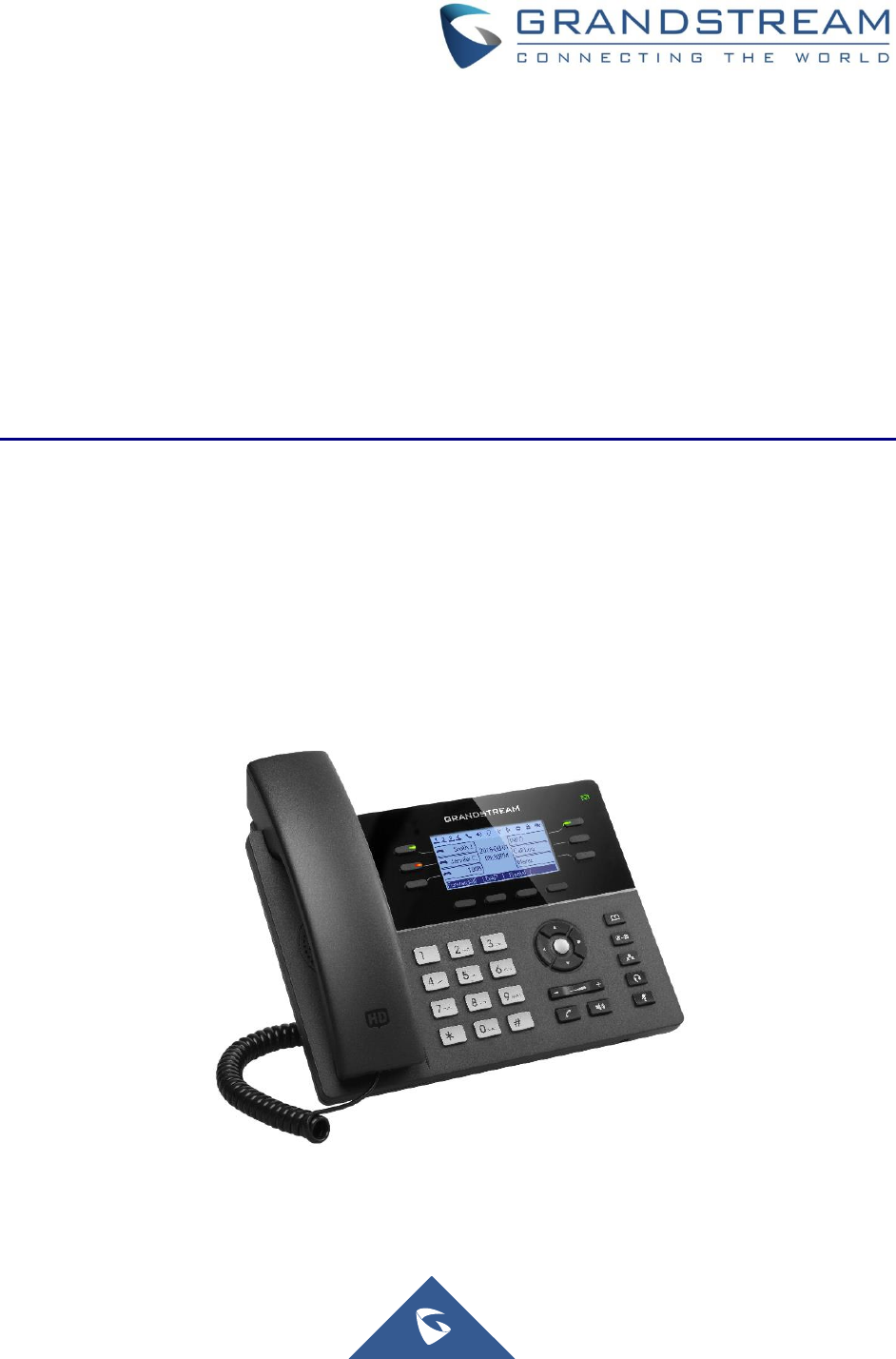
Grandstream Networks, Inc.
GXP1760W
Administration Guide
Product name:IP phone
Model name:GXP1760W
Brand name:Grandstream

GXP1760W Administration Guide
P a g e | 1
COPYRIGHT
©2017 Grandstream Networks, Inc. http://www.grandstream.com
All rights reserved. Information in this document is subject to change without notice. Reproduction or
transmittal of the entire or any part, in any form or by any means, electronic or print, for any purpose without
the express written permission of Grandstream Networks, Inc. is not permitted.
The latest electronic version of this guide is available for download here:
http://www.grandstream.com/support
Grandstream is a registered trademark and Grandstream logo is trademark of Grandstream Networks, Inc.
in the United States, Europe and other countries.
CAUTION
Changes or modifications to this product not expressly approved by Grandstream, or operation of this
product in any way other than as detailed by this guide, could void your manufacturer warranty.
WARNING
Please do not use a different power adaptor with devices as it may cause damage to the products and void
the manufacturer warranty.

GXP1760W Administration Guide
P a g e | 2
GNU GPL INFORMATION
GXP1760W firmware contains third-party software licensed under the GNU General Public License (GPL).
Grandstream uses software under the specific terms of the GPL. Please see the GNU General Public
License (GPL) for the exact terms and conditions of the license.
Grandstream GNU GPL related source code can be downloaded from Grandstream web site from:
http://www.grandstream.com/support/faq/gnu-general-public-license/gnu-gpl-information-download

GXP1760W Administration Guide
P a g e | 3
Table of Contents
CHANGE LOG ................................................................................................................ 6
Firmware Version 1.0.0.93 ..................................................................................................................... 6
GUI INTERFACE EXAMPLES ........................................................................................ 7
WELCOME ..................................................................................................................... 8
PRODUCT OVERVIEW .................................................................................................. 9
Feature Highlights .................................................................................................................................. 9
GXP1760W Technical Specifications ................................................................................................... 10
CONFIGURATION GUIDE ............................................................................................ 12
Configuration via Keypad ..................................................................................................................... 12
Configuration via Web Browser ........................................................................................................... 18
Definitions ............................................................................................................................................ 19
Status Page Definitions ................................................................................................................ 19
Accounts Page Definitions ............................................................................................................ 20
Settings Page Definitions ............................................................................................................. 31
Network Page Definitions ............................................................................................................. 42
Maintenance Page Definitions ...................................................................................................... 44
Phonebook Page Definitions ........................................................................................................ 48
Connecting the GXP1760W to WiFi .................................................................................................... 51
Using the WebGUI ........................................................................................................................ 51
Using the Keypad Menu ............................................................................................................... 52
NAT Settings ........................................................................................................................................ 52
Editing Contacts and Click-To-Dial ...................................................................................................... 53
Saving Configuration Changes ............................................................................................................ 54
Rebooting from Remote Locations ...................................................................................................... 54
Packet Capture .................................................................................................................................... 54
Multicast Paging ................................................................................................................................... 55

GXP1760W Administration Guide
P a g e | 4
Configuring Eventlist BLF .................................................................................................................... 55
Configuring VPK Keys ......................................................................................................................... 55
Outbound Notification Support ............................................................................................................. 55
UPGRADING AND PROVISIONING ............................................................................ 59
Upgrade via Keypad Menu .................................................................................................................. 59
Upgrade via Web GUI .......................................................................................................................... 59
No Local TFTP/HTTP Servers ............................................................................................................. 60
Configuration File Download ................................................................................................................ 61
RESTORE FACTORY DEFAULT SETTINGS ............................................................... 62
EXPERIENCING THE GXP1760W ............................................................................... 63

GXP1760W Administration Guide
P a g e | 5
Table of Tables
Table 1: GXP1760W Features at a Glance ................................................................................................... 9
Table 2: GXP1760W Technical Specifications ............................................................................................ 10
Table 3: Configuration Menu ....................................................................................................................... 12
Table 4: Status Page Definitions ................................................................................................................. 19
Table 5: Account Page Definitions .............................................................................................................. 20
Table 6: Settings Page Definitions .............................................................................................................. 31
Table 7: Network Page Definitions .............................................................................................................. 42
Table 8: Maintenance Page Definitions ....................................................................................................... 44
Table 9: Phonebook Page Definitions ......................................................................................................... 48
Table 10: Action URL - Supported Events ................................................................................................... 56
Table 11: Action URL – Supported Dynamic Variables ............................................................................... 57
Table of Figures
Figure 1: Keypad MENU Configuration ....................................................................................................... 17
Figure 2: WiFi Signal Icon on the GXP1760W Main LCD Menu ................................................................. 51
Figure 3: WiFi Signal Icon on the GXP1760W Main LCD Menu ................................................................. 52
Figure 4: Web GUI - PhonebookContacts ............................................................................................... 53
Figure 5: Click-to-Dial .................................................................................................................................. 54
Figure 6: Packet Capture in Idle ................................................................................................................. 54
Figure 7: Action URL Settings Page ............................................................................................................ 56
Figure 8: Action URL Packets ..................................................................................................................... 58

GXP1760W Administration Guide
P a g e | 6
CHANGE LOG
This section documents significant changes from previous versions of administration guide for GXP1760W.
Only major new features or major document updates are listed here. Minor updates for corrections or editing
are not documented here.
Firmware Version 1.0.0.93
• This is the initial version for GXP1760W.

GXP1760W Administration Guide
P a g e | 7
GUI INTERFACE EXAMPLES
http://www.grandstream.com/sites/default/files/Resources/gxp17xx_web_gui.zip
1. Screenshots of Login Page.
2. Screenshots of Status Pages.
3. Screenshots of Accounts Pages.
4. Screenshots of Settings Pages.
5. Screenshots of Network Pages.
6. Screenshots of Maintenance Pages.
7. Screenshots of Phonebook Pages.

GXP1760W Administration Guide
P a g e | 8
WELCOME
Thank you for purchasing Grandstream GXP1760W mid-range Wifi HD IP phones. The GXP1760W is a
mid-range Wifi HD IP phone with a new sleek design and moderatecall-volume features. It comes equipped
with integrated dual-band WiFi and 6 lines, 3 SIP accounts, 6 dual-color line keys and 4 XML programmable
context sensitive soft keys on a 200 x 80 pixel back-lit LCD display screen. For added personalization the
GXP1760W features personalized ring tone/ring back tone music and integration with advanced web and
enterprise applications as well as local weather services. It’s also one of the first Grandstream phones to
come equipped with a Kensington Security Slot - one of the most popular anti-theft solutions on the market.
The GXP1760W supports the fastest possible connection speeds with dual autosensing 10/100Mbps
network ports as well as automated provisioning features with media access control. This midrange IP
phone delivers outstanding performance and design to users worldwide at a budget-friendly price point.
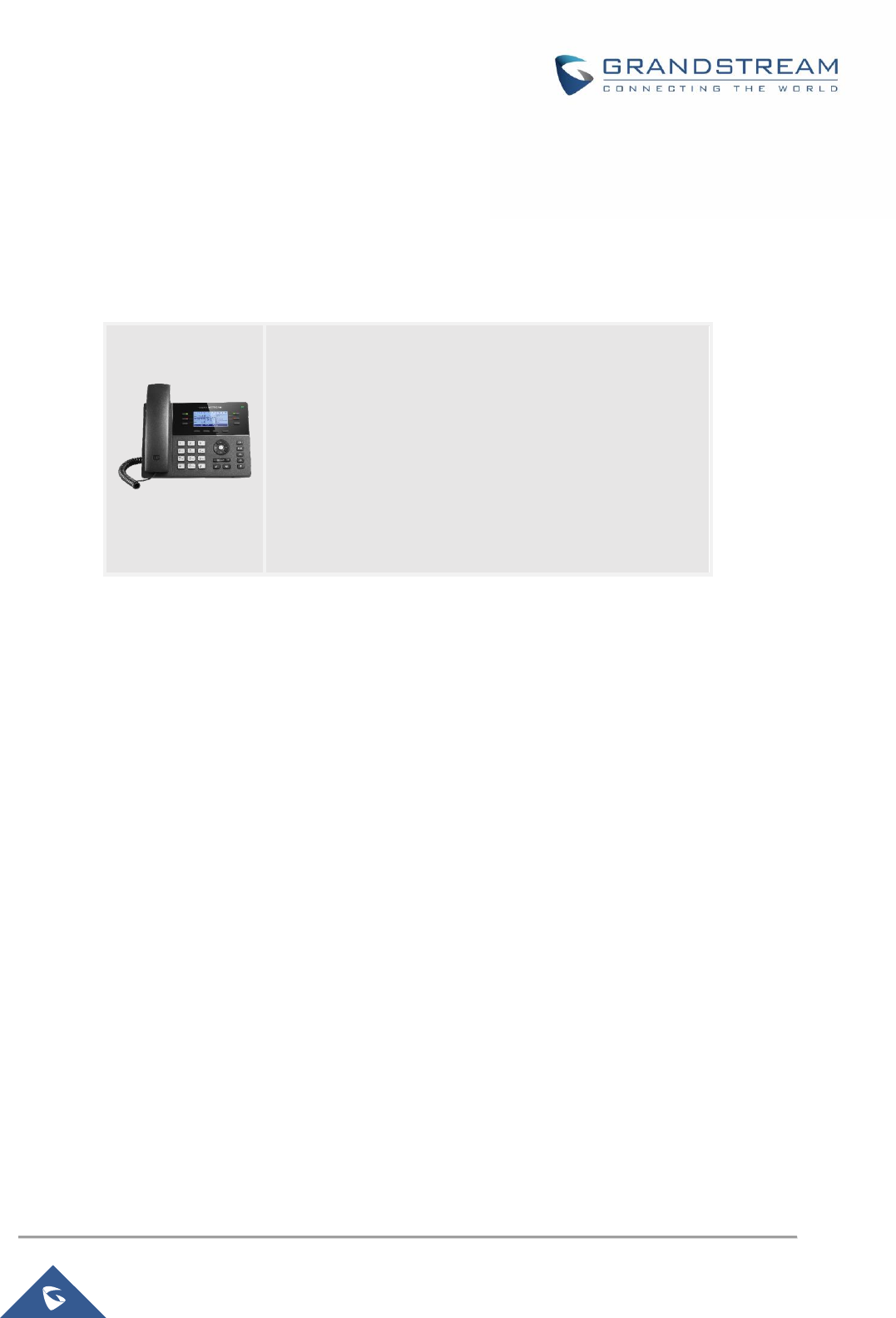
GXP1760W Administration Guide
P a g e | 9
PRODUCT OVERVIEW
Feature Highlights
The following table contains the major features of the GXP1760W:
Table 1: GXP1760W Features at a Glance
GXP1760W
6 lines
200*80-pixel backlit LCD display
4 XML programmable Softkeys
8 Dedicated function Keys
5-way conference
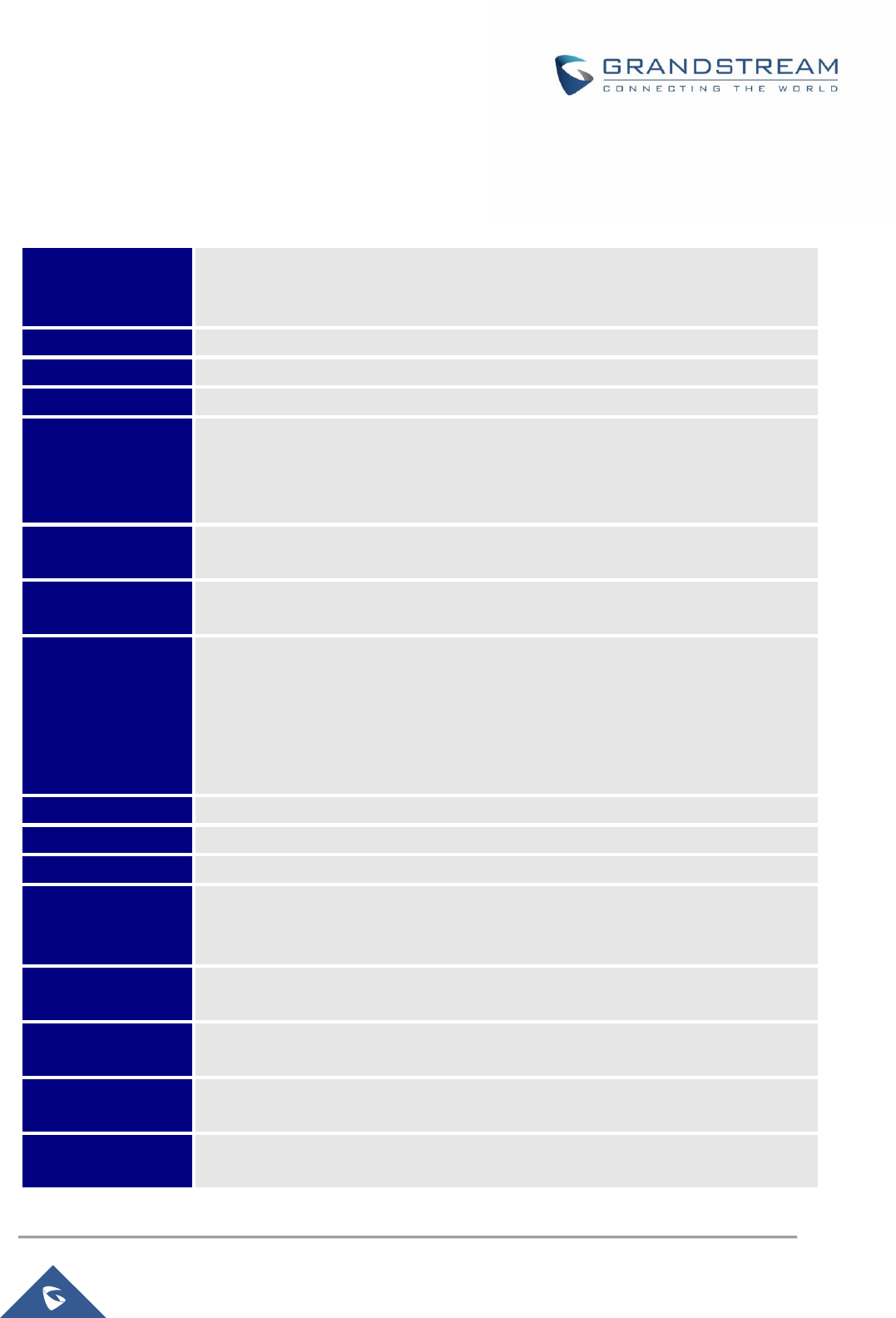
GXP1760W Administration Guide
P a g e | 10
GXP1760W Technical Specifications
The following table defines all the technical specifications including the protocols / standards supported,
voice codecs, telephony features, languages and upgrade/provisioning settings for GXP1760W.
Table 2: GXP1760W Technical Specifications
Protocols/Standards
SIP RFC3261, TCP/IP/UDP, RTP/RTCP, HTTP/HTTPS, ARP, ICMP, DNS (A record,
SRV, NAPTR), DHCP, PPPoE, TELNET, TFTP, NTP, STUN, SIMPLE, LLDP, LDAP,
TR-069, 802.1x, TLS, SRTP, IPv6.
Network Interface
Dual switched auto-sensing 10/100 Mbps Ethernet ports with integrated PoE.
WiFi
Yes, integrated dual-band WiFi 802.11 a/b/g/n/ac (2.4Ghz & 5Ghz)
Graphic Display
200*80-pixel backlit LCD display.
Features Keys
6 line keys with up to 3 SIP accounts, 4 XML programmable context sensitive
Softkeys, 5 navigation/menu keys, 8 dedicated function keys for: PHONEBOOK,
TRANSFER, CONFERENCE, HEADSET, MUTE, SEND/REDIAL,
SPEAKERPHONE, VOLUME.
Voice Codecs
Support for G.729A/B, G.711µ/a-law, G.726, G.722 (wide-band), G.723, iLBC, in-
band and out-of-band DTMF (in audio, RFC2833, SIP INFO).
Auxiliary Ports
RJ9 headset jack (allowing EHS with Plantronics headsets), USB, and a separate
EHS port reserved for external EHS adapter in the future
Telephony Features
Hold, transfer, forward, 5-way conference, call park, call pickup, shared-call-
appearance (SCA) / bridged-line-appearance (BLA), downloadable phonebook
(XML, LDAP, up to 2000 items), call waiting, call log (up to 500 records), XML
customization of screen, off-hook auto dial, auto answer, click-to-dial, flexible dial
plan, Hot Desking, personalized music ringtones and music on hold, server
redundancy and fail-over.
HD Audio
Yes, HD handset and speakerphone with support for wideband audio.
Base Stand
Yes, 2 angle positions available. Wall Mount stand sold separately.
QoS
Layer 2 QoS (802.1Q, 802.1P) and Layer 3 (ToS, DiffServ, MPLS) QoS.
Security
User and administrator level passwords, MD5 and MD5-sess based authentication,
256-bit AES encrypted configuration file, SRTP, TLS, 802.1x media access control,
Kensington Security Slot (Kensington Lock) support
Multi-Language
English, German, Italian, French, Spanish, Portuguese, Russian, Croatian,
Chinese, Korean, Japanese
Upgrade/Provisioning
Firmware upgrade via TFTP / HTTP / HTTPS, mass provisioning using TR-069 or
AES encrypted XML configuration file.
Power & Green
Energy Efficiency
Universal power adapter included, Input: 100-240V, Output +5V, 1A.
Integrated Power-over-Ethernet (802.3af). Max power consumption: 5W.
Physical
Dimension: 231mm(W) x 167mm(L) x 86mm(H).
Unit weight: 0.925kg.

GXP1760W Administration Guide
P a g e | 11
Package weight: 1.55kg.
Temperature and
Humidity
Operation: 0°C to 40°C.
Storage: -10°C to 60°C.
Humidity: 10% to 90% Non-condensing.
Package Content
GXP1760W phone, handset with cord, base stand, universal power supply, network
cable, Quick Installation Guide, GPL license.
Compliance
FCC: Part 15 (CFR 47) Class B.
CE: EN55022 Class B, EN55024 Class B, EN61000-3-2, EN61000-3-3, EN60950-1.
RCM: AS/ACIF S004, AS/NZS CISPR22/24, AS/NZS 60950.1

GXP1760W Administration Guide
P a g e | 12
CONFIGURATION GUIDE
The GXP1760W can be configured via two ways:
• LCD Configuration Menu using the phone's keypad.
• Web GUI embedded on the phone using PC's web browser.
Configuration via Keypad
To configure the LCD menu using phone's keypad, follow the instructions below:
• Enter MENU options: When the phone is in idle, press the round MENU button to enter the
configuration menu.
• Navigate in the menu options: Press the arrow keys up/down/left/right to navigate in the menu options.
• Enter/Confirm selection: Press the round MENU button or “Select” softkey to enter the selected option.
• Back: Press “Back” softkey to exit to the previous menu.
• Return to Home page: In any menu, press “Back” softkey to return to idle screen.
Note: The phone automatically exits MENU mode in these situations: An incoming call, when the phone is
off hook or the MENU mode if left idle for more than 60 seconds.
The MENU options are listed in the following table.
Table 3: Configuration Menu
Call History
Call History sub menu includes the following options:
• Local Call Log.
Displays answered calls/dialed calls/missed calls/transferred calls.
Press “Clear All” to clear all local call history.
• Broadsoft Call Log.
Displays Broadsoft call logs.
Status
Status sub menu includes the following options:
• Network status.
Displays the MAC address, IP information (DHCP/Static IP/PPPoE), IPv4
address, IPv6 address, Subnet Mask, Gateway and DNS server.
• Account status.
Shows the registration status of each account.
• System Status
Displays the hardware version, part number, software version, IP geographic
information and special features.
Phone Book
Phone Book sub menu includes the following options:

GXP1760W Administration Guide
P a g e | 13
• Local Phonebook
• Local Group
• Broadsoft Phonebook
• LDAP Directory
User may configure phonebooks/groups/LDAP options here, transfer phonebook
XML to the phone, and search phonebook/LDAP directory.
Messages
Message sub menu include the following options:
• Instant Messages
Displays or clears all received instant messages.
• Voice Mails
Displays voicemail message information in the format below: new
messages/all messages (urgent messages/all urgent messages).
Preference
Preference sub menu includes the following options:
• Do Not Disturb
Enables/disables Do Not Disturb on the phone.
• Ring Tone
Configures different ring tones for incoming call.
• Ring Volume
Adjusts ring volume by pressing left/right arrow key.
• LCD Contrast
Adjusts active LCD contrast by pressing left/right arrow key.
• LCD Brightness
Adjusts LCD brightness of idle state and active state by pressing left/right
arrow key.
• Download SCR XML
Triggers the phone to download the XML idle screen file immediately. The
XML idle screen server path and downloading method need to be set up
correctly from Web GUI first.
• Erase Custom SCR
Erases custom XML idle screen previously loaded on the phone. After
erasing it, the phone will show default idle screen.
• Display Language
Selects the language to be displayed on the phone's LCD. Users may select
“Automatic” for local language based on IP location if available. By default, it
is Auto.

GXP1760W Administration Guide
P a g e | 14
• Date Time
Configures time zone, date and time display format and NTP server on the
phone.
• Security
Configures the available security settings (Config via keypad menu, web
access mode, disable SSH).
• Headset Type
Selects headset types.
• Star Key Lock
Turns on/off keypad lock feature and configures keypad lock password. The
default keypad lock password is null. If user enabled Star Key Lock without
configuring password, user can unlock keypad by holding * key 4 seconds
and pressing “OK” button.
Direct IP Call
Makes direct IP call.
Phone
Phone sub menu includes the following options:
• SIP
Configures SIP Proxy, Outbound Proxy, SIP User ID, SIP Auth ID, SIP
Password, SIP Transport and Audio information to register SIP account on
the phone.
• Call Features
Configures call forward features for Forward All, Forward Busy, Forward No
Answer and No Answer Timeout.
System
System sub menu includes the following options:
• Network
o Internet Protocol
Selects “Prefer IPv4” or “IPv6”.
o IPv4 Settings
Selects IP mode (DHCP/Static IP/PPPoE).
o DHCP Settings
Configures “Host Name (Option 12)” and “Vendor Class ID (Option 60)”.
o PPPoE Settings
Configures PPPoE account ID and password.
o Static IP Settings
Configures static IP address, Netmask, Gateway, DNS Server 1 and
DNS Server 2.

GXP1760W Administration Guide
P a g e | 15
o 802.1X
Enables/Disables 802.1X mode, Configures 802.1x identity and MD5
password.
o Layer 2 QoS
Configures LAN port 802.1Q/VLAN Tag and priority value. Select “Reset
Vlan Config” to reset VLAN configuration on the LAN port.
o PC Port Mode
Selects PC port mode (Enabled/Disabled/Mirrored). Configures PC port
802.1Q/VLAN Tag and priority value.
o OpenVPN® Settings
Enable/Disable OpenVPN®, configure OpenVPN® server and port.
o IPv6 Settings
Selects IPv6 mode, Auto-configured or Statically configured (Full Static
/ Prefix Static).
o WiFi Settings
Enables WiFi and configure WiFi settings to connect to WiFi networks.
• Upgrade
o Firmware Server
Configures firmware server for upgrading the phone.
o Config Server
Configures config server for provisioning the phone.
o Config Upgrade Via
Allows users to choose the provisioning method: TFTP, HTTP or HTTPS
for configuration file download.
o Firmware upgrade via
Allows users to choose the firmware upgrade method: TFTP, HTTP or
HTTPS for firmware file download.
• UCM Detect
Detect/connect UCM server to process auto-provision. Manually input
the IP and port of the UCM server phone wants to bind with, or select
from the available UCM server in network.
• Factory Functions
o Audio Loopback
Speak to the phone using speaker/handset/headset. If you can hear
your voice, your audio is working fine. Press “Exit” softkey to exit audio
loopback mode.

GXP1760W Administration Guide
P a g e | 16
o Diagnostic Mode
All LEDs will light up. Toggle the line keys LED color to green with “#”
and to red with “*”. Press any key on the phone to diagnose the key’s
function. The key’s name will display on the LCD. Press the menu button
or onhook/offhook handset to exit the diagnostic mode.
o Keyboard Diagnostic
All keys’ names will display on LCD screen before diagnosing. Press
each key on the phone to remove it from the list of remaining keys to be
diagnosed. Lift and put back the handset to exit diagnostic mode after
all keys have been diagnosed.
o Certificate Verification
This is used to validate certificate chain for the server’s certificate.
• Factory Reset
It is used to restore the phone to factory default settings.
Reboot
Reboots the phone.
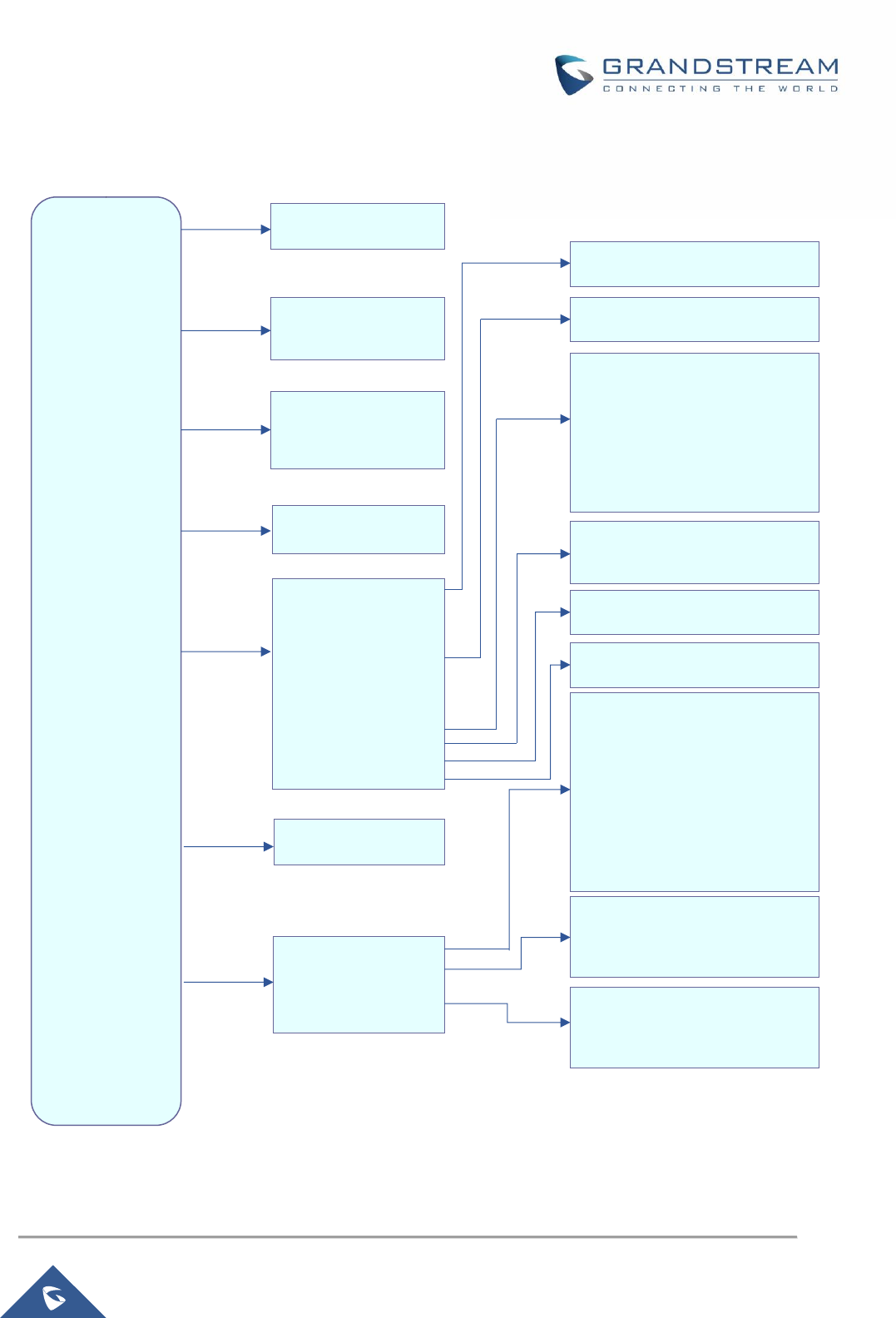
GXP1760W Administration Guide
P a g e | 17
The following diagram shows the keypad MENU configuration flow:
Figure 1: Keypad MENU Configuration
Call History
Status
Phone Book
Messages
Preference
Direct IP Call
Phone
System
Reboot
Network Status
Account Status
System Status
SIP
Call Features
Network
Upgrade
UCM Detect
Factory Functions
Factory Reset
Local Phonebook
Local Group
Broadsoft Phonebook
LDAP Directory
Do Not Disturb
Ring Tone
Ring Volume
LCD Contrast
LCD Brightness
Download SCR XML
Erase Custom SCR
Display Language
Date and Time
Security
Headset Type
Star key Lock
Instant Messages
Voice Mails
NTP Server
DHCP Option42 overrides NTP
Time Zone
DHCP Option2 overrides Time Zone
Self-Defined Time Zone
Date Display Format
Time Display Format
Set Current Time Manually
Config via Keypad Menu
Web Access Mode
Disable SSH
Firmware Server
Config Server
Config Upgrade Via
Firmware Upgrade via
Internet Protocol
IPv4 settings
DHCP settings
PPPoE Settings
Static IP Settings
802.1x
Layer 2 QoS
PC Port Settings
OpenVPN®
IPv6 settings
WiFi settings
Audio Loopback
Diagnostic Mode
Keyboard Diagnostic
Certificate Verification
Local Call Log
Broadsoft Call Log
Enable/Disable
Password
Normal
Plantronics EHS
Active
Idle
Enable DND
Disable DND
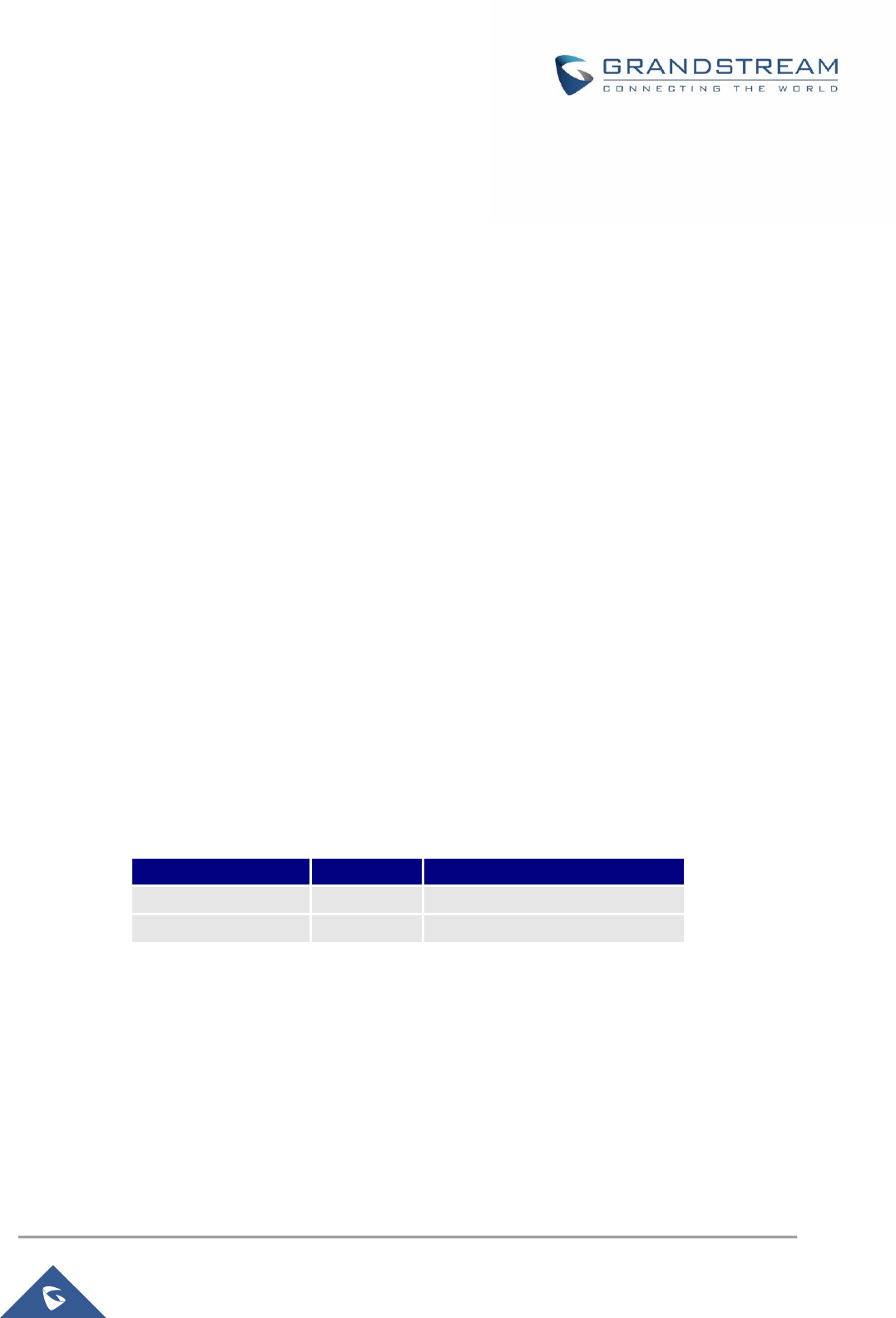
GXP1760W Administration Guide
P a g e | 18
Configuration via Web Browser
The GXP1760W embedded Web server responds to HTTP/HTTPS GET/POST requests. Embedded HTML
pages allow a user to configure the IP phone through a Web browser such as Google Chrome, Mozilla
Firefox and Microsoft’s IE.
To access the Web GUI:
1. Connect the computer to the same network as the phone.
2. Make sure the phone is turned on and shows its IP address. You may check the IP address by pressing
up arrow button when phone is at idle state.
3. Open a Web browser on your computer.
4. Enter the phone’s IP address in the address bar of the browser.
5. Enter the administrator’s login and password to access the Web Configuration Menu.
Notes:
• The computer has to be connected to the same sub-network as the phone. This can be easily done by
connecting the computer to the same hub or switch as the phone connected to. In absence of a
hub/switch (or free ports on the hub/switch), please connect the computer directly to the PC port on the
back of the phone.
• If the phone is properly connected to a working Internet connection, the IP address of the phone will
display in MENUStatusNetwork Status. This address has the format: xxx.xxx.xxx.xxx, where xxx
stands for a number from 0-255. Users will need this number to access the Web GUI. For example, if
the phone has IP address 192.168.40.154, please enter "http://192.168.40.154" in the address bar of
the browser.
• There are two default passwords for the login page:
User Level
Password
Web Pages Allowed
End User Level
123
Only Status and Maintenance
Administrator Level
admin
All pages
The password is case sensitive with maximum length of 25 characters.
• When changing any settings, always SUBMIT them by pressing the "Save" or "Save and Apply" button
on the bottom of the page. If the change is saved only but not applied, after making all the changes,
click on the "APPLY" button on top of the page to submit. After submitting the changes in all the Web
GUI pages, reboot the phone to have the changes take effect if necessary (All the options under
"Accounts" page and "Phonebook" page do not require reboot. Most of the options under "Settings"
page do not require reboot).
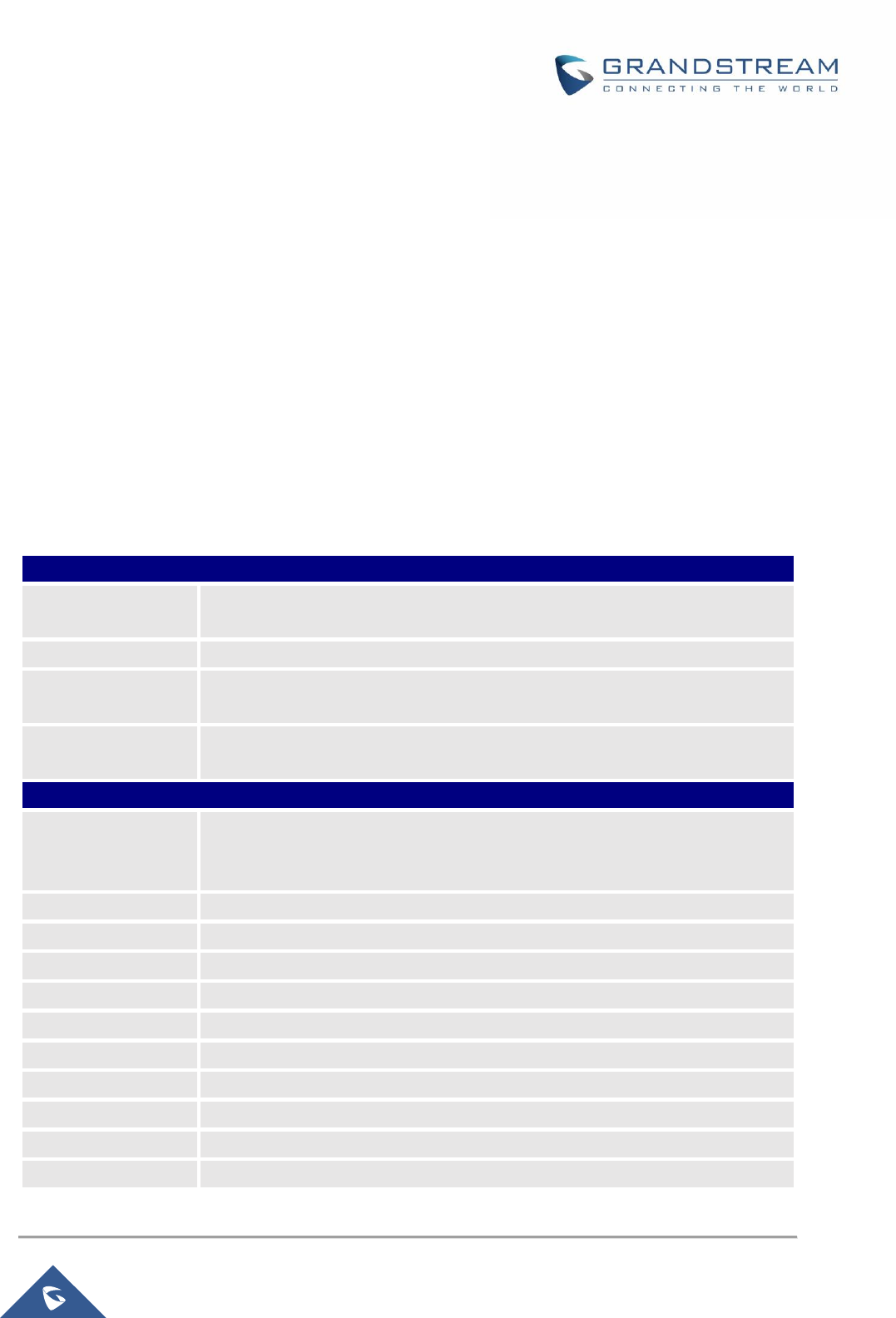
GXP1760W Administration Guide
P a g e | 19
Definitions
This section describes the options in the phone's Web GUI. As mentioned, you can log in as an
administrator or an end user.
• Status: Displays the Account status, Network status, and System Info of the phone.
• Account: To configure the SIP account.
• Settings: To configure call features, ring tone, audio control, LCD display, date and time, Web services,
XML applications, programmable keys, etc.
• Network: To configure network and WiFi settings.
• Maintenance: To configure web access, upgrading and provisioning, syslog, language settings, TR-
069, security, etc.
• Phonebook: To manage Phonebook and LDAP.
Status Page Definitions
Table 4: Status Page Definitions
Status Account Status
Account
Account index.
For GXP1760W: up to 3 SIP accounts.
SIP User ID
Displays the configured SIP User ID for the account.
SIP Server
Displays the configured SIP Server address, URL or IP address, and port of the
SIP server.
SIP Registration
Displays SIP registration status for the SIP account, it will display Yes/No with
Green/Red background.
Status Network Status
MAC Address
Global unique ID of device, in HEX format. The MAC address will be used for
provisioning and can be found on the label coming with original box and on the
label located on the back of the device.
IP Setting
Configured address type: DHCP, Static IP or PPPoE.
IPv4 Address
Displays the IPv4 address obtained on the phone.
IPv6 Address
Displays the IPv6 address obtained on the phone.
OpenVPN® IP
The OpenVPN® IP obtained on the phone.
Subnet Mask
Displays the subnet mask obtained on the phone.
Gateway
Displays the gateway address obtained on the phone.
DNS Server 1
Displays the DNS server address 1 obtained on the phone.
DNS Server 2
Displays the DNS server address 2 obtained on the phone.
PPPoE Link Up
PPPoE connection status.
NAT Type
Displays the type of NAT connection used by the phone.
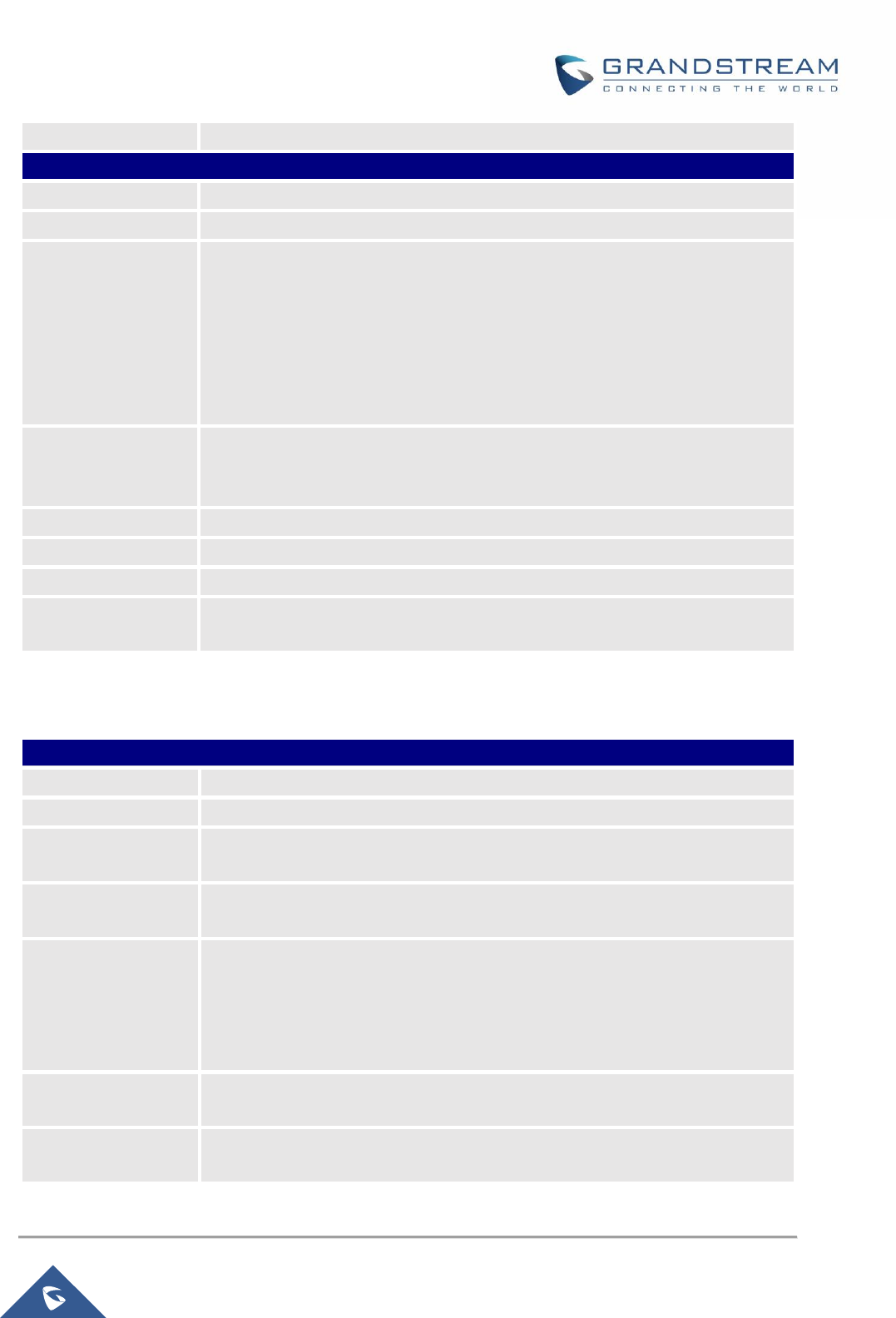
GXP1760W Administration Guide
P a g e | 20
NAT Traversal
Displays the status of NAT connection for each account on the phone.
Status System Info
Product Model
Product model of the phone.
Part Number
Product part number.
Software Version
• Boot: boot version number.
• Core: core version number.
• Base: base version number.
• Prog: program version number. This is the main firmware release number,
which is always used for identifying the software system of the phone.
• Locale: locale version number.
• Recovery: recovery version number.
IP Geographic
Information
• City: displaying city.
• Language: displaying language.
• Time Zone: displaying time zone.
System Up Time
System up time since the last reboot.
System Time
Current system time on the phone system.
Service Status
GUI and Phone service status.
Core Dump
Displays the core dump file when available and which could be downloaded for
troubleshooting purpose.
Accounts Page Definitions
Table 5: Account Page Definitions
Account x General Settings
Account Active
Indicates whether the account is active. The default setting is "Yes".
Account Name
Configures name associated with each account to be displayed on the LCD.
SIP Server
Specifies the URL or IP address, and port of the SIP server. This should be
provided by VoIP service providers (ITSP).
Secondary SIP
Server
Specifies the URL or IP address, and port of the SIP server. This will be used
when the primary SIP server fails.
Outbound Proxy
Configures the IP address or the domain name of the primary outbound proxy,
media gateway or session border controller. It's used by the phone for firewall
or NAT penetration in different network environments. If a symmetric NAT is
detected, STUN will not work and only an outbound proxy can provide a
solution.
Backup Outbound
Proxy
Configures secondary outbound proxy which will be used when the primary
proxy cannot be connected.
BLF Server
Configures the optional server used for SUBSCRIBE requests to indicate other
extensions status on the SIP server.
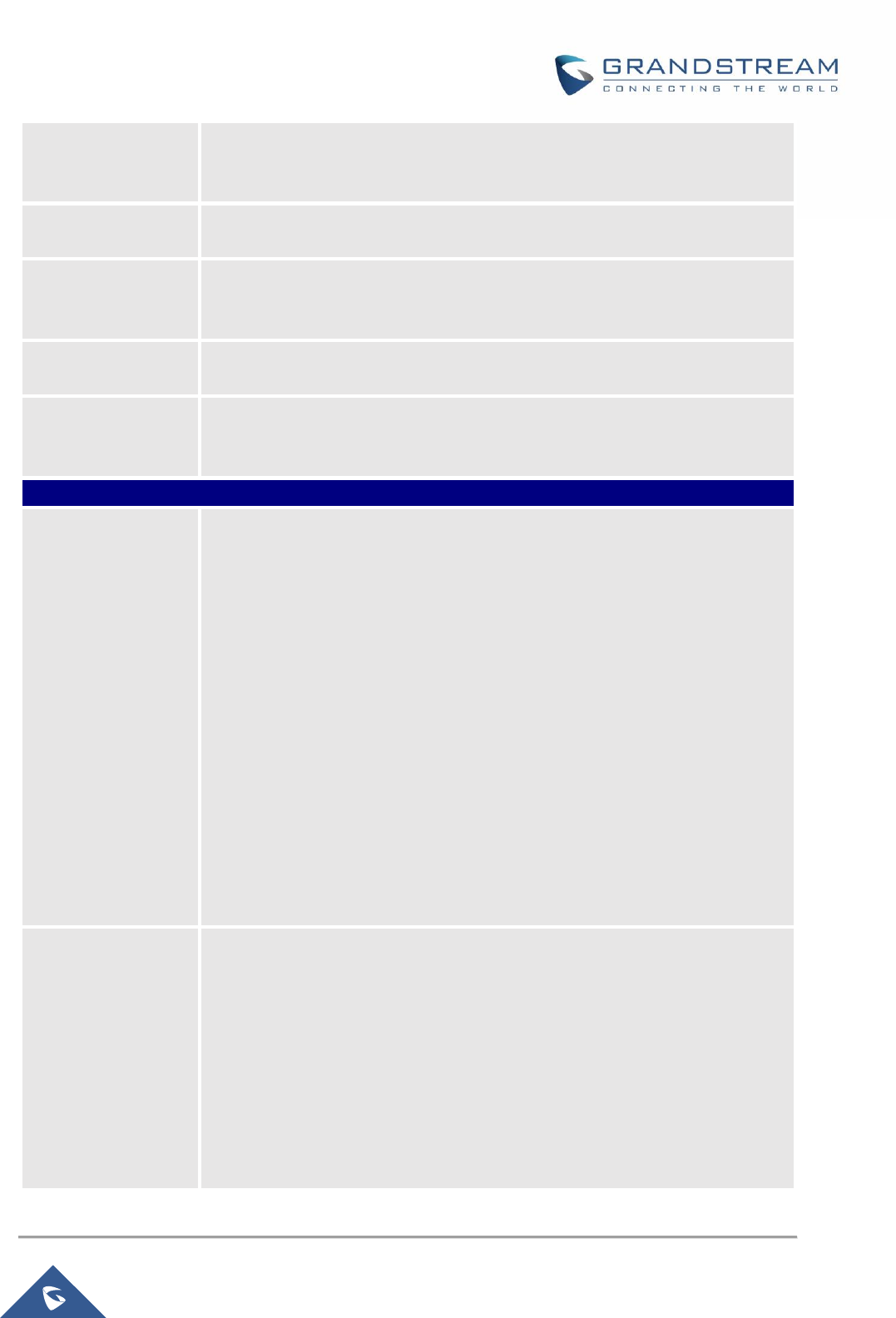
GXP1760W Administration Guide
P a g e | 21
SIP User ID
Configures user account information provided by your VoIP service provider
(ITSP). It's usually in the form of digits similar to phone number or actually a
phone number.
Authenticate ID
Configures the SIP service subscriber's Authenticate ID used for authentication.
It can be identical to or different from the SIP User ID.
Authenticate
Password
Configures the account password required for the phone to authenticate with
the ITSP (SIP) server before the account can be registered. After it is saved,
this will appear as hidden for security purpose.
Name
Specifies SIP server subscriber's name (optional) that will be used for Caller ID
display.
Voice Mail User ID
Sets if the phone system allows users to access the voice messages by
pressing the MESSAGE key on the phone. This ID is usually the VM portal
access number. For example, in UCM6XXX IPPBX, *97 could be used.
Account x Network Settings
DNS Mode
Defines which parameter will control how the Search Appliance looks up IP
addresses for hostnames. There are four modes: A Record, SRV,
NATPTR/SRV, Use Configured IP. The default setting is "A Record". If the user
wishes to locate the server by DNS SRV, the user may select "SRV" or
"NATPTR/SRV".
If "Use Configured IP" is selected, please fill in the three fields below:
• Primary IP
• Backup IP 1
• Backup IP 2
If SIP server is configured as domain name, phone will not send DNS query,
but use “Primary IP” or “Backup IP x” to send SIP message if at least one of
them are not empty. Phone will try to use “Primary IP” first. After 3 tries without
any response, it will switch to “Backup IP x”, and then it will switch back to
“Primary IP” after 3 re-tries.
If SIP server is already an IP address, phone will use it directly even “User
Configured IP” is selected.
NAT Traversal
Specifies which NAT traversal mechanism will be enabled on the phone system.
Users could select the mechanism from No, STUN, Keep-alive, UPnP, Auto or
VPN. The default setting is "No".
If set to "STUN" and STUN server is configured, the phone will route according
to the STUN server. If NAT type is Full Cone, Restricted Cone or Port-Restricted
Cone, the phone will try to use public IP addresses and port number in all SIP
& SDP messages. The phone will send empty SDP packet to the SIP server
periodically to keep the NAT port open if it is configured to be "Keep-alive".
Configure this to be "No" if an outbound proxy is used. "STUN" cannot be used
if the detected NAT is symmetric NAT. Set this to "VPN" if OpenVPN® is used.

GXP1760W Administration Guide
P a g e | 22
Proxy-Require
Determines a SIP Extension to notify the SIP server that the phone is behind a
NAT/Firewall. Do not configure this parameter unless this feature is supported
on the SIP server.
Account x SIP Settings Basic Settings
TEL URI
Determines if the phone has an assigned PSTN telephone number. This field
should be set to "User=Phone", so that "User=Phone" parameter will be
attached to the Request-Line and "TO" header in the SIP request to indicate the
E.164 number. If set to "Enable", "Tel:" will be used instead of "SIP:" in the SIP
request. The default setting is "Disable".
SIP Registration
Selects whether or not the phone will send SIP Register messages to the
proxy/server. The default setting is "Yes".
Unregister On
Reboot
Allows the SIP user's registration information to be cleared when the phone
reboots. The SIP REGISTER message will contain “Expires: 0” to unbind the
connection. Three options are available:
• If set to "All", the SIP user's registration information will be cleared when
the phone reboots. The SIP Contact header will contain "*" to notify the
server to unbind the connection.
• If set to "Instance", the SIP user will be unregistered on current phone
only.
• If set to “No”, the phone will not unregister the SIP account when rebooting.
The default setting is "No".
Register Expiration
Specifies the time interval (in minutes) in which the phone refreshes its
registration with the specified registrar. The default value is 60 minutes. The
maximum value is 64800 minutes (about 45 days).
Reregister Before
Expiration
Specifies the time interval (in seconds) that the phone sends re-registration
request before the Register Expiration.
The default value is 0.
Enable OPTIONS
Keep Alive
Select whether or not the phone will keep sending a message to check the
connection with the server.
OPTIONS Keep
Alive Interval
Specifies the time interval (in second) in which the phone will send the Keep
Alive message to the server.
OPTIONS Keep
Alive Max Lost
Specifies the maximum number of allowed lost packet before the phone will
refresh its registration.
Local SIP Port
Defines the local SIP port used to listen and transmit. The default value is 5060
for Account 1, 5062 for Account 2, 5064 for Account 3, 5066 for Account 4. The
valid range is from 1 to 65535.
SIP Registration
Failure Retry Wait
Time
Specifies the time interval to retry registration if the process is failed. The valid
range is 1 to 3600. The default value is 20 seconds.

GXP1760W Administration Guide
P a g e | 23
SIP T1 Timeout
SIP T1 Timeout is an estimate of the round-trip time of transactions between a
client and server. If no response is received the timeout is increased, and
request re-transmit retries would continue until a maximum amount of time
define by T2. The default setting is 0.5 seconds.
SIP T2 Timeout
SIP T2 Timeout is the maximum retransmit time of any SIP request messages
(excluding the INVITE message). The re-transmitting and doubling of T1
continues until it reaches the T2 value. The default setting is 4 seconds.
SIP Transport
Determines the network protocol used for the SIP transport. Users can choose
from TCP, UDP and TLS. The default setting is “UDP”.
SIP URI Scheme
when using TLS
Specifies if "sip" or "sips" will be used when TLS/TCP is selected for SIP
Transport. The default setting is "sips".
Use Actual
Ephemeral Port in
Contact with
TCP/TLS
This option is used to control the port information in the Via header and Contact
header. If set to No, these port numbers will use the permanent listening port
on the phone. Otherwise, they will use the ephemeral port for the particular
connection. The default setting is “No”.
Outbound Proxy
Mode
Configures which mode will be placed in route header in sending SIP messages
or to be always sent to the outbound proxy.
Support SIP
Instance ID
Defines whether SIP Instance ID is supported or not. Default setting is “Yes”.
SUBSCRIBE for
MWI
When set to “Yes”, a SUBSCRIBE for Message Waiting Indication will be sent
periodically. The phone supports synchronized and non-synchronized MWI.
The default setting is “No”.
SUBSCRIBE for
Registration
When set to “Yes”, a SUBSCRIBE for Registration will be sent out periodically.
The default setting is “No”.
Enable 100rel
The use of the PRACK (Provisional Acknowledgment) method enables
reliability to SIP provisional responses (1xx series). This is very important in
order to support PSTN internetworking. To invoke a reliable provisional
response, the 100rel tag is appended to the value of the required header of the
initial signaling messages. The default setting is “No”.
Caller ID Display
When set to “Auto”, the phone will look for the caller ID in the order of P-
Asserted Identity Header, Remote-Party-ID Header and From Header in the
incoming SIP INVITE.
When set to “Disabled”, all incoming calls are displayed with “Unavailable”.
When set to “From Header”, the phone will display the caller ID based on the
From Header in the incoming SIP INVITE. The default setting is “Auto”.
Use Privacy Header
Controls whether the Privacy header will be present in the SIP INVITE message
and if the header will contain the caller info.
When set to “Default”, the Privacy Header will be shown on the INVITE only
when “Huawei IMS” special feature is on.
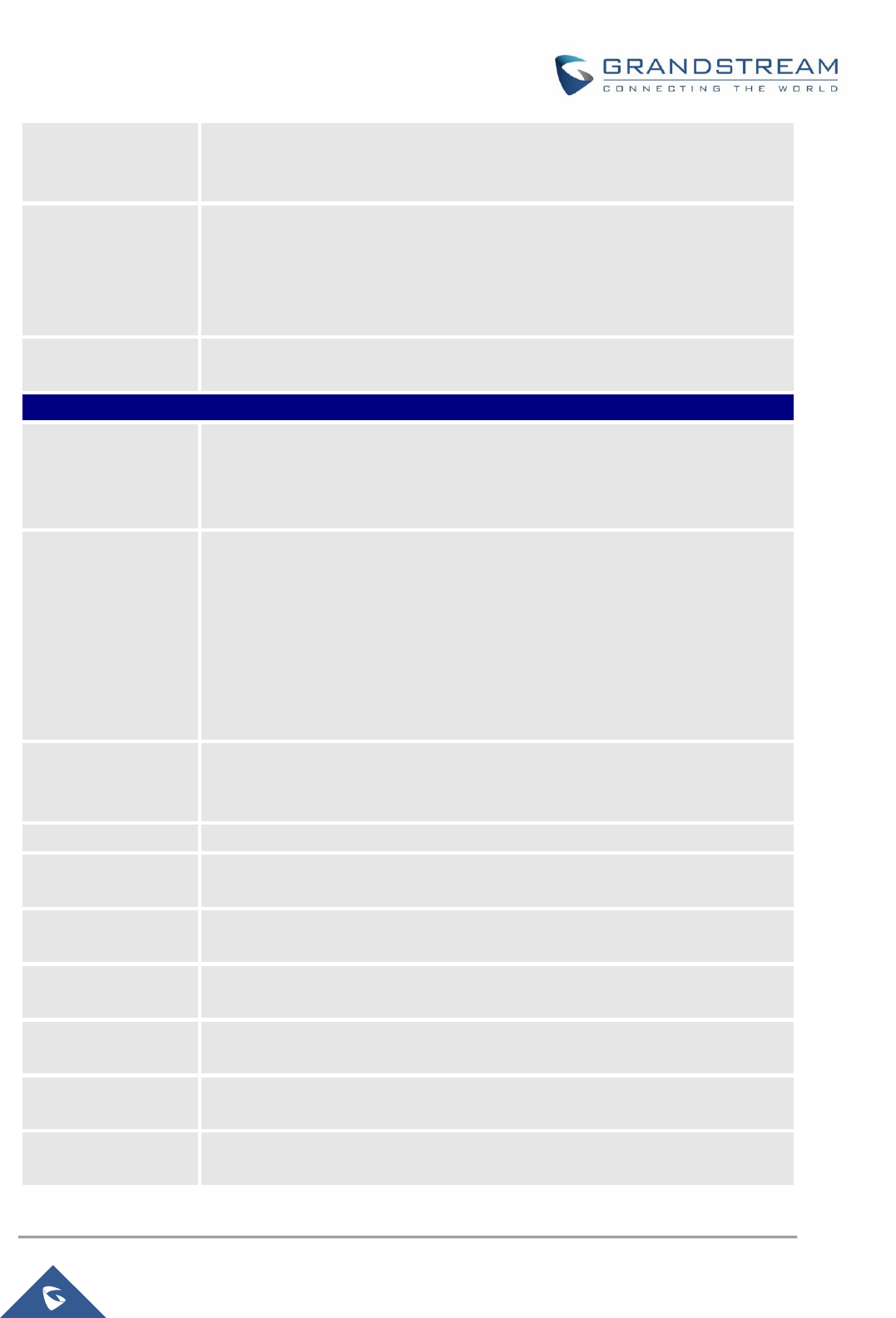
GXP1760W Administration Guide
P a g e | 24
If set to “Yes”, the Privacy Header will always be shown on the INVITE.
If set to “No”, the Privacy Header won’t be shown on the INVITE. Default setting
is “Default”.
Use P-Preferred-
Identity Header
Controls whether the P-Preferred-Identity Header will present in the SIP INVITE
message. The default setting is “default”. The P-Preferred-Identity Header will
show in INVITE unless “Huawei IMS” special feature is on.
If set to “Yes”, the P-Preferred-Identity Header will always show in INVITE.
If set to “No”, the P-Preferred-Identity Header will not show in INVITE.
Ignore Alert-Info
Header
Selects whether default ringtone will be played by ignoring alert-info header.
Account x SIP Settings Advanced Features
Line Seize Timeout
For Shared Call Appearance, phone must send a SUBSCRIBE-request for the
line-seize event package whenever a user attempts to take the shared line off
hook. “Line Seize Timeout” is the line-seize event expiration timer. The default
value is 15 seconds. The valid range is from 15 to 60.
Eventlist BLF URI
Configures the Eventlist BLF URI on the phone to monitor the extensions in the
list with Multi-Purpose Key. If the server supports this feature, users need to
configure an Eventlist BLF URI on the service side first (i.e.,
BLF1006@myserver.com) with a list of extensions included. On the phone, in
this "Eventlist BLF URI" field, fill in the URI without the domain (i.e., BLF1006).
To monitor the extensions in the list, under Web
GUISettingsProgrammable Keys page, please select "Eventlist BLF" in the
key mode, choose account, enter the value of each extension in the list.
Auto Provision
Eventlist BLFs
When option is enabled, empty multi-purpose keys will be automatically
provisioned to the monitored extensions in the Eventlist BLF. The default setting
is “Disabled”.
Conference URI
Configures Conference URI for N-way conference (Broadsoft Standard).
Music On Hold URI
Configures Music On Hold URI to call when a call is on hold. This feature has
to be supported on the server side.
Force BLF Call-
pickup by prefix
Configures to always use the prefix for BLF Call-pickup. The default setting is
“No”.
BLF Call-pickup
Prefix
Configures the prefix prepended to the BLF extension when the phone picks up
a call with BLF key. The default setting is **.
Call Pickup Barge-
In Code
Set Feature Access Code of Call Pickup with Barge-In feature.
PUBLISH for
Presence
Enables presence feature on the phone. The default setting is "No".
Omit charset=UTF-8
in MESSAGE
Omit charset=UTF-8 in MESSAGE content-type.

GXP1760W Administration Guide
P a g e | 25
Special Feature
Different soft switch vendors have special requirements. Therefore, users may
need select special features to meet these requirements. Users can choose
from Standard, Nortel MCS, Broadsoft, CBCOM, RNK, Sylantro, Huawei IMS
and PhonePower depending on the server type. The default setting is
"Standard".
Broadsoft Call
Center
Default setting is "No". When set to "Yes", a softkey “BSCCenter” is displayed
on LCD. User can access different Broadsoft Call Center agent features via this
softkey. Please note that “Feature Key Synchronization” will be enabled
regardless of this setting.
Hoteling Event
Broadsoft Hoteling event feature. Default setting is "No". With “Hoteling Event”
enabled, user can access the Hoteling feature option by pressing the
“BSCCenter” softkey.
Call Center Status
When set to "Yes", the phone will send SUBSCRIBE to the server to obtain
call center status. The default setting is "No".
Feature Key
Synchronization
This feature is used for Broadsoft call feature synchronization. When it's
enabled, DND, Call Forward features and Call Center Agent status can be
synchronized between Broadsoft server and phone. The default setting is
"Disabled".
Broadsoft Call Park
When enabled, it will send SUBSCRIBE to Broadsoft server to obtain Call Park
notifications. The default setting is “Disabled”.
Account x SIP Settings Session Timer
Enable Session
Timer
Enable/Disable session timer support.
Session Expiration
The SIP session timer expiration (in seconds) that enables SIP sessions to be
periodically “refreshed” via a SIP request (UPDATE, or re-INVITE). If there is
no refresh via an UPDATE or re-INVITE message, the session will be
terminated once the session interval expires.
Session Expiration is the time (in seconds) where the session is considered
timed out, provided no successful session refresh transaction occurs
beforehand. The default setting is 180.
The valid range is from 90 to 64800.
Min-SE
The minimum session expiration (in seconds). The default value is 90 seconds.
The valid range is from 90 to 64800.
Caller Request
Timer
If set to “Yes” and the remote party supports session timers, the phone will use
a session timer when it makes outbound calls. The default setting is “No”.
Callee Request
Timer
If set to “Yes” and the remote party supports session timers, the phone will use
a session timer when it receives inbound calls. The default setting is “No”.
Force Timer
If Force Timer is set to “Yes”, the phone will use the session timer even if the
remote party does not support this feature.
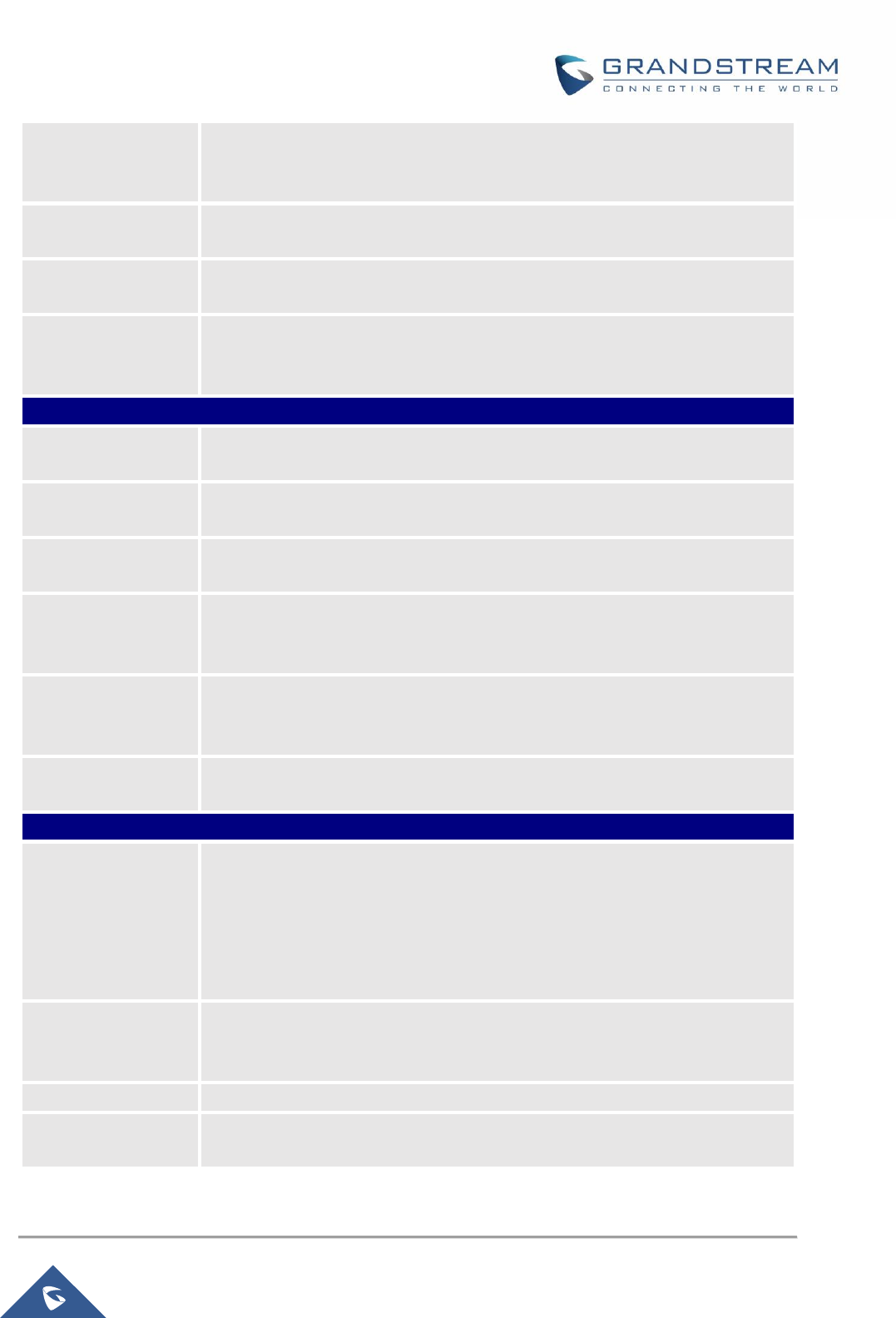
GXP1760W Administration Guide
P a g e | 26
If Force Timer is set to “No”, the phone will enable the session timer only when
the remote party supports this feature. To turn off the session timer, select “No”.
The default setting is “No”.
UAC Specify
Refresher
As a Caller, select UAC to use the phone as the refresher, or select UAS to use
the Callee or proxy server as the refresher. The default setting is “Omit”.
UAS Specify
Refresher
As a Callee, select UAC to use caller or proxy server as the refresher, or select
UAS to use the phone as the refresher. The default setting is “UAC”.
Force INVITE
The Session Timer can be refreshed using the INVITE method or the UPDATE
method. Select “Yes” to use the INVITE method to refresh the session timer.
The default setting is “No”.
Account x SIP Settings Security Settings
Check Domain
Certificates
Choose whether the domain certificates will be checked or not when TLS/TCP
is used for SIP Transport. The default setting is “No”.
Validate Certificate
Chain
Validate certification chain when TCP/TLS is configured. The default setting is
“No”.
Validate Incoming
Messages
Choose whether the incoming messages will be validated or not. The default
setting is “No”.
Check SIP User ID
for incoming INVITE
If set to “Yes”, SIP User ID will be checked in the Request URI of the incoming
INVITE. If it doesn’t match the phone’s SIP User ID, the call will be rejected.
The default setting is “No”.
Accept Incoming
SIP from Proxy Only
When set to “Yes”, the SIP address of the Request URL in the incoming SIP
message will be checked. If it doesn’t match the SIP server address of the
account, the call will be rejected. The default setting is “No”.
Authenticate
Incoming INVITE
If set to “Yes”, the phone will challenge the incoming INVITE for authentication
with SIP 401 Unauthorized response. Default setting is “No”.
Account x Audio Settings
Preferred Vocoder
Multiple vocoder types are supported on the phone, the vocoders in the list is a
higher preference. Users can configure vocoders in a preference list that is
included with the same preference order in SDP message.
Note: Using firmware version 1.0.0.43 or higher, users are now able to perform
concurrent calls using G.729 codec as well.
Use First Matching
Vocoder in 200OK
SDP
When it is set to “Yes”, the device will use the first matching vocoder in the
received 200OK SDP as the codec. The default setting is “No”.
Hide Vocoder
Enables / disables displaying the vocoder information on the call screen.
Disable Multiple m
line in SDP
When it is set to “No”, the device will reply with multiple m lines, Otherwise, it
will reply 1 m line. The default setting is “No”.

GXP1760W Administration Guide
P a g e | 27
SRTP Mode
Enable SRTP mode based on your selection from the drop-down menu.
The default setting is “Disabled”.
Crypto Life Time
Enable or disable the crypto life time when using SRTP. If users set to disable
this option, phone does not add the crypto life time to SRTP header.
The default setting is “Yes”.
Symmetric RTP
Defines whether symmetric RTP is supported or not. The default setting is “No”.
Silence
Suppression
Controls the silence suppression/VAD feature of the audio codec G.729. If set
to “Yes”, when silence is detected, a small quantity of VAD packets (instead of
audio packets) will be sent during the period of no talking. If set to “No”, this
feature is disabled. The default setting is “No”.
Jitter Buffer Type
Selects either Fixed or Adaptive for jitter buffer type, based on network
conditions. The default setting is “Adaptive”.
Jitter Buffer Length
Selects jitter buffer length from 100ms to 800ms, based on network conditions.
The default setting is “300ms”.
Voice Frames Per
TX
Configures the number of voice frames transmitted per packet. When
configuring this, it should be noted that the “ptime” value for the SDP will change
with different configurations here. This value is related to the codec used and
the actual frames transmitted in payload during the call. For end users, it is
recommended to use the default setting, as incorrect settings may influence the
audio quality. The default setting is 2.
G723 Rate
Configure encoding rate for G723.1 codec.
G.726-32 Packing
Mode
Selects "ITU" or "IETF" for G726-32 packing mode. The default setting is “ITU”.
iLBC Frame Size
Configure iLBC packet frame size.
iLBC Payload Type
Specify iLBC payload type.
Valid type is 96-127.
OPUS Payload Type
Specifies OPUS payload type. Valid range is 96 to 127. Cannot be the same as
iLBC or DTMF Payload Type.
DTMF Payload Type
Configures the payload type for DTMF using RFC2833. Cannot be the same as
iLBC or OPUS payload type
Send DTMF
This parameter specifies the mechanism to transmit DTMF digits. There are 3
supported modes: The default setting is “RFC2833”.
• In audio, which means DTMF is combined in the audio signal (not very
reliable with low-bit-rate codecs).
• RFC2833, which means to specify DTMF with RTP packet. Users could
know the packet is DTMF in the RTP header as well as the type of DTMF.
• SIP INFO, which uses SIP info to carry DTMF. The defect of this mode is
that it’s easily to cause desynchronized of DTMF and media packet for the
reason the SIP and RTP are transmitted respectively.

GXP1760W Administration Guide
P a g e | 28
Account x Call Settings
Early Dial
Selects whether or not to enable early dial. If set to "Yes", the SIP proxy must
support 484 responses. Early Dial means that the phone sends for each
pressed digit a SIP INVITE message to SIP server. SIP server looks into its
extensions and, if no match happened yet, it sends back a "484 Address
Incomplete" message. Otherwise, it executes the action. Default setting is "No".
Dial Plan Prefix
Configures the prefix to be added to each dialed number.
Dial Plan
A dial plan establishes the expected number and pattern of digits for a
telephone number. This parameter configures the allowed dial plan for the
phone. Default setting is “{ x+ | \+x+ | *x+ | *xx*x+ }”.
Dial Plan Rules:
1. Accepted Digits: 1,2,3,4,5,6,7,8,9,0 , *, #, A,a,B,b,C,c,D,d;
2. Grammar:
x – any digit from 0-9
X – digits from 0-9, and letters from a-z, A-Z.
a) xx+ - at least 2 digit numbers
b) xx - only 2 digit numbers
c) ^ - exclude
d) [3-5] - any digit of 3, 4, or 5
e) [147] - any digit of 1, 4, or 7
f) <2=011> - replace digit 2 with 011 when dialing
g) | - the OR operand
h) {X123} - match Z123, e123, 5123, …
i) Back slash “\” Character can be used to escape specific letters. e.g.
if { \p\a\r\k\+60 } dial plan is configured, park+60 should be able to pass
dial plan check. This also can be used to escape Mark and User-
unreserved characters.
Mark = "-" / "_" / "." / "!" / "~" / "*" / "'" / "(" / ")"
User-unreserved = "&" / "=" / "+" / "$" / "," / ";" / "?" / "/"
• Example 1: {[369]11 | 1617xxxxxxx}
Allow 311, 611, and 911 or any 10 digit numbers with leading digits 1617;
• Example 2: {^1900x+ | <=1617>xxxxxxx}
Block any number of leading digits 1900 or add prefix 1617 for any dialed 7 digit
numbers;
• Example 3: {1xxx[2-9]xxxxxx | <2=011>x+}
Allows any number with leading digit 1 followed by a 3 digit number, followed by
any number between 2 and 9, followed by any 7 digit number OR Allows any
length of numbers with leading digit 2, replacing the 2 with 011 when dialed.
• Example 4: If we set the dial plan with {\*123}, it should allow input *123 to
pass dial plan check.

GXP1760W Administration Guide
P a g e | 29
• Example 5: If we set the dial plan with {\$123}, it should allow input $123
to pass dial plan check.
• Example 6: If we set the dial plan with {12\_3}, it should allow input 12_3
to pass dial plan check.
Example of a simple dial plan used in a Home/Office in the US:
{ ^1900x. | <=1617>[2-9]xxxxxx | 1[2-9]xx[2-9]xxxxxx | 011[2-9]x. | [3469]11 }
Explanation of example rule (reading from left to right):
• ^1900x. - prevents dialing any number started with 1900;
• <=1617>[2-9]xxxxxx - allows dialing to local area code (617) numbers by
dialing 7 numbers and 1617 area code will be added automatically;
• 1[2-9]xx[2-9]xxxxxx |- allows dialing to any US/Canada Number with 11
digits length;
• 011[2-9]x - allows international calls starting with 011;
• [3469]11 - allows dialing special and emergency numbers 311, 411, 611 and
911.
Note: In some cases, where the user wishes to dial strings such as *123 to
activate voice mail or other applications provided by their service provider, the
* should be predefined inside the dial plan feature. An example dial plan will be:
{ *x+ } which allows the user to dial * followed by any length of numbers.
Call Log
Configures Call Log setting on the phone. You can log all calls, only log
incoming/outgoing calls (missed calls will not be logged), or disable call log. The
default setting is "Log All Calls".
Account Ring Tone
Allows users to configure the ringtone for the account. Users can choose from
different ringtones from the dropdown menu.
Match Incoming
Caller ID
Specifies matching rules with number, pattern or Alert Info text. When the
incoming caller ID or Alert Info matches the rule, the phone will ring with
selected distinctive ringtone. Matching rules:
• Specific caller ID number. For example, 8321123.
• A defined pattern with certain length using x and + to specify, where x could
be any digit from 0 to 9. Samples:
xx+ : at least 2-digit number.
xx : only 2-digit number.
[345]xx: 3-digit number with the leading digit of 3, 4 or 5.
[6-9]xx: 3-digit number with the leading digit from 6 to 9.
• Alert Info text
Users could configure the matching rule as certain text (e.g., priority) and
select the custom ring tone mapped to it. The custom ring tone will be used
if the phone receives SIP INVITE with Alert-Info header in the following
format: Alert-Info: <http://127.0.0.1>; info=priority.
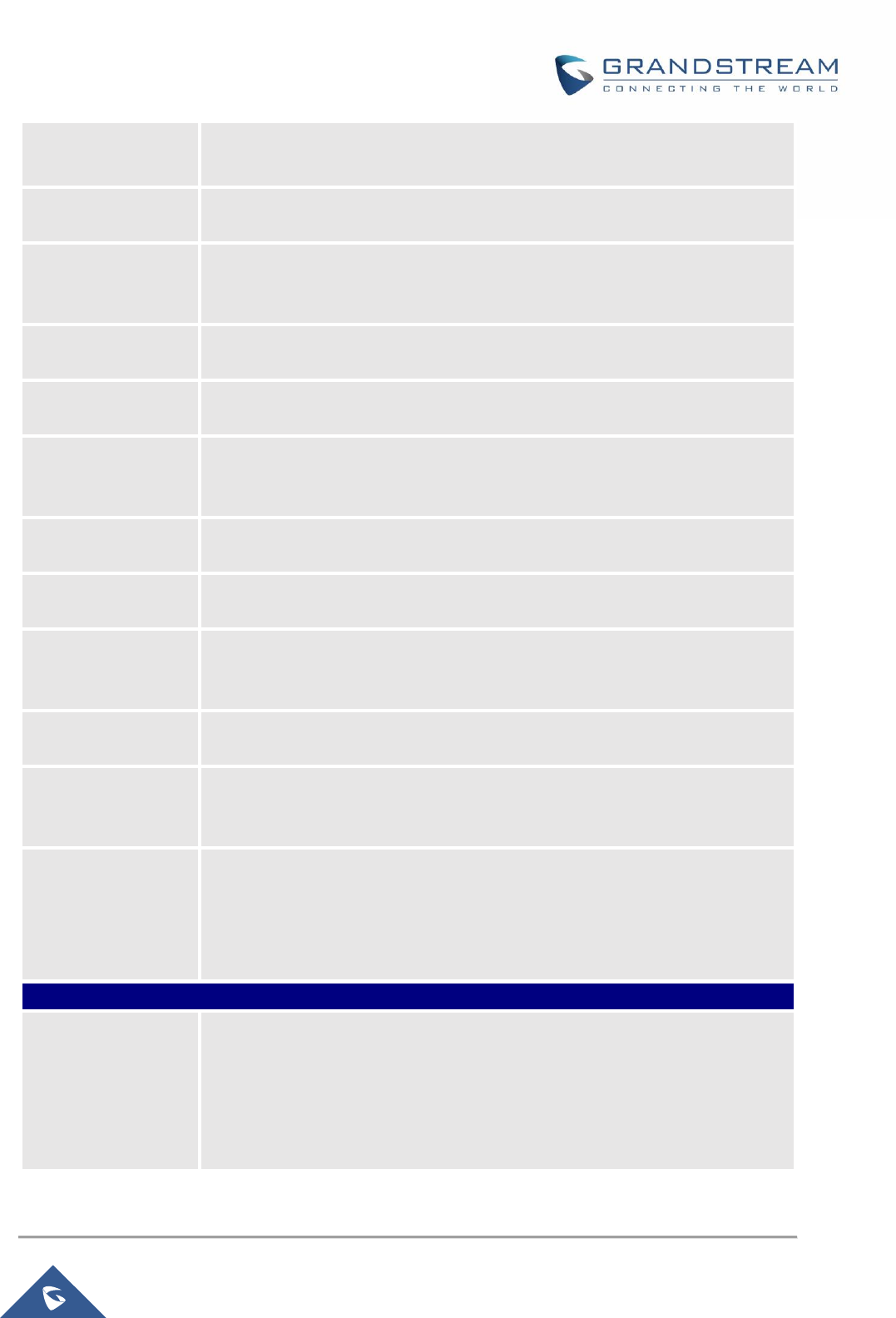
GXP1760W Administration Guide
P a g e | 30
Selects the distinctive ring tone for the matching rule. When the incoming caller
ID or Alert Info matches the rule, the phone will ring with the selected ring.
Ring Timeout
Defines the timeout (in seconds) for the rings on no answer. The default setting
is 60. The valid range is from 10 to 300.
Send Anonymous
If set to "Yes", the "From" header in outgoing INVITE messages will be set to
anonymous, essentially blocking the Caller ID to be displayed.
The default setting is "No".
Anonymous Call
Rejection
If set to "Yes", anonymous calls will be rejected.
The default setting is "No".
Auto Answer
If set to "Yes", the phone will automatically turn on the speaker phone to answer
incoming calls after a short reminding beep. Default setting is “No”.
Allow Auto Answer
by Call-Info
If set to "Yes", the phone will automatically turn on the speaker phone to answer
incoming calls, based on the SIP info header sent from the server/proxy. The
default setting is "No".
Custom Call-Info for
Auto Answer
Used in addition to match the contents of the info parameter in the Call-Info
header for auto answer.
Refer-To Use Target
Contact
If set to "Yes", the "Refer-To" header uses the transferred target's Contact
header information for attended transfer. The default setting is "No".
Transfer on
Conference Hang-
up
If set to "Yes", when the phone hangs up as the conference initiator, the
conference call will be transferred to the other parties so that other parties will
remain in the conference call. The default setting is "No".
Disable Recovery
on Blind Transfer
Disable recovery to the call to the transferee on failing blind transfer to the
target. The default setting is “No”.
No Key Entry
Timeout (s)
Defines the timeout (in seconds) for no key entry. If no key is pressed after the
timeout, the digits will be sent out. The default value is 4 seconds. The valid
range is from 1 to 15.
Use # as Dial Key
Allows users to configure the "#" key as the "Send" key. If set to "Yes", the "#"
key will immediately dial out the input digits. In this case, this key is essentially
equivalent to the "Send" key. If set to "No", the "#" key is included as part of the
dialing string and please make sure the dial plan is properly configured to allow
dialing # out. The default setting is “Yes”.
Account x Feature Codes
Enable Local Call
Features
When enabled, Do Not Disturb, Call Forwarding and other call features can be
used via the local feature codes on the phone. Otherwise, the provisioned
feature codes from the server will be used. User configured feature codes will
be used only if server provisioned feature codes are not provided. And once
feature codes are configured, either via server provisioning or local setting, a
softkey named “Features” will show on the LCD screen.
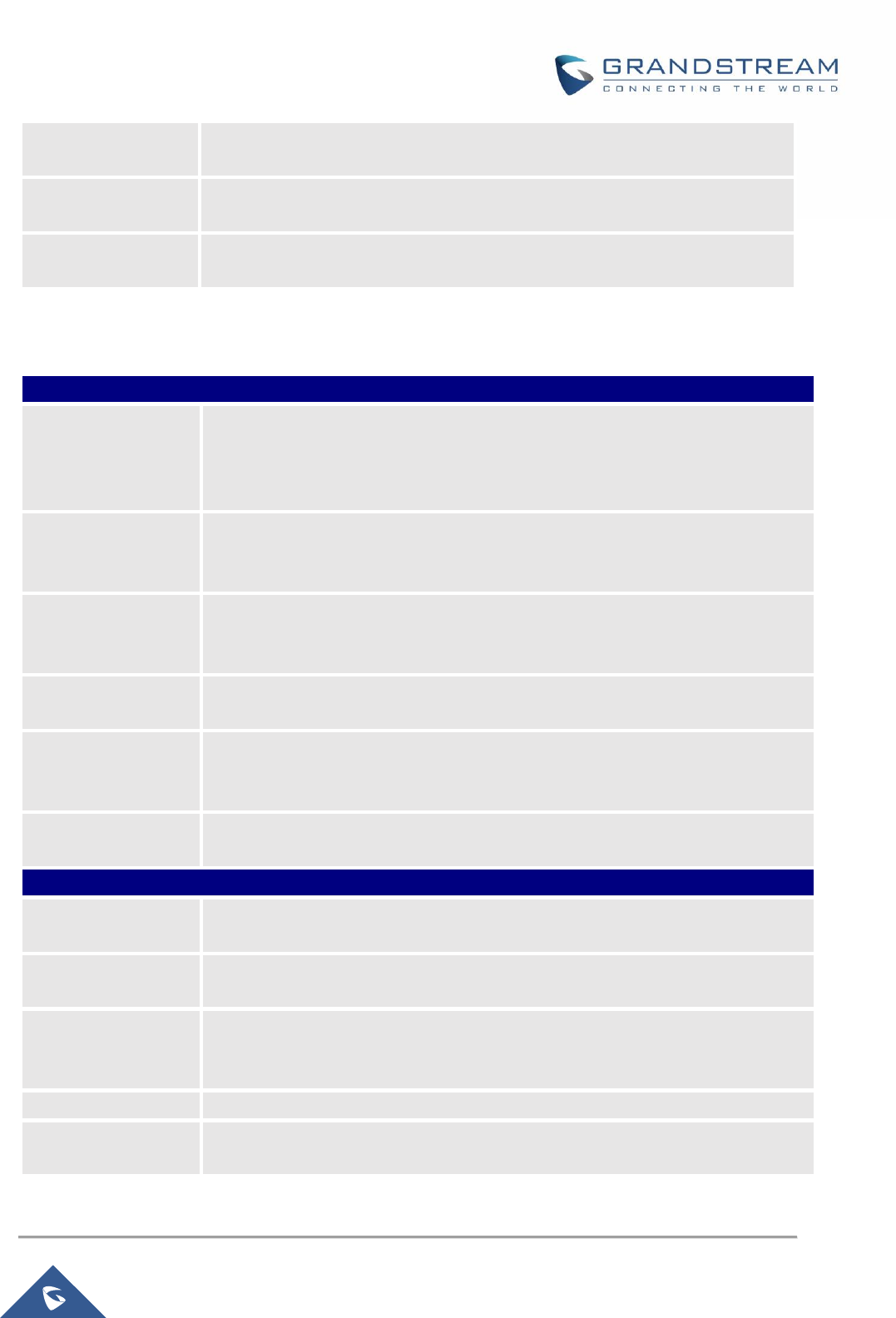
GXP1760W Administration Guide
P a g e | 31
Do Not Disturb
(DND)--On
Configures DND feature code to turn on DND.
Do Not Disturb
(DND)--Off
Configures DND feature code to turn off DND.
Delayed Call
Forward Wait Time
Defines the timeout (in seconds) before the call is forwarded on no answer. The
default value is 20 seconds. The valid range is 1 to 120.
Settings Page Definitions
Table 6: Settings Page Definitions
Settings General Settings
Local RTP Port
This parameter defines the local RTP port used to listen and transmit. It is the
base RTP port for channel 0. When configured, channel 0 will use this port _value
for RTP, channel 1 will use port_value+2 for RTP. Local RTP port ranges from
1024 to 65400 and must be even. The default value is 5004.
Use Random Port
Forces random generation of both the local SIP and RTP ports. This is usually
necessary when multiple phones are behind the same full cone NAT. Default
setting is Yes. Note: This parameter must be set to No for Direct IP Calling to work.
Keep-alive Interval
Specifies how often the phone sends a blank UDP packet to the SIP server in
order to keep the "ping hole" on the NAT router to open. The default setting is 20
seconds. The valid range is from 10 to 160.
Use NAT IP
The NAT IP address used in SIP/SDP messages. This field is blank at the default
settings. It should ONLY be used if it's required by your ITSP.
STUN Server
The IP address or Domain name of the STUN server. STUN resolution results are
displayed in the STATUS page of the Web GUI. Only non-symmetric NAT routers
work with STUN.
Public Mode
Configures to turn on/off the public mode for Hot Desking feature.
The default setting is “No”.
Settings Call Features
Off-hook Auto Dial
Configures a User ID/extension to dial automatically when the phone is off hook.
The phone will use the first account to dial out. The default setting is "No".
Off-hook Timeout
If configured, when the phone is off-hook, it will go on-hook after the timeout (in
seconds). The default value is 30 seconds. The valid range is from 10 to 60.
Bypass Dial Plan
Through Call History
and Directories
Enable/Disable the dial plan check while dialing through the call history and any
phonebook directories. The default setting is “No”.
Disable Call Waiting
Disables the call waiting feature. The default setting is "No".
Disable Call Waiting
Tone
Disables the call waiting tone when call waiting is on. The default setting is "No".
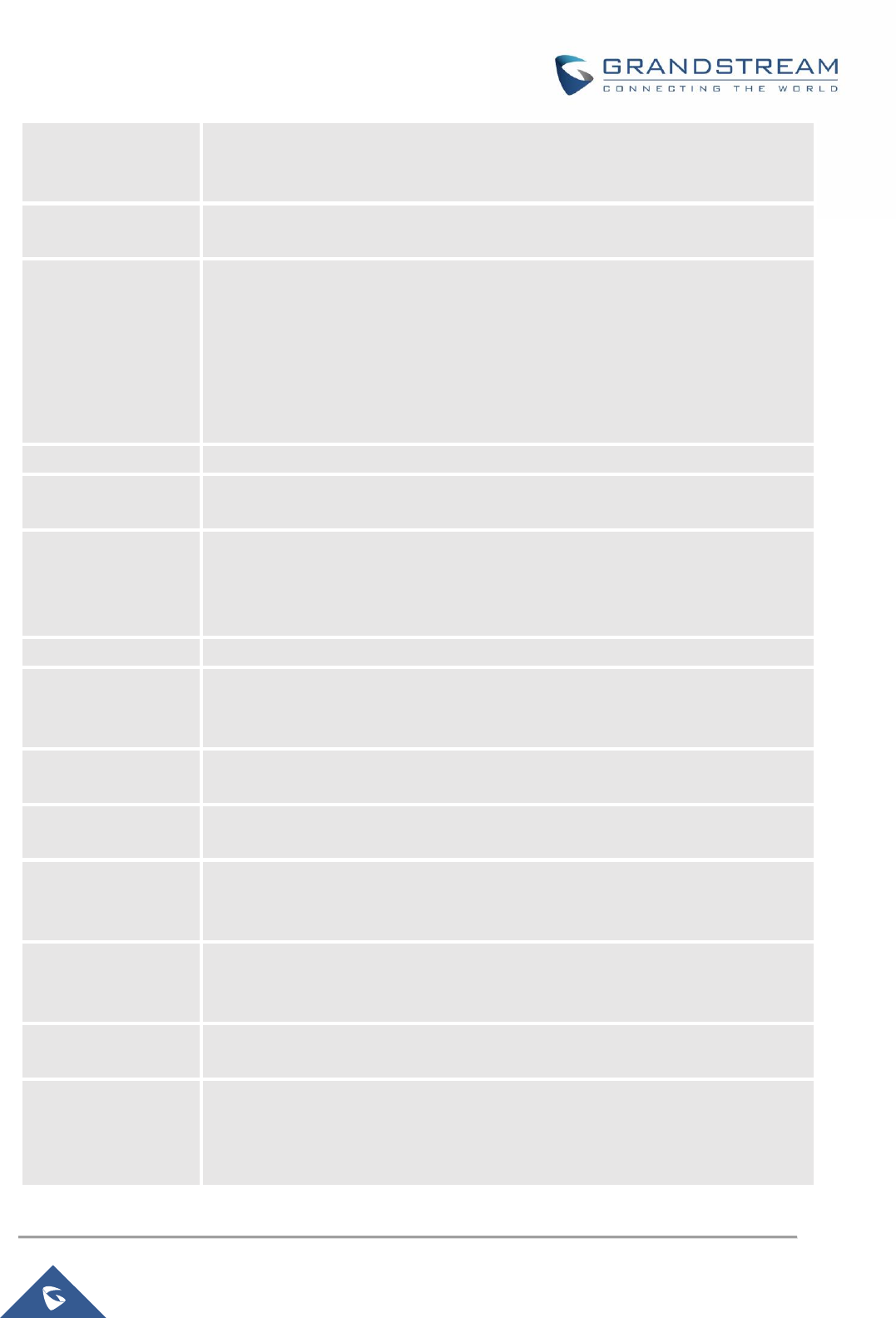
GXP1760W Administration Guide
P a g e | 32
Disable Busy Tone
on Remote
Disconnect
Disable the busy tone heard in the handset when call is disconnected remotely.
The default setting is “No”.
Disable Direct IP
Call
Disables Direct IP Call. The default setting is "No".
Use Quick IP Call
mode
When set to "Yes", users can dial an IP address under the same LAN/VPN
segment by entering the last octet in the IP address. To dial quick IP call, off hook
the phone and dial #XXX (X is 0-9 and XXX <=255), phone will make direct IP call
to aaa.bbb.ccc.XXX where aaa.bbb.ccc comes from the local IP address
REGARDLESS of subnet mask. #XX or #X are also valid so leading 0 is not
required (but OK). No SIP server is required to make quick IP call.
The default setting is "No".
Disable Conference
Disables the Conference function. The default setting is "No".
Disable in-call DTMF
Display
When it's set to "Yes", the DTMF digits entered during the call will not be displayed
on phone LCD. The default setting is "No".
Mute Key Functions
While Idle
Specifies the function of mute key in idle. Default setting is “DND”. When select
“Idle Mute” and press Mute key while idle, the future incoming call will be answered
with mute. When select “Disabled”, Mute key will not take effect while idle. The
default setting is “No”.
Disable Transfer
Disables the Transfer function. The default setting is "No".
In-call dial number
on pressing transfer
key
Configures the number for the phone to dial as DTMF during the call using TRAN
button.
Auto-Attended
Transfer
If set to "Yes", the phone will use attended transfer by default. The default setting
is "No".
Do Not Escape #
as %23 in SIP URI
Specifies whether to replace # by %23 or not for some special situations. The
default setting is "No".
Click-To-Dial
Feature
Enables Click-To-Dial feature. If this feature is enabled, user could click the green
dial button on left top corner of phone’s Web GUI, then choose the account and
dial to the target number. The default setting is "Disabled".
Call History Flash
Writing: Write
Timeout
Defines the interval (in seconds) to save the call history to phone's flash. 0
means this option is disabled. The default value is 300 seconds.
Max Unsaved Log
Defines the number of unsaved logs before written to phone's flash. 0 means
this option is disabled. The default value is 200 entries.
Default call log type
This option is used for users to set the default call log list after select
MENUCALL HISTORY. Broadsoft Call Log or Local Call Log option will only
show its own list.
Default option will keep both call log lists.
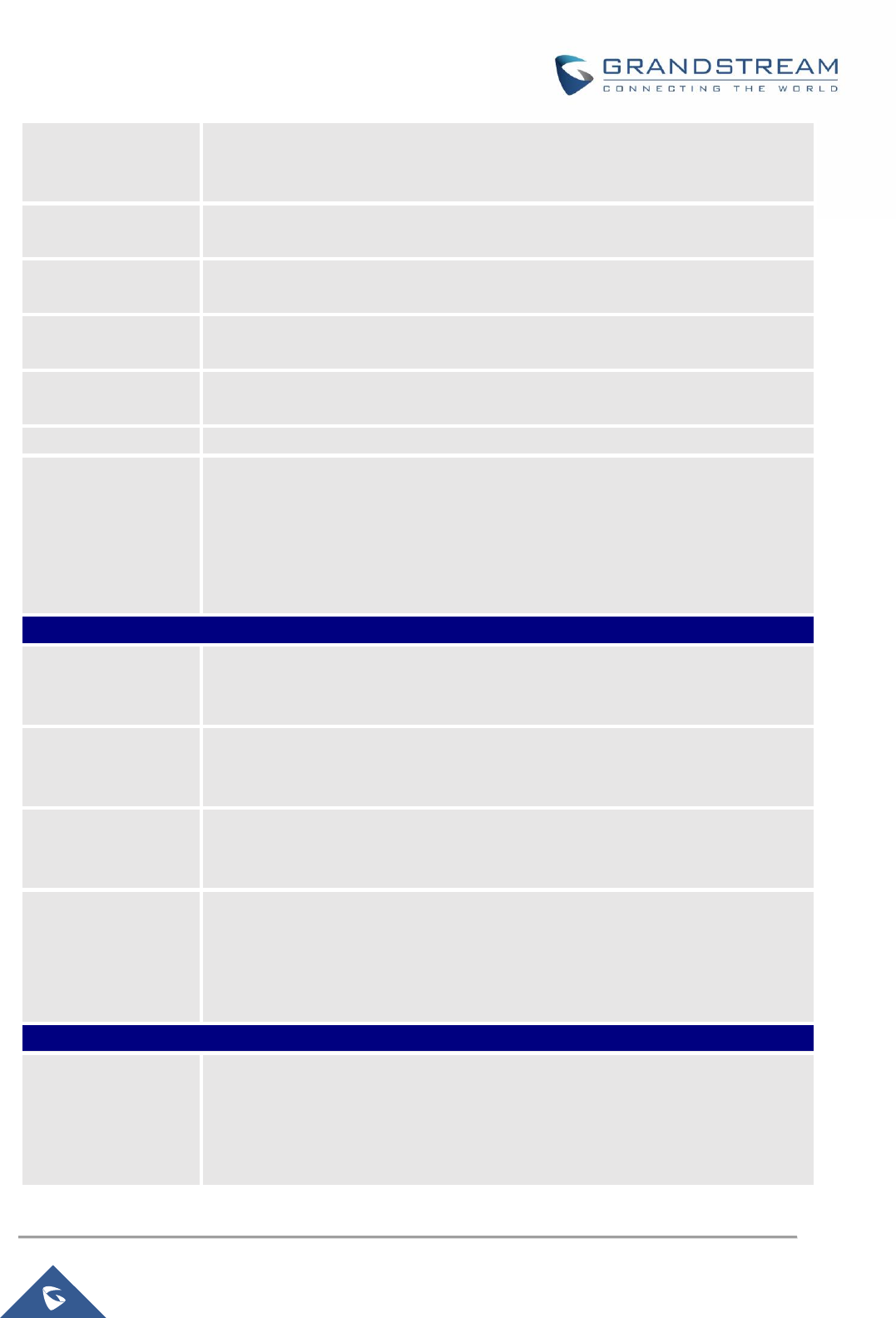
GXP1760W Administration Guide
P a g e | 33
Return Code When
Refusing Incoming
Call
Send selected type of SIP message to the call when refusing the incoming call.
Return Code When
Enable DND
Send selected type of SIP message when enabling DND.
Local Call
Recording Feature
Enables/Disables the ability to record calls locally while on the call screen. The
default setting is "Disabled"
Saved Local Call
Recording Location
Defines the location where the recordings will be stored, either on the internal
storage or on the connected USB. Default setting is “Internal Storage”
Download Local Call
Recordings
Allows users to download the available local call recording.
User-Agent Prefix
Configure the prefix in the “User-Agent” header.
Predictive Dialing
Feature
Enables/Disables predictive dialing feature.
While dialing, the phone will predict and list candidates of the target number based
on the entered digits. If the target number exists in the phonebook/call history, the
phone will display a list of matched numbers and the user could select the number
using the Up/Down key and dial out.
The default setting is “Enabled”.
Settings Multicast paging
Paging Barge
During active call if incoming multicast page is higher priority (1 being the highest)
than this value the call will be held and multicast page will be played. The default
setting is “Disabled”.
Paging Priority
Active
If enabled, during a multicast page if another multicast is received with higher
priority (1 being the highest) that one will be played instead. The default setting is
“Disabled”.
Multicast Paging
Codec
The codec for sending multicast pages, there are 5 codecs could be used: PCMU,
PCMA, G.726-32, G.729A/B, G.722 (wide band), G.723 and iLBC. The default
setting is “PCMU”.
Multicast Listening
Defines multicast listening addresses and labels. For example:
“Listening Address” should match the sender’s Value such as
“237.11.10.11:6767”
“Label” could be the description you want to use.
For details, please check the “Multicast Paging User Guide” on our Website.
Settings Ring Tone
Call Progress
Tones:
• System Ring Tone
• Dial Tone
• Second Dial Tone
Configures ring or tone frequencies based on parameters from local telecom. The
default value is North American standard. Frequencies should be configured with
known values to avoid uncomfortable high pitch sounds.
Syntax: f1=val,f2=val[,c=on1/off1[-on2/off2[-on3/off3]]].

GXP1760W Administration Guide
P a g e | 34
• Message Waiting
• Ring Back Tone
• Call-Waiting Tone
• Busy Tone
• Reorder Tone
(Frequencies are in Hz and cadence on and off are in 10ms)
ON is the period of ringing (“On time” in ‘ms’) while OFF is the period of silence.
To set a continuous ring, OFF should be zero. Otherwise it will ring ON ms and a
pause of OFF ms and then repeat the pattern. Up to three cadences are
supported.
Call Waiting Tone
Gain
This adjusts the call waiting tone volume.
Users can select “Low”, “Medium” or “High”. The default setting is “Low”.
Speaker Ring
Volume
Configures speaker ring volume. Valid range is 0 to 7.
Settings Audio Control
Headset Key Mode
When headset is connected to the phone, users could use the HEADSET button
in "Default Mode" or "Toggle Headset/Speaker".
• Default Mode:
➢ When the phone is in idle, press HEADSET button to off hook the phone
and make calls by using headset. Headset icon will display on the screen
in dialing/talking status.
➢ When there is an incoming call, press HEADSET button to pick up the call
using headset.
➢ When there is an active call using headset, press HEADSET button to
hang up the call.
➢ When Speaker/Handset is being used in dialing/talking status, press
HEADSET button to switch to headset. Press it again to hang up the call.
Or press speaker/Handset to switch back to the previous mode.
• Toggle Headset/Speaker:
➢ When the phone is in idle, press HEADSET button to switch to Headset
mode. The headset icon will display on the left side of the screen. In this
mode, if pressing Speaker button or Line key to off hook the phone,
headset will be used.
➢ When there is an active call, press HEADSET button to toggle between
Headset and Speaker.
Headset Type
Selects whether the connected headset is normal RJ11 headset, or Plantronics
EHS headset.
Always Ring
Speaker
Configures to enable or disable the speaker to ring when headset is used on
"Toggle Headset/Speaker" mode.
If set to "Yes", when the phone is in Headset "Toggle Headset/Speaker" mode,
both headset and speaker will ring on incoming call.
The default setting is "No".
Headset TX gain
Configures the transmission gain of the headset. The default value is 0dB.
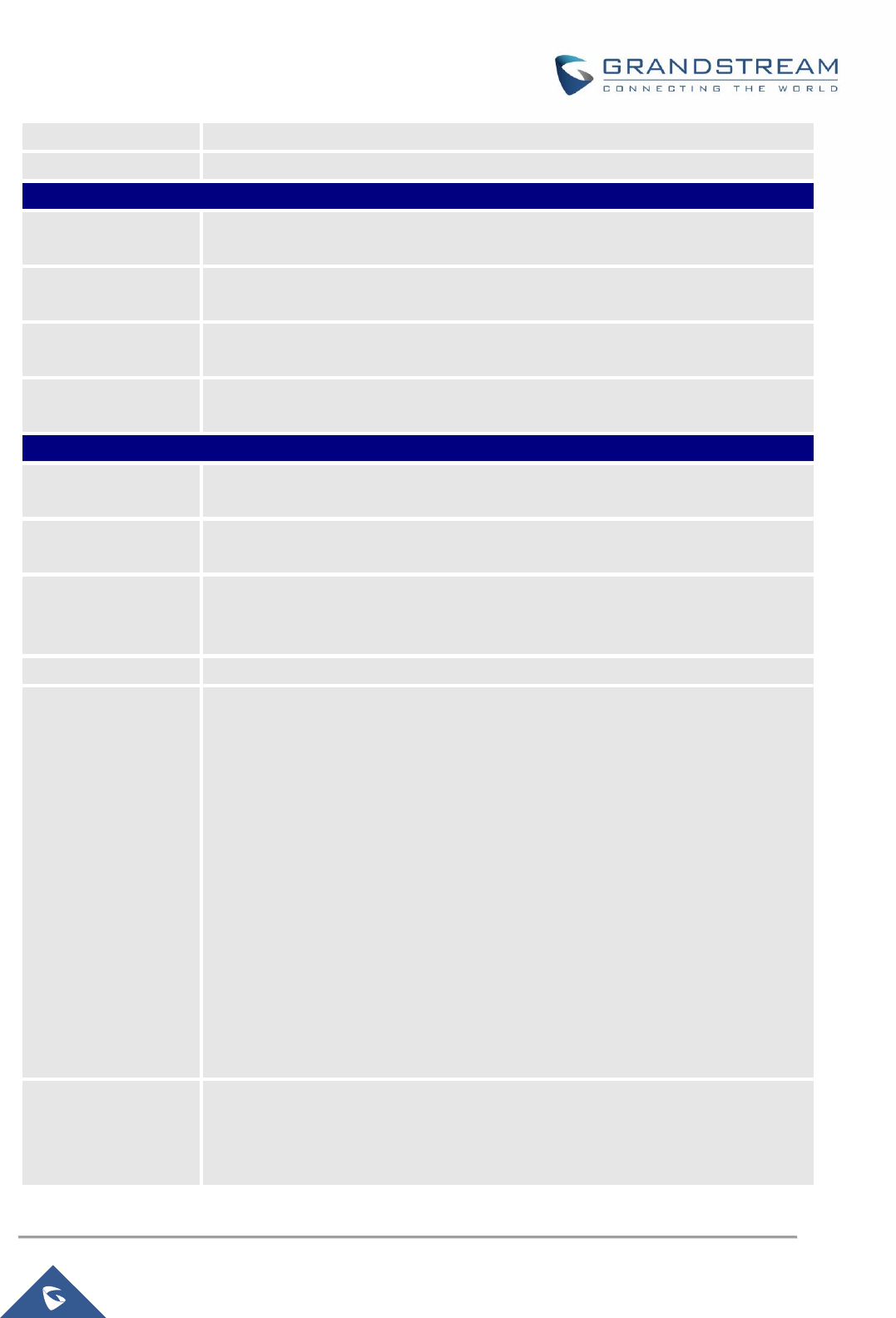
GXP1760W Administration Guide
P a g e | 35
Headset RX gain
Configures the receiving gain of the headset. The default value is 0dB.
Handset TX gain
Configures the transmission gain of the handset. The default value is 0dB.
Settings LCD Display
Backlight
Brightness: Active
Configures the LCD brightness when the phone is active. Valid range is 10 to 100
where 100 is the brightest. Default value is 100.
Backlight
Brightness: Idle
Configures the LCD brightness when the phone is idle.
Valid range is 10 to 100 where 0 is off and 100 is the brightest. Default value is 60.
Disable Missed Call
Backlight
If set to "Yes", the screen will turn off the LCD backlight when there is a missed
call on the phone. The default setting is "No".
Hide System Softkey
on Main Page
Check to hide the system generated Softkey on main page.
Settings Date and Time
NTP Server
Defines the URL or IP address of the NTP server. The phone may obtain the date
and time from the server. The default setting is us.pool.ntp.org.
NTP Update Interval
Time interval for updating time from the NTP server. Valid time value is in between
5 to 1440 minutes. The default setting is “1440” minutes.
Allow DHCP Option
42 Override NTP
Server
Defines whether DHCP Option 42 should override NTP server or not. When
enabled, DHCP Option 42 will override the NTP server if it's set up on the LAN.
The default setting is "Yes".
Time Zone
Configures the date/time used on the phone according to the specified time zone.
Self-Defined Time
Zone
This parameter allows the users to define their own time zone.
The syntax is: std offset dst [offset], start [/time], end [/time]
Default is set to: MTZ+6MDT+5,M4.1.0,M11.1.0
MTZ+6MDT+5
This indicates a time zone with 6 hours offset with 1 hour ahead (when daylight
saving) which is U.S central time. If it is positive (+) if the local time zone is west
of the Prime Meridian (A.K.A: International or Greenwich Meridian) and negative
(-) if it is east.
M4.1.0,M11.1.0
The 1st number indicates Month: 1,2,3.., 12 (for Jan, Feb, .., Dec)
The 2nd number indicates the nth iteration of the weekday: (1st Sunday, 3rd
Tuesday…)
The 3rd number indicates weekday: 0,1,2,..,6 (for Sun, Mon, Tues, ... ,Sat)
Therefore, this example is the DST which starts from the First Sunday of April to
the 1st Sunday of November.
Date Display Format
Configures the date display format on the LCD. The following formats are
supported and the default setting is yyyy-mm-dd:
• yyyy-mm-dd: 2012-07-02
• mm-dd-yyyy: 07-02-2012
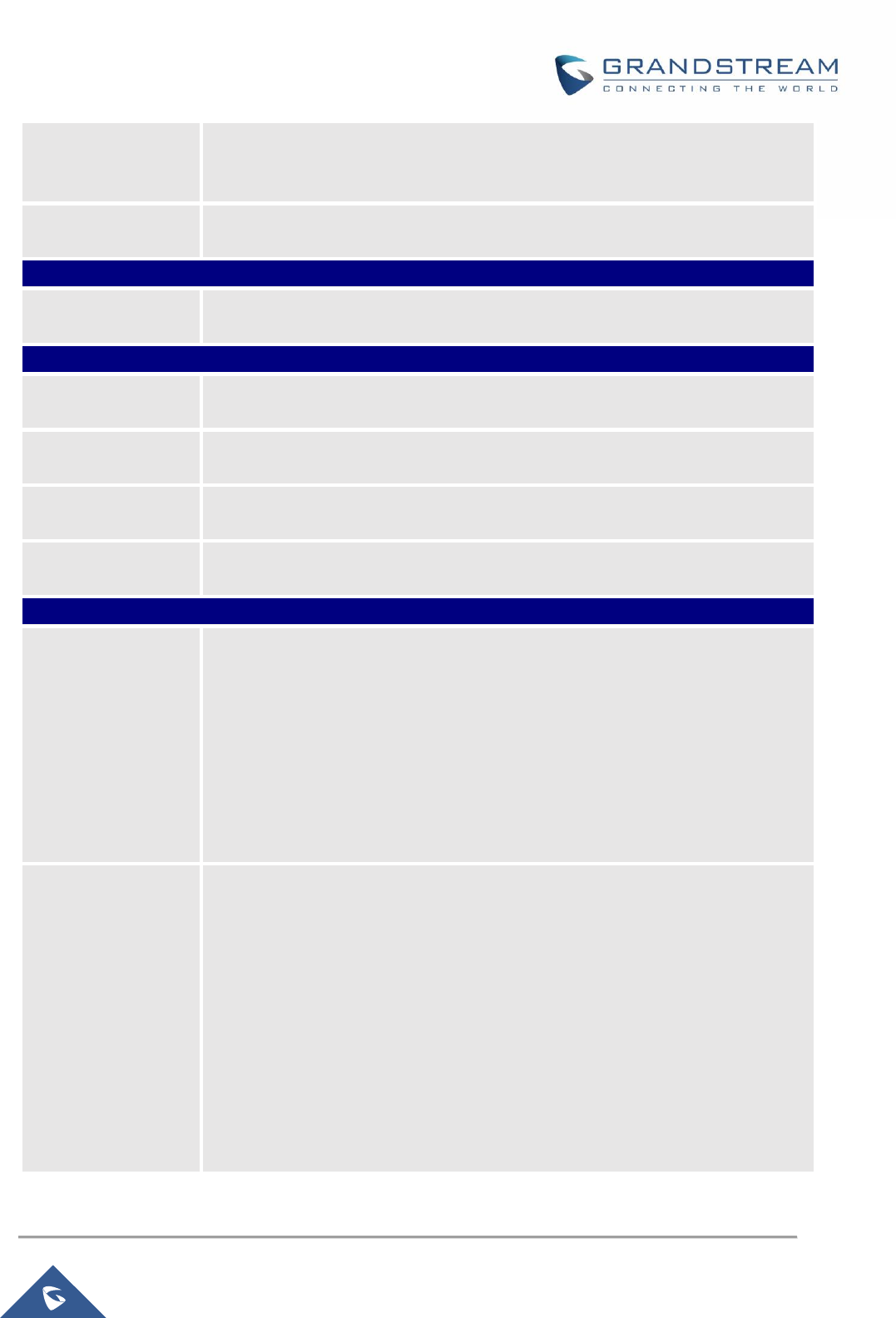
GXP1760W Administration Guide
P a g e | 36
• dd-mm-yyyy: 02-07-2012
• dddd, MMMM dd: Friday, October 12
• MMMM dd, dddd: October 12, Friday
Time Display
Format
Configures the time display in 12-hour or 24-hour format on the LCD. The default
setting is in 12-hour format.
Settings Web Service
Use Auto Location
Service
Enables/disables auto location services on the phone. Default setting is “Yes”.
Settings XML Application
Idle Screen XML
Download
Configures to enable idle screen XML download. Users could select
HTTP/HTTPS/TFTP to download the XML idle screen file. Default setting is "No".
Download Screen
XML at Boot-up
If set to "Yes", the idle screen XML file will be downloaded when the phone boots
up. The default setting is "No".
Use Custom
Filename
Specifies the custom file for the idle screen XML file to be downloaded.
Idle Screen XML
Server Path
Configures the server path to download the idle screen XML file. This field could
be IP address or URL, with up to 256 characters.
Settings Programmable Keys
Virtual Multi-
Purpose Keys
Settings
Call Screen SettingsKey Mode: Defines the key mode used. Two modes are
available:
• Line Mode: Each configured line key can only hold 1 call, and users can
switch to choose between accounts by pressing on a free line key.
Advantage: Easy to manage. Disadvantage: Limited line space.
• Account Mode: Each configured line key is reserved for the corresponding
account and can have up to 8 grouped lines. Users can press on “New call”
softkey to initiate a new call.
Advantage: Multiple calls per key. Disadvantage: Can get a bit complicated
Virtual Multi-
Purpose Keys (VPK)
Assigns a function to the corresponding VPK. The key mode options are:
• Line
Regular line key to open up a line and switch line. The Value field can be left
blank.
• Shared Line
Share line for Shared Line Appearance feature. Select the Account registered
as Shared line for the line key. The Value field can be left blank.
• Speed Dial
Select the Account to dial from. And enter the Speed Dial number in the Value
field to be dialed, or enter the IP address to set the Direct IP call as Speed
Dial.

GXP1760W Administration Guide
P a g e | 37
• Busy Lamp Field (BLF)
Select the Account to monitor the BLF status. Enter the extension number in
the Value field to be monitored.
• Presence Watcher
This option has to be supported by a presence server and it is tied to the "Do
Not Disturb" status of the phone's extension.
• Eventlist BLF
This option is similar to the BLF option but in this case the PBX collects the
information from the phones and sends it out in one single notify message.
PBX server has to support this feature.
• Speed Dial via active account
Similar to Speed Dial but it will dial based on the current active account. For
example, if the phone is offhook and account 2 is active, it will call the
configured Speed Dial number using account 2.
• Dial DTMF
Enter a series of DTMF digits in the Value field to be dialed during the call.
"Enable MPK Sending DTMF" has to be set to "Yes" first.
• Voice Mail
Select Account and enter the Voice Mail access number in the Value field.
• Call Return
The last answered calls can be dialed out by using Call Return. The Value
field should be left blank. Also, this option is not binding to the account and
the call will be returned based on the account with the last answered call.
• Transfer
Select Account, and enter the number in the Value field to be transferred (blind
transfer) during the call.
• Call Park
Select Account, and enter the call park extension in the Value field to park/pick
up the call.
• Monitored Call Park
Select account from Account field, and enter the call park extension in the
Value field to park/pick up the call, and also monitor the parked call via Line
Key’s light.
• Intercom
Select Account, and enter the extension number in the Value field to do the
intercom.

GXP1760W Administration Guide
P a g e | 38
• LDAP Search
This option is to narrow the LDAP search scope. Enter the LDAP search base
in the Description field. It could be the same or different from the Base in LDAP
configuration under Advanced Settings. The Base in LDAP configuration will
be used if the Description field is left blank. Enter the LDAP Name/Number
filter in the Value field. For example:
If users set MPK 1 as “LDAP Search” for “Account 1”, and set filters:
Description ou=video,ou=SZ,dc=grandstream,dc=com
Value sn=Li
Since the Base for LDAP server configuration is “dc=grandstream,dc=com”,
“ou=video,ou=SZ” is added to narrow the LDAP search scope. “sn=Li” is the
example to filter the last name.
• Multicast Paging
This option is for multicast sending. Enter Line key description in Description
field and multicast sending address in Value field.
• Record
This option is for Recording calls. Enter Line key description in Description
filed and the recorded extension number in Value field. Please make sure
whether your VOIP provider supports this feature before using it.
• Call Log
Select Account and enter account number in the Value field to allow
configuration of call log for other extension.
• Menu
This option is to take users to the main menu screen directly.
• Information
Display system information such as IP address, MAC address and software
version.
• Message
Display information about instant messages and voice mails received for the
programmed account.
Idle Screen Softkeys
Assigns a function to the corresponding Softkeys. The key mode options are:
• Speed Dial
Select the Account to dial from. And enter the Speed Dial number in the Value
field to be dialed.
• Speed Dial via active account
Similar to Speed Dial but it will dial based on the current active account.
For example, if the phone is offhook and account 2 is active, it will call the
configured Speed Dial number using account 2.

GXP1760W Administration Guide
P a g e | 39
• Voice Mail
Select Account and enter the Voice Mail access number in the Value field.
• Call Return
The last answered calls can be dialed out by using Call Return. The Value
field should be left blank. Also, this option is not binding to the account and
the call will be returned based on the account with the last answered call.
• Intercom
Select Account, and enter the extension number in the Value field to do the
intercom.
• LDAP Search
This option is to narrow the LDAP search scope. Enter the LDAP search base
in the Description field. It could be the same or different from the Base in LDAP
configuration under Advanced Settings. The Base in LDAP configuration will
be used if the Description field is left blank. Enter the LDAP Name/Number
filter in the Value field. For example: If users set MPK 1 as “LDAP Search” for
“Account 1”, and set filters:
Description ou=video,ou=SZ,dc=grandstream,dc=com
Value sn=Li
Since the Base for LDAP server configuration is “dc=grandstream,dc=com”,
“ou=video,ou=SZ” is added to narrow the LDAP search scope. “sn=Li” is the
example to filter the last name.
• Call Log
Select Account and enter account number in the Value field to access to the
Call Log of that selected account.
• Menu
Shortcut for Menu button.
• Information
Display system information such as IP address, MAC address and software
version.
• Message
Display information about instant messages and voice mails received for the
programmed account.
Settings Broadsoft Broadsoft XSI
XSI
Configures XSI Directory.
• Server
Configure the BroadWorks Xsi server URI. If the server uses HTTPS,
please add the header “HTTPS” ahead of the Server URI.

GXP1760W Administration Guide
P a g e | 40
For instance, “https://SERVER_URI”.
• Port
Configure the BroadWorks Xsi server port. The default port is 80. If the
server uses HTTPS, please configure 443.
• XSI Authentication Type
Select the authentication type to use to authenticate against the Broadsoft
server. User can choose the Login credentials, SIP Credentials or use
the existing Accounts to authenticate.
• Login Username
Configure the Username for the BroadWorks XSI feature.
• Login Password
Configure the password for the BroadWorks XSI feature.
• SIP User Name
Configure SIP Username for the BroadWorks XSI server.
• SIP UserID
Configure SIP User ID for the BroadWorks XSI server.
• SIP Password
Configure SIP Password for the BroadWorks XSI server.
Network Directories
Enable/Disable Broadsoft Network directories and defines the directory name.
The directory types are:
• Group Directory
Enable/Disable and rename the BroadWorks XSI Group Directory
features on the phone. If keep the Name box blank, the phone will use the
default name “Group” for it.
• Enterprise Directory
Enable/Disable and rename the BroadWorks XSI Enterprise Directory
features on the phone. If keep the Name box blank, the phone will use the
default name “Enterprise” for it.
• Group Common
Enable/Disable and rename the BroadWorks XSI Group Common
Directory features on the phone. If keep the Name box blank, the phone
will use the default name “Group Common” for it.
• Enterprise Common
Enable/Disable and rename the BroadWorks XSI Enterprise Common
Directory features on the phone. If keep the Name box blank, the phone
will use the default name “Enterprise Common” for it.
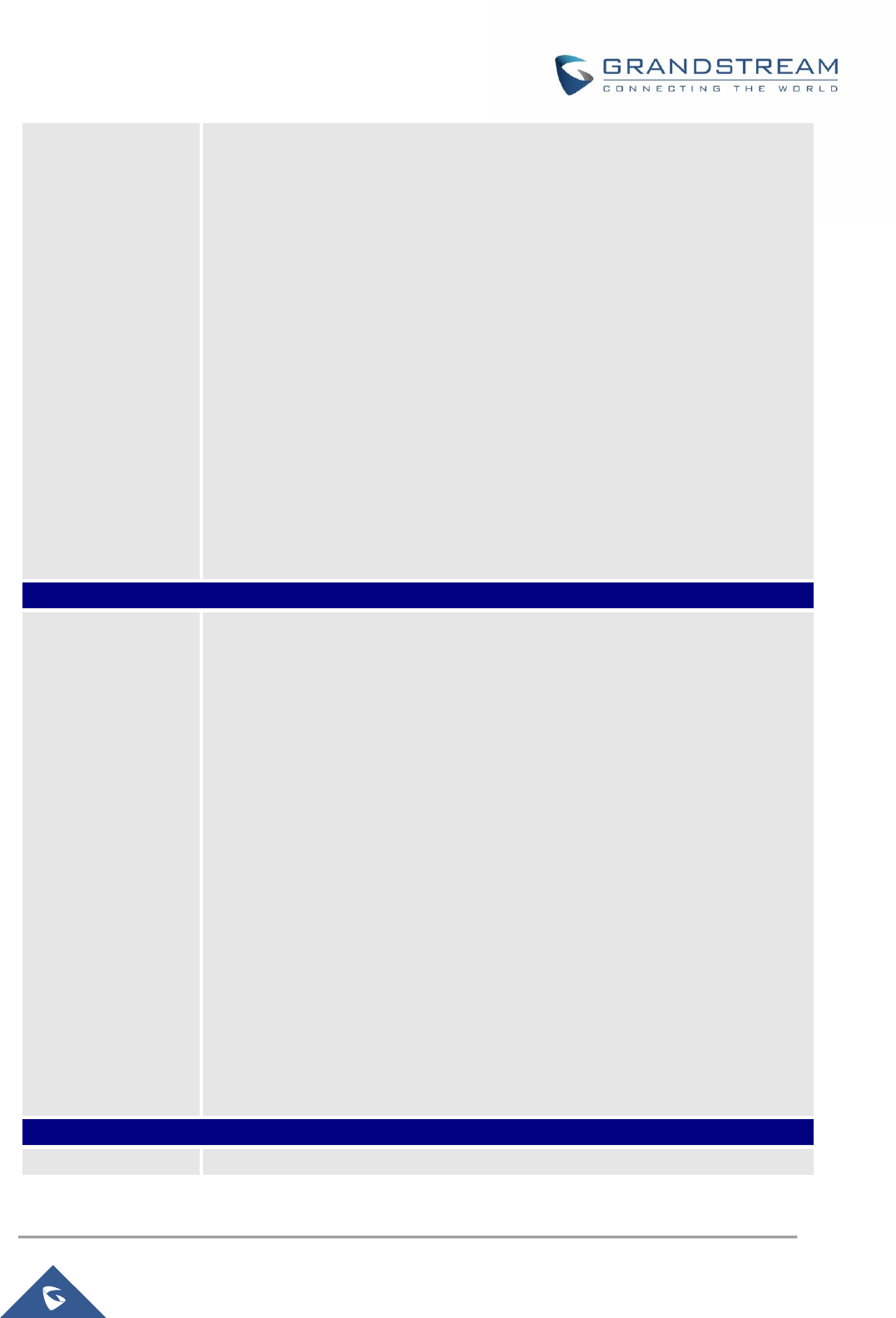
GXP1760W Administration Guide
P a g e | 41
• Personal Directory
Enable/Disable and rename the BroadWorks XSI Personal Directory
features on the phone. If keep the Name box blank, the phone will use the
default name “Personal” for it.
• Missed Call Log
Enable/Disable and rename the BroadWorks XSI Missed Call Log
features on the phone. If keep the Name box blank, the phone will use the
default name “Missed” for it.
• Placed Call Log
Enable/Disable and rename the BroadWorks XSI Placed Call Log
features on the phone. If keep the Name box blank, the phone will use the
default name “Outgoing” for it.
• Received Call Log
Enable/Disable and rename the BroadWorks XSI Placed Call Log
features on the phone. If keep the Name box blank, the phone will use the
default name “Incoming” for it.
Settings Outbound Notification
Action URL
For detailed instructions, please refer to: [Outbound Notification Support]
• Setup Completed
• Registered
• Unregistered
• Off Hook
• On Hook
• Incoming Call
• Outgoing Call
• Missed Call
• Established Call
• Terminated Call
• Open DND
• Close DND
• Open Forward
• Close Forward
• Blind Transfer
• Attended Transfer
• Hold Call
• UnHold Call
Settings Affinity Settings
Affinity Support
Allows communication with GS Affinity CTI application to manage telephone calls
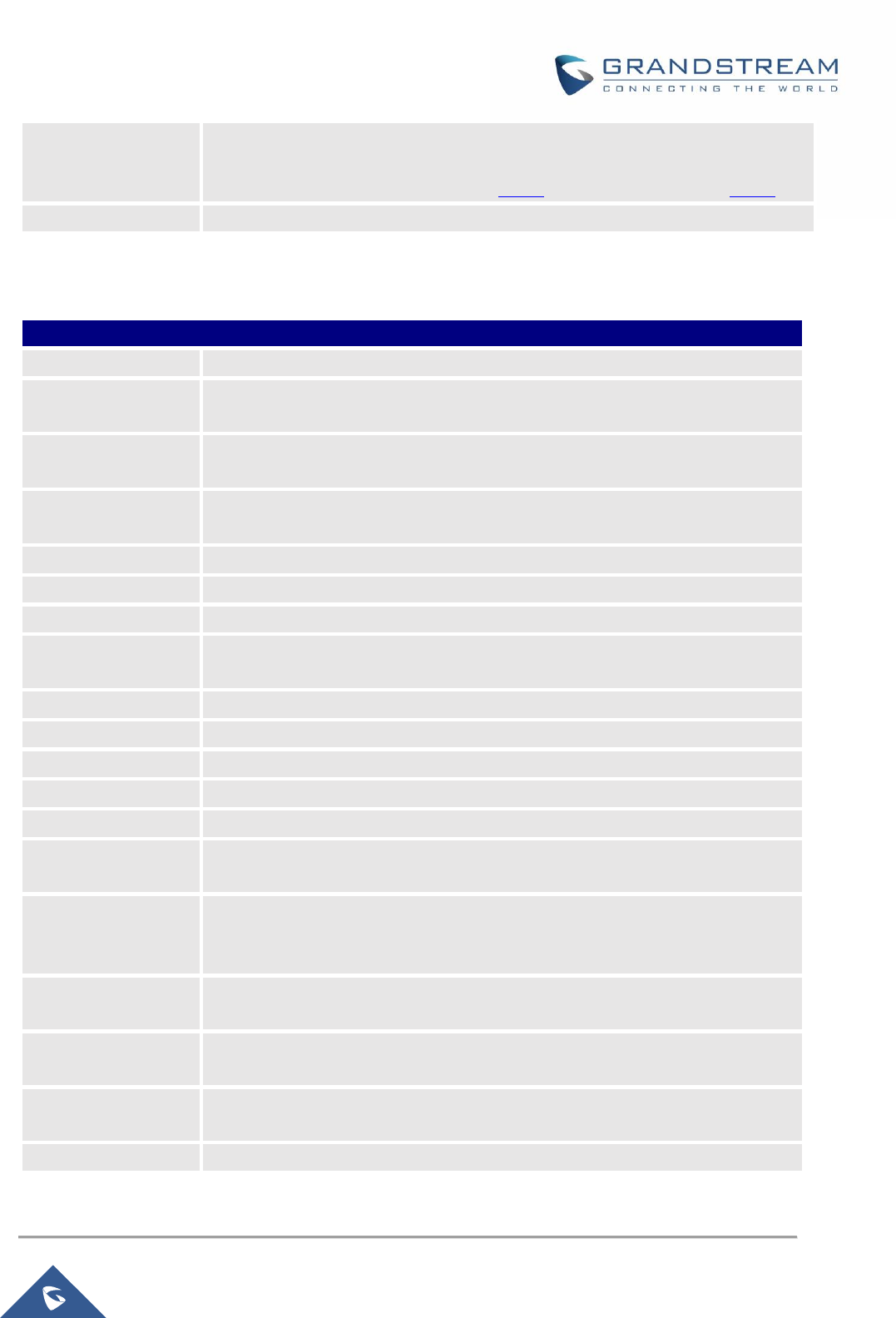
GXP1760W Administration Guide
P a g e | 42
from computer. If enabled, a reboot is required to establish the communication.
Default is “Disabled”.
GS Affinity CTI Application is available HERE and its User Guide from HERE.
Preferred Account
Chooses the account on which CTI support is enabled.
Network Page Definitions
Table 7: Network Page Definitions
Network Basic Settings
Internet Protocol
Selects IPv4 Only, IPv6 Only or Both IPv4 & IPv6. Default setting is “IPv4 Only”.
IPv4 Address
Allows users to configure the appropriate network settings on the phone to obtain
IPv4 address from DHCP server.
DHCP Host name
(Option 12)
Specifies the name of the client. This field is optional but may be required by
some Internet Service Providers.
DHCP Vendor Class
ID (Option 60)
Used by clients and servers to exchange vendor class ID. The default setting is
“Grandstream GXP1760W”.
PPPoE Account ID
Enter the PPPoE account ID.
PPPoE Password
Enter the PPPoE Password.
PPPoE Service Name
Enter the PPPoE Service Name.
Statically configured
as
Select to apply the static configuration set for the IP address.
IPv4 Address
Enter the IP address when static IP is used.
Subnet Mask
Enter the Subnet Mask when static IP is used for IPv4.
Gateway
Enter the Default Gateway when static IP is used for IPv4.
DNS Server 1
Enter the DNS Server 1 when static IP is used for IPv4.
DNS Server 2
Enter the DNS Server 2 when static IP is used for IPv4.
Preferred DNS
Server
Enter the Preferred DNS Server for IPv4.
IPv6 Address
Allows users to configure the appropriate network settings on the phone to obtain
IPv6 address. Users could select “Auto-configured” or “Statically configured” for
the IPv6 address type.
Static IPv6 Address
Enter the static IPv6 address when Full Static is used in “Statically configured”
IPv6 address type.
IPv6 Prefix Length
Enter the IPv6 prefix length when Full Static is used in “Statically configured”
IPv6 address type.
Prefix Static
Select to apply the prefix set on IPv6 Prefix when using “Statically configured”
IPv6 address type.
IPv6 Prefix (64 bits)
Enter the IPv6 Prefix (64 bits) when Prefix Static is used in “Statically configured”
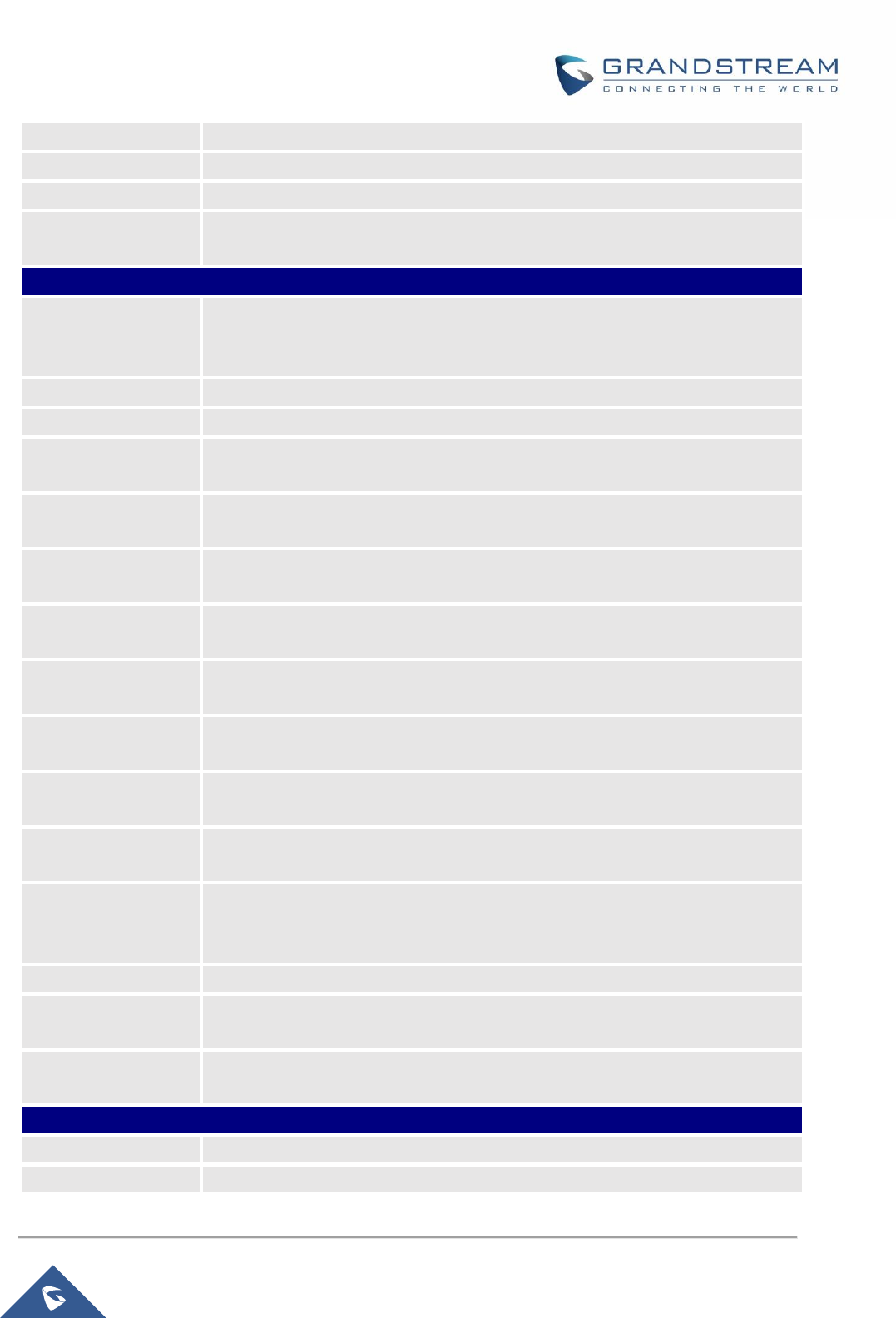
GXP1760W Administration Guide
P a g e | 43
IPv6 address type.
DNS Server 1
Enter the DNS Server 1 for IPv6.
DNS Server 2
Enter the DNS Server 2 for IPv6.
Preferred DNS
server
Enter the Preferred DNS Server for IPv6.
Network Advanced Settings
802.1X mode
Allows the user to enable/disable 802.1X mode on the phone. The default value
is disabled. To enable 802.1X mode, this field should be set to EAP-MD5, users
may also choose EAP-TLS, or EAP-PEAP.
802.1X Identity
Enter the Identity information for the 802.1x mode.
MD5 Password
Enter the MD5 Password for the 802.1X mode.
802.1X CA
Certificate
Upload 802.1X CA certificate to the phone, or delete existed 802.1X CA
certificate from the phone.
802.1X Client
Certificate
Upload 802.1X Client certificate to the phone, or delete existed 802.1X Client
certificate from the phone.
HTTP Proxy
Specifies the HTTP proxy URL for the phone to send packets to. The proxy
server will act as an intermediary to route the packets to the destination.
HTTPS Proxy
Specifies the HTTPS proxy URL for the phone to send packets to. The proxy
server will act as an intermediary to route the packets to the destination.
Layer 3 QoS for SIP
Defines the Layer 3 QoS parameter for SIP. This value is used for IP
Precedence, Diff-Serv or MPLS. The default value is 26.
Layer 3 QoS for RTP
Defines the Layer 3 QoS parameter for RTP. This value is used for IP
Precedence, Diff-Serv or MPLS. The default value is 46.
Layer 2 QoS
802.1Q/VLAN Tag
Assigns the VLAN Tag of the Layer 2 QoS packets. The default value is 0.
Layer 2 QoS 802.1p
Priority Value
Assigns the priority value of the Layer2 QoS packets. The default value is 0.
PC Port Mode
Configure the PC port mode. When set to “Mirrored”, the traffic in the LAN port
will go through PC port as well and packets can be captured by connecting a PC
to the PC port. The default setting is “Enabled”.
PC Port VLAN Tag
Assigns the VLAN Tag of the PC port. The default value is “0”.
PC Port Priority
Value
Assigns the priority value of the PC port. The default value is “0”.
Enable LLDP
Control LLDP (Link Layer Discovery Protocol) service. Default setting is
“Enabled”.
Network OpenVPN® Settings
OpenVPN® Enable
Enable/Disable OpenVPN® feature. Default is No.
OpenVPN® Server
Specifies the IP address or FQDN for the OpenVPN® Server.
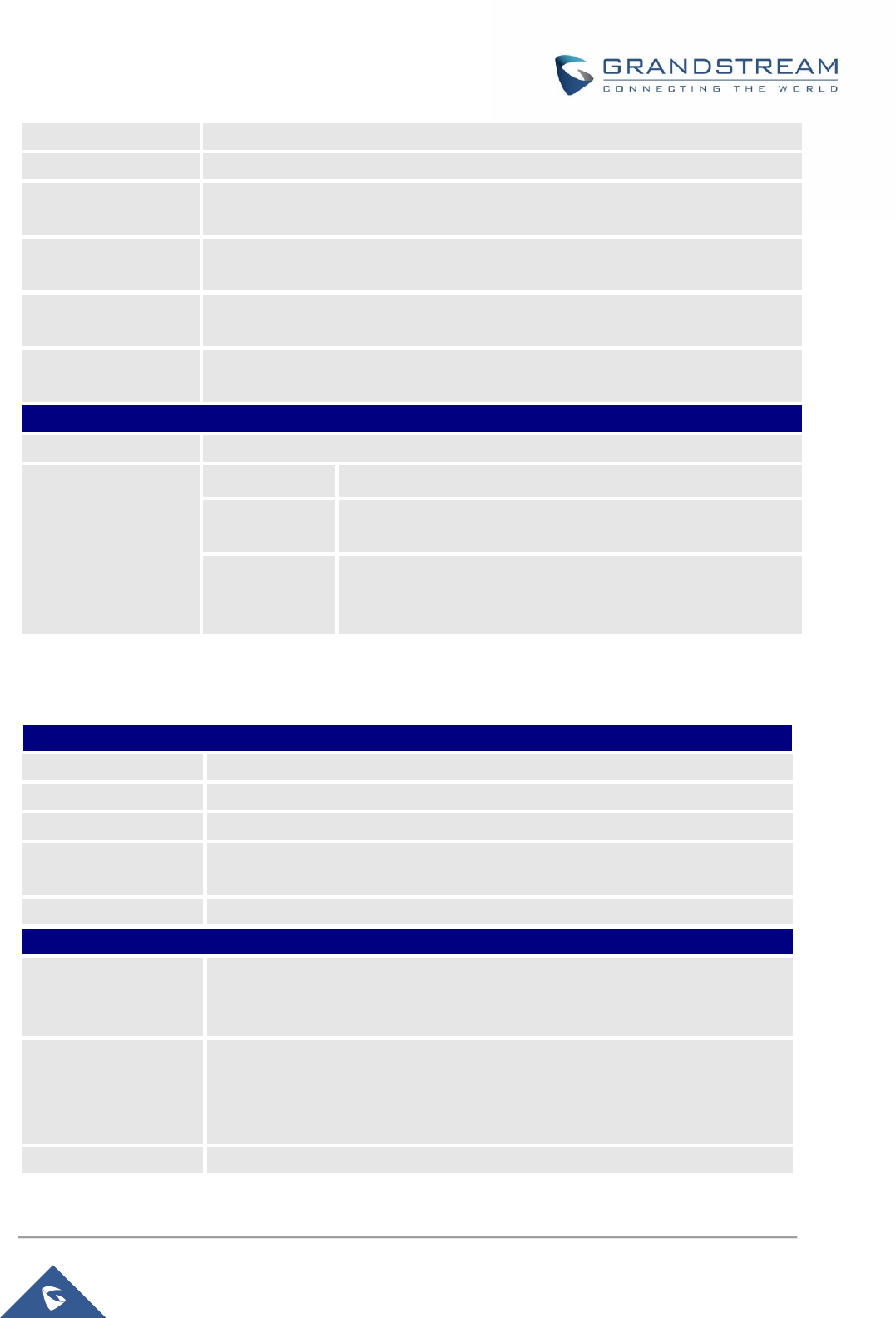
GXP1760W Administration Guide
P a g e | 44
Address
OpenVPN® Port
Specifies the listening port of the OpenVPN® server. Default is 1194.
OpenVPN®
Transport
Specifies the Transport Type of OpenVPN® whether UDP or TCP. Default is
UDP.
OpenVPN® CA
Uploads the Certification Authority of OpenVPN®. For a new upload, users could
click on “Delete” to erase the last certificate, and then upload a new one.
OpenVPN®
Certificate
Click on “Upload” to upload OpenVPN® certificate. For a new upload, users
could click on “Delete” to erase the last certificate, and then upload a new one.
OpenVPN® Client
Key
Click on “Upload” to upload OpenVPN® Key. For a new upload, users could click
on “Delete” to erase the last certificate, and then upload a new one.
Network WiFi Settings
Enable/Disable WiFi
Enables / Disables the WiFi on the phone. Default setting is “No”.
Access Point (1 - 10)
SSID
Enters WiFi SSID name to connect.
Password
Configures the authentication password to access WiFi
Network.
Security Type
Specifies the WiFi encryption type. The available options are
the following: None, WEP, WPA, WPA Enterprise and Auto.
Default settings is None.
Maintenance Page Definitions
Table 8: Maintenance Page Definitions
Maintenance Web Access
New Password
Set new password for web GUI access as User. This field is case sensitive.
Confirm Password
Enter the new User password again to confirm.
Current Password
The current admin password is required for setting a new admin password.
New Password
Set new password for web GUI access as Admin.
This field is case sensitive.
Confirm Password
Enter the new Admin password again to confirm.
Maintenance Upgrade and Provisioning
Upgrade Firmware
Allows users to upload the firmware file locally by pressing Start button, after
selecting the correct firmware file from the local storage, the phone will start
the firmware upgrade automatically.
Firmware Upgrade
and Provisioning
Specifies how firmware upgrading and provisioning request to be sent: Always
Check for New Firmware, Check New Firmware only when F/W pre/suffix
changes, Always Skip the Firmware Check. The default setting is “Always
Check for New Firmware”.
Always Authenticate
Only applies to HTTP/HTTPS. If enabled, the phone will send credentials
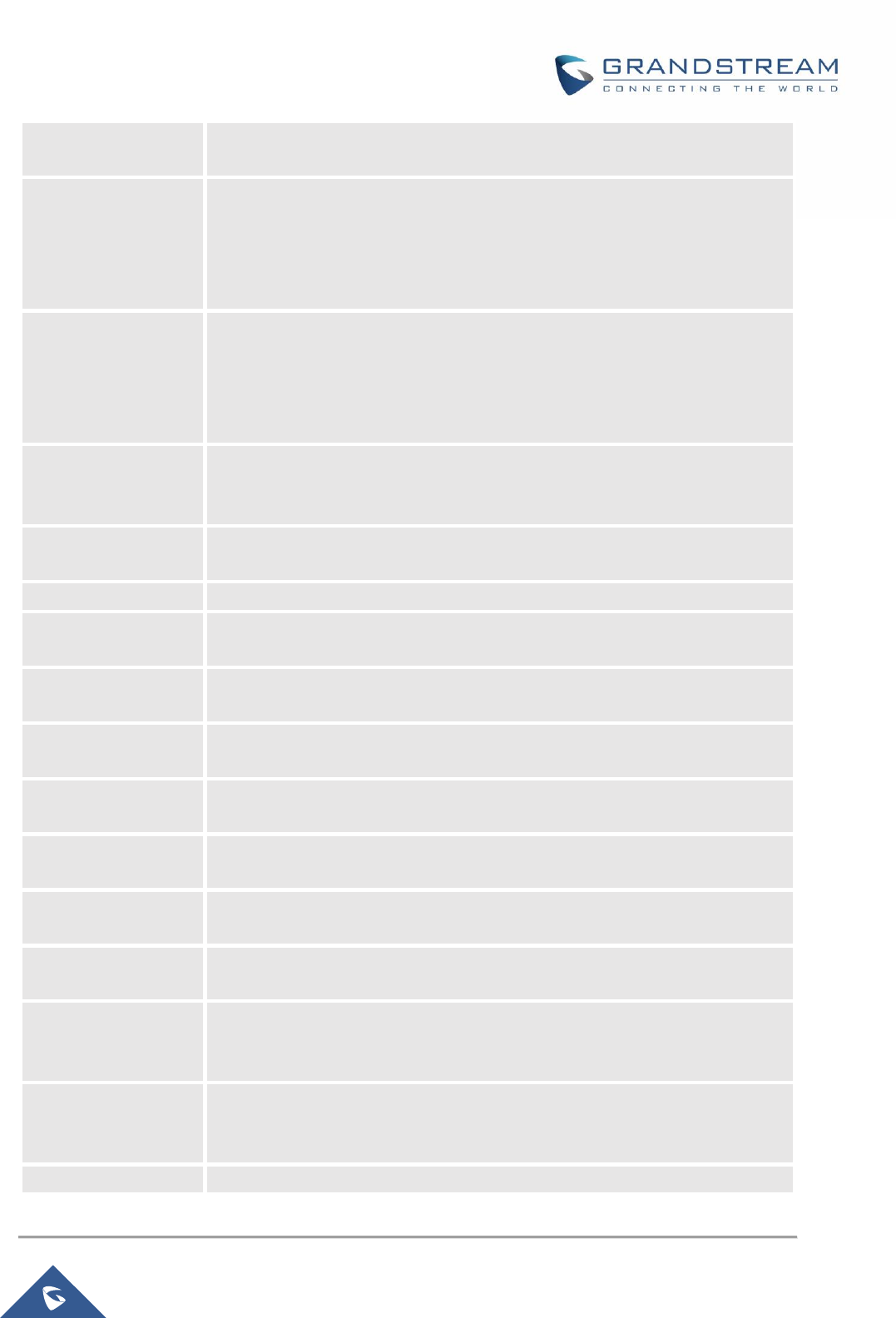
GXP1760W Administration Guide
P a g e | 45
Before Challenge
before being challenged by the server.
The default setting is “No”.
Allow DHCP Option
43 and Option 66
Override Server
Default setting is “Yes”. DHCP option 66 originally was only designed for TFTP
server. And then was extended to support an HTTP URL.
GXP phones support both TFTP and HTTP server via option 66. Users can
also use DHCP option 43 vendor specific option to do this. DHCP option 43
approach has priorities.
Additional Override
DHCP Option
When enabled, users could select Option 150 or Option 160 to override the
firmware server instead of using the configured firmware server path or the
server from option 43 and option 66 in the local network. Please note this option
will be effective only when option “Allow DHCP Option 43 and Option 66 to
Override Server” is enabled. The default setting is “None”.
Allow DHCP Option
120 to override SIP
Server
Enables DHCP Option 120 from local server to override the SIP Server on the
phone. The default setting is "No".
3CX Auto Provision
Enables automatic provision feature on the phone when 3CX is used as the
SIP server. The default setting is "Yes".
Automatic Upgrade
Enables automatic upgrade and provisioning. The default setting is "No".
Hour of the Day
(0-23)
Defines the hour of the day to check the HTTP/TFTP server for firmware
upgrades or configuration files changes. The default value is 1.
Day of the Week
(0-6)
Defines the day of the week to check HTTP/TFTP server for firmware upgrades
or configuration files changes. The default value is 1.
Disable SIP NOTIFY
Authentication
Device will not challenge NOTIFY with 401 when set to “Yes”.
The default setting is “No”.
Config Upgrade Via
Determine the config upgrade method via TFTP, HTTP or HTTPS.
The default setting is “HTTP”.
Config Server Path
Defines the server path for provisioning. It could be different from the firmware
server for upgrading. Default is “fm.grandstream.com/gs”.
Config HTTP/HTTPS
User Name
Defines user name for the HTTP/HTTPS server.
Config HTTP/HTTPS
Password
Defines password for HTTP/HTTPS server.
Config File Prefix
Enables your ITSP to lock configuration updates. If configured, only the
configuration file with the matching encrypted prefix will be downloaded and
flashed into the phone.
Config File Postfix
Enables your ITSP to lock configuration updates. If configured, only the
configuration file with the matching encrypted postfix will be downloaded and
flashed into the phone.
XML Config File
Defines the password for encrypting the XML configuration file using
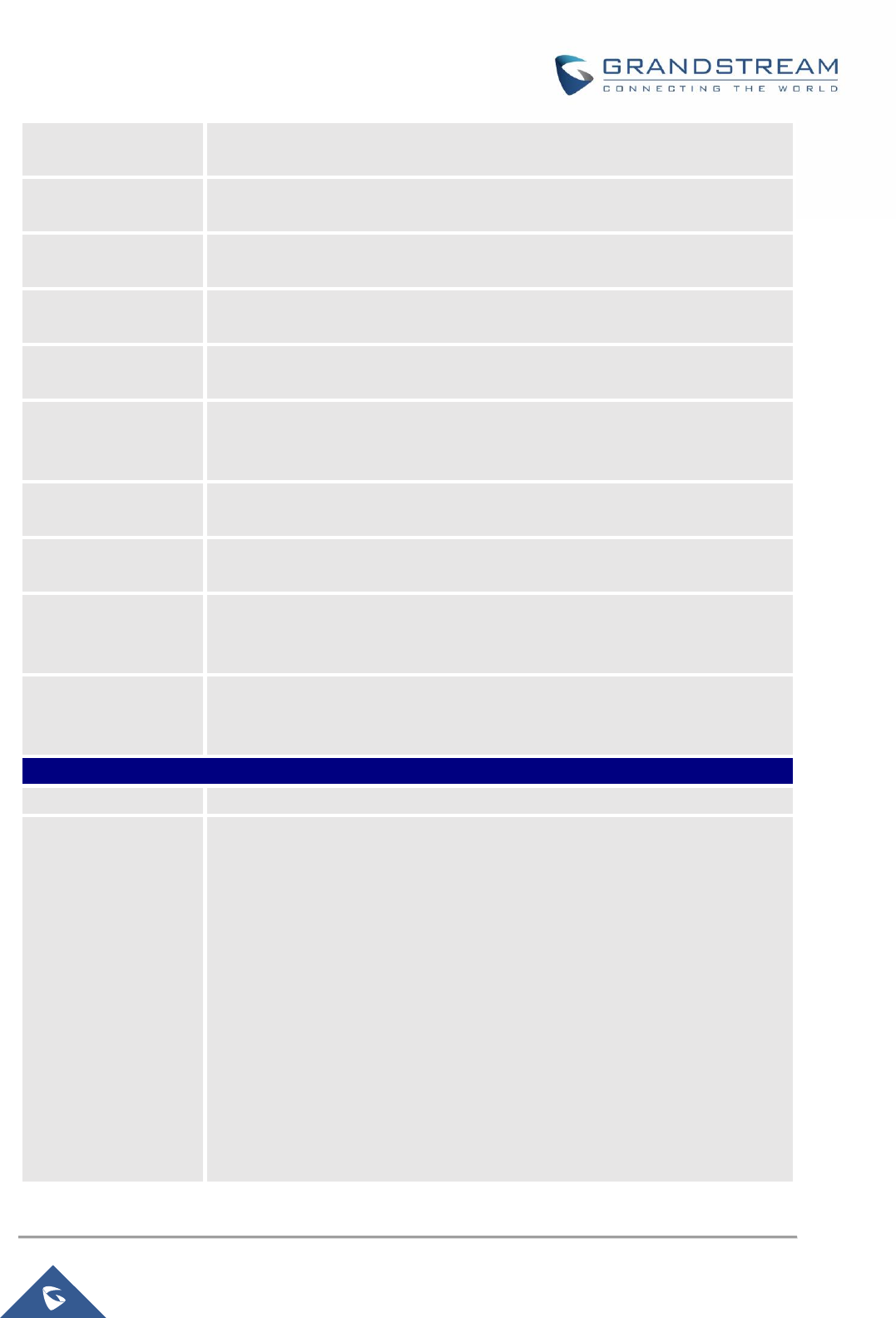
GXP1760W Administration Guide
P a g e | 46
Password
OpenSSL. This is required for the phone to decrypt the encrypted XML
configuration file.
Authenticate Conf
File
Authenticates configuration file before acceptance. Default setting is "No".
Download Device
Configuration
Click to download phone’s configuration file in .txt format.
Upload Device
Configuration
Upload configuration file to phone.
Firmware Upgrade
Via
Allows users to choose the firmware upgrade method: TFTP, HTTP or HTTPS.
The default setting is “HTTP”.
Firmware Server Path
Defines the server path for the firmware server.
It could be different from the configuration server for provisioning. Default is
“fm.grandstream.com/gs”.
Firmware HTTP/
HTTPS User Name
Defines user name for the HTTP/HTTPS server.
Firmware HTTP/
HTTPS Password
Defines password for HTTP/HTTPS server.
Firmware File Prefix
Enables your ITSP to lock firmware updates. If configured, only the firmware
with the matching encrypted prefix will be downloaded and flashed into the
phone.
Firmware File Postfix
Enables your ITSP to lock firmware updates. If configured, only the firmware
with the matching encrypted postfix will be downloaded and flashed into the
phone.
Maintenance Syslog
Syslog Server
The URL or IP address of the syslog server for the phone to send syslog to.
Syslog Level
Selects the level of logging for syslog. The default setting is "None".
There are 4 levels:
DEBUG, INFO, WARNING and ERROR.
Syslog messages are sent based on the following events:
• Product model/version on boot up (INFO level).
• NAT related info (INFO level).
• sent or received SIP message (DEBUG level).
• SIP message summary (INFO level).
• inbound and outbound calls (INFO level).
• registration status change (INFO level).
• negotiated codec (INFO level).
• Ethernet link up (INFO level).
• SLIC chip exception (WARNING and ERROR levels).
• Memory exception (ERROR level).
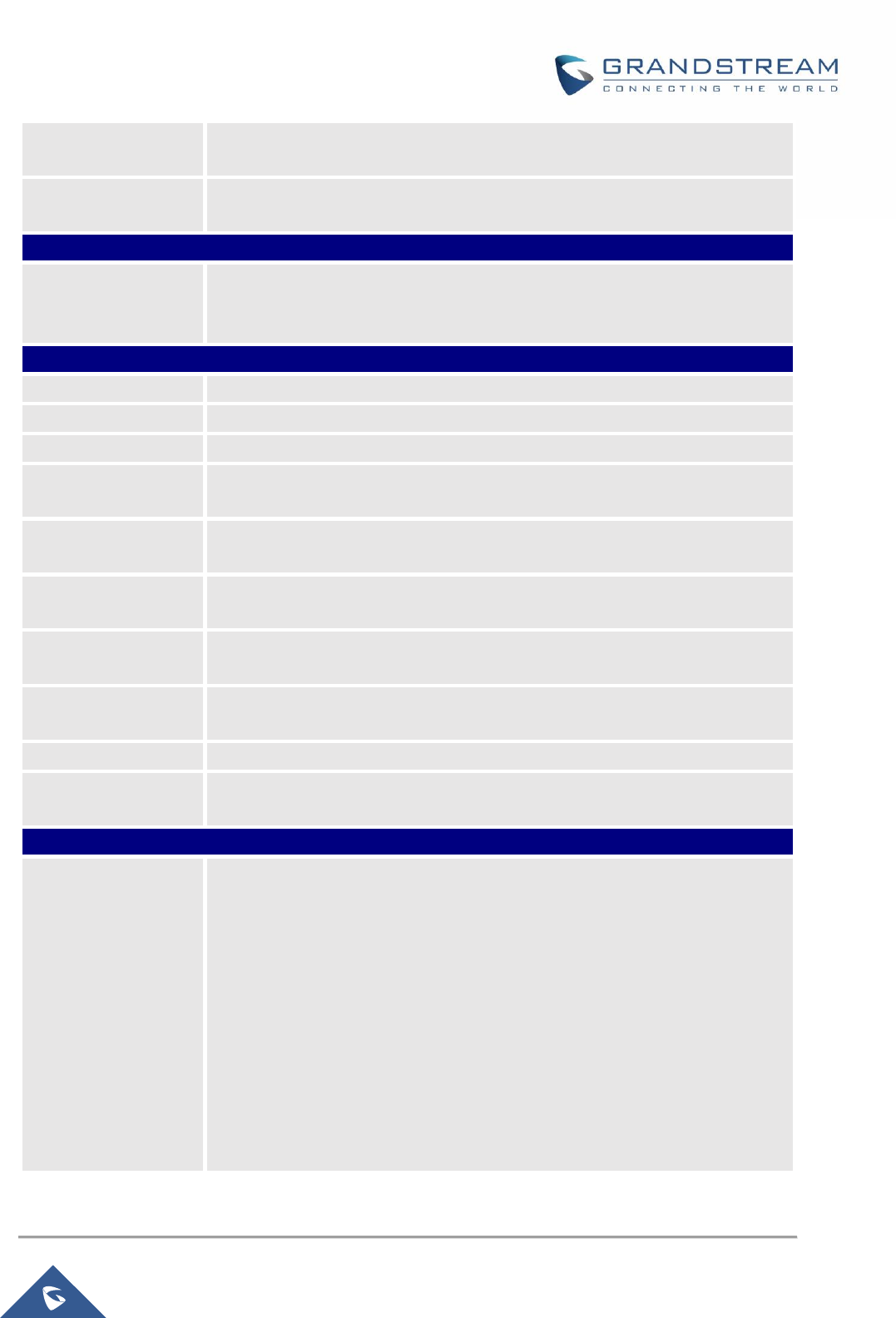
GXP1760W Administration Guide
P a g e | 47
Send SIP Log
Configures whether the SIP log will be included in the syslog messages. The
default setting is "No".
Auto Recover From
Abnormal
If set to “Yes”, the phone will automatically recover when running abnormal.
The default setting is “Yes”.
Maintenance Language
Display Language
Selects display language on the phone. There are 21 languages can be set as
display language, user could also choose “Auto” or “Downloaded Language”
as display language. The default setting is “Auto”.
Maintenance TR-069
ACS URL
URL for TR-069 Auto Configuration Servers (ACS).
TR-069 Username
ACS username for TR-069.
TR-069 Password
ACS password for TR-069.
Periodic Inform
Enable
Enables periodic inform. If set to "Yes", device will send inform packets to the
ACS. The default setting is "No".
Periodic Inform
Interval
Sets up the periodic inform interval to send the inform packets to the ACS.
Connection Request
Username
The user name for the ACS to connect to the phone.
Connection Request
Password
The password for the ACS to connect to the phone.
Connection Request
Port
The port for the ACS to connect to the phone.
CPE SSL Certificate
The Cert File for the phone to connect to the ACS via SSL.
CPE SSL Private
Key
The Cert Key for the phone to connect to the ACS via SSL.
Maintenance Security Settings Security
Configuration via
Keypad Menu
Configures the access control for the users to configure from keypad Menu.
There are three different options.
The default setting is “Unrestricted”:
• Unrestricted
All the options can be accessed in keypad Menu.
• Basic settings only
The SIP option under Phone submenu, and Network, Upgrade, UCM
Detect and Factory Reset options under System submenu will not be
available in LCD Menu.
• Constraint Mode
The phone will require administration password to change the Network,
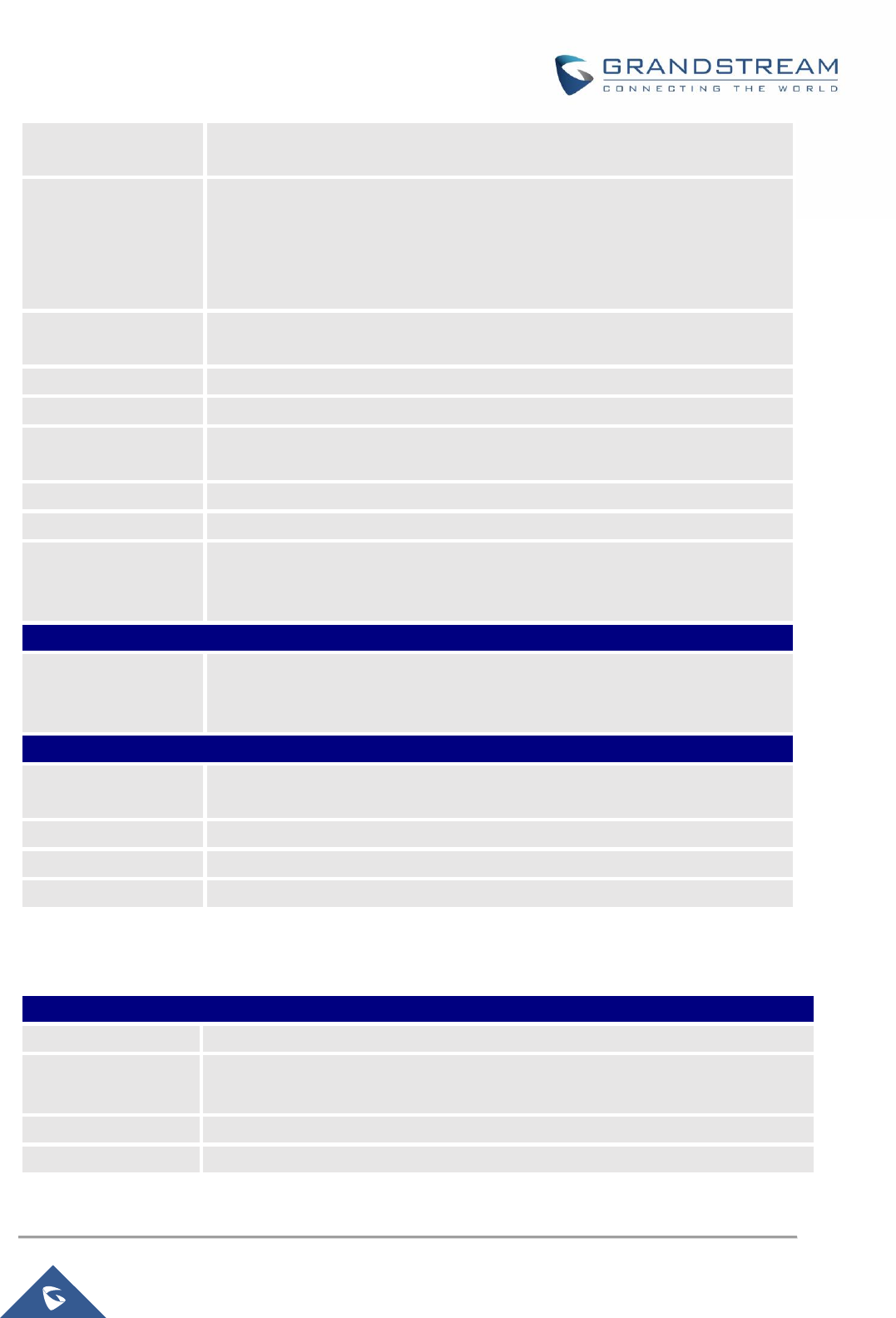
GXP1760W Administration Guide
P a g e | 48
Upgrade and Factory Reset options under System submenu, and SIP
option under Phone submenu as well.
Enable STAR key
Keypad Locking
If set to "Yes", the keypad can be locked by pressing and holding the STAR *
key for about 4 seconds. A lock icon will show indicating the keypad is locked.
The default setting is "Yes".
Note: When the keypad is locked, users would need press and hold the STAR
* key for about 4 seconds again and then enter the password to unlock it.
Password to Lock/
Unlock
Configures the password to lock/unlock the keypad.
SIP TLS Certificate
SSL Certificate used for SIP Transport in TLS/TCP.
SIP TLS Private Key
SSL Private key used for SIP Transport in TLS/TCP.
SIP TLS Private Key
Password
SSL Private key password used for SIP Transport in TLS/TCP.
Web Access Mode
Sets the protocol for web interface. The default setting is “HTTP”.
Disable SSH
Disables SSH access. The default setting is “No”.
Web/Keypad/Restrict
mode Lockout
Duration
Specifies the time in minutes that the web or LCD login interface will be locked
out to user after five login failures. This lockout time is used for web login, STAR
keypad unlock and LCD restrict mode admin login. Range is 0-60 minutes.
Maintenance Security Settings Trusted CA Certificates
Trusted CA
Certificates
Upload CA Certificate file to phone.
Note: Users can also provision the Trust CA Certificate option with XML
configuration file.
Maintenance Packet Capture
Capture Location
Choose location where the capture will be stored, either on the internal storage
or on the connected USB. Default is “Internal Storage”.
With RTP Packets
Defines whether packet capture file contains RTP or not. Default setting is “No”.
USB File Name
Defines the filename of the capture. Only required for USB.
Start/Stop/Download
Click to Start/Stop and Download the packet capture.
Phonebook Page Definitions
Table 9: Phonebook Page Definitions
Phonebook Contacts
Group
Specifies to which group the contact belong.
Add Contact
Specifies Contact’s First Name, Last Name, Phone Number, Accounts and Groups
to add one new contact in phonebook.
Edit Contact
Edits selected contact.
Delete All Contacts
Deletes all contacts from phonebook.
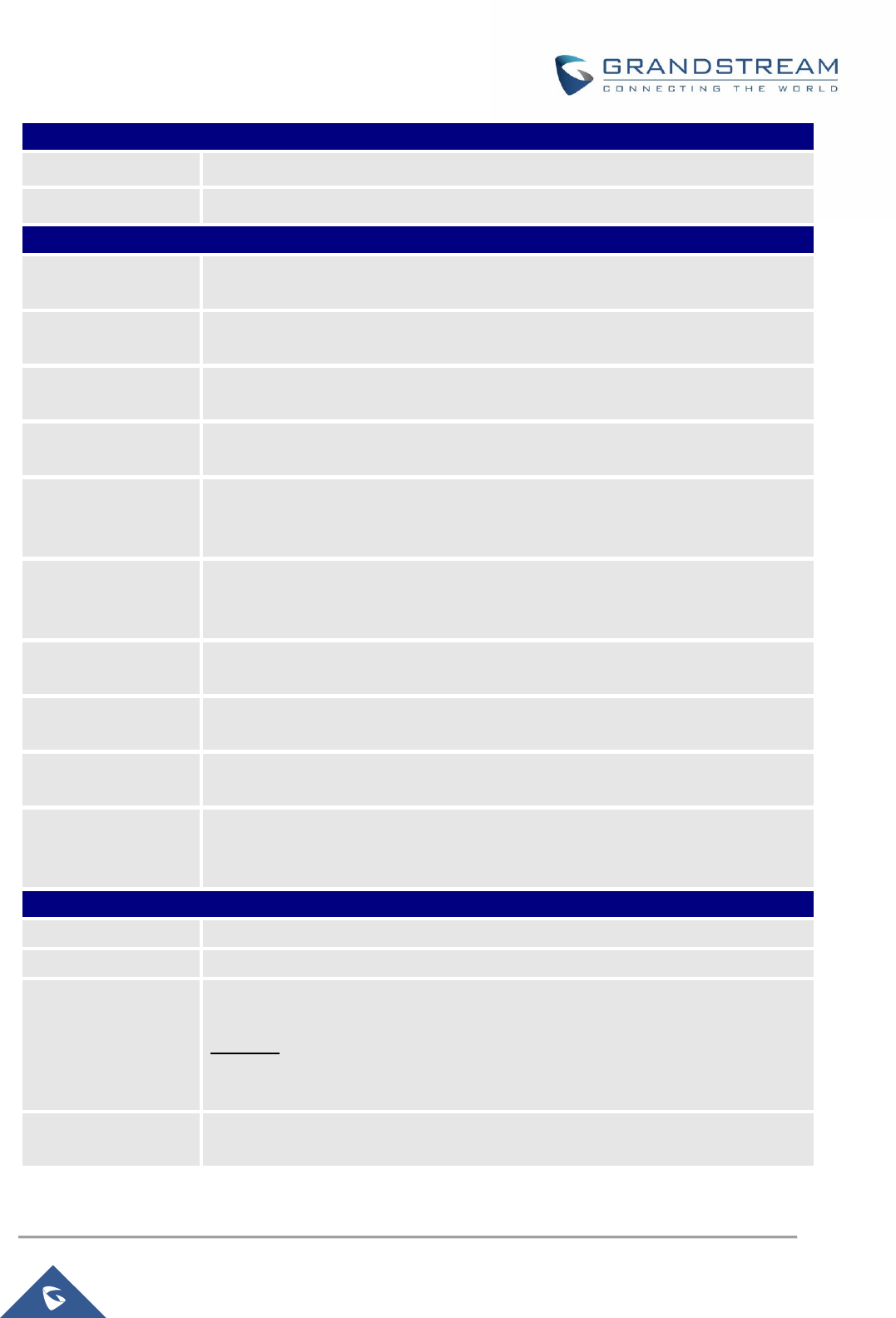
GXP1760W Administration Guide
P a g e | 49
Phonebook Group Management
Add Group
Specifies Group’s name to add new group.
Edit Group
Edits selected group.
Phonebook Phonebook Management
Enable Phonebook
XML Download
Configures to enable phonebook XML download. Users could select
HTTP/HTTPS/TFTP to download the phonebook file. Default setting is "Disabled".
HTTP/HTTPS User
Name
The user name for the HTTP/HTTPS server.
HTTP/HTTPS
Password
The password for the HTTP/HTTPS server.
Phonebook XML
Server Path
Configures the server path to download the phonebook XML. This field could be
IP address or URL, with up to 256 characters.
Phonebook
Download Interval
Configures the phonebook download interval (in minutes). If it's set to 0, the
automatic download will be disabled. Default value is 0. Valid range is 5 to 720
minutes.
Remove Manually-
edited Entries on
Download
If set to "Yes", when XML phonebook is downloaded, the entries added manually
will be automatically removed. The default setting is "Yes".
Sort Phonebook by
Sort phonebook based on the selection of first name or last name. The default
setting is “Last Name”.
Download XML
Phonebook
Click on "Download" to download the XML phonebook file to local PC.
Upload XML
Phonebook
Click on "Upload" to upload local XML phonebook file to the phone.
Phonebook Key
Function
Control the behavior of phonebook key. There are five options: Default, LDAP
Search, Local Phonebook, Local Group, and Broadsoft Phonebook. The default
setting is “Default”, when user presses it, phone LCD will show the five options.
Phonebook LDAP
Server Address
Configures the IP address or DNS name of the LDAP server.
Port
Configures the LDAP server port. The default port number is “389”.
Base
Configures the LDAP search base. This is the location in the directory where the
search is requested to begin.
Example:
dc=grandstream, dc=com
ou=Boston, dc=grandstream, dc=com
User Name
Configures the bind "Username" for querying LDAP servers. Some LDAP servers
allow anonymous binds in which case the setting can be left blank.
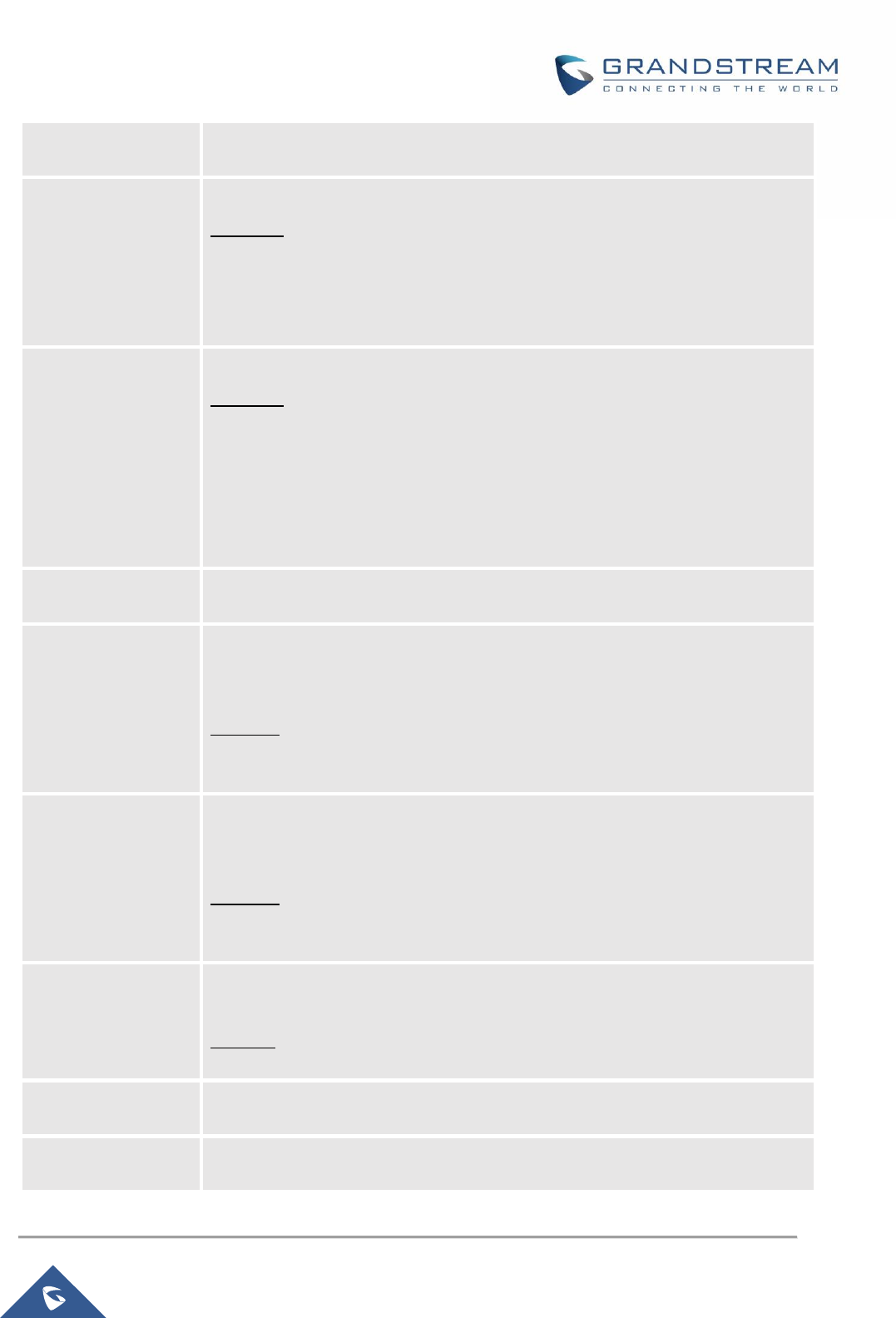
GXP1760W Administration Guide
P a g e | 50
Password
Configures the bind "Password" for querying LDAP servers. The field can be left
blank if the LDAP server allows anonymous binds.
LDAP Number Filter
Configures the filter used for number lookups.
Examples:
(|(telephoneNumber=%)(Mobile=%) returns all records which has the
"telephoneNumber" or "Mobile" field starting with the entered prefix.
(&(telephoneNumber=%) (cn=*)) returns all the records with the
"telephoneNumber" field starting with the entered prefix and "cn" field set.
LDAP Name Filter
Configures the filter used for name lookups.
Examples:
(|(cn=%)(sn=%)) returns all records which has the "cn" or "sn" field starting with
the entered prefix.
(!(sn=%)) returns all the records which do not have the "sn" field starting with the
entered prefix.
(&(cn=%) (telephoneNumber=*)) returns all the records with the "cn" field starting
with the entered prefix and "telephoneNumber" field set.
LDAP Version
Selects the protocol version for the phone to send the bind requests.
The default setting is "Version 3".
LDAP Name
Attributes
Specify the "name" attributes of each record which are returned in the LDAP
search result. This field allows the users to configure multiple space separated
name attributes.
Example:
gn
cn sn description
LDAP Number
Attributes
Specifies the "number" attributes of each record which are returned in the LDAP
search result. This field allows the users to configure multiple space separated
number attributes.
Example:
telephoneNumber
telephoneNumber Mobile
LDAP Display Name
Configures the entry information to be shown on phone's LCD. Up to 3 fields can
be displayed.
Example:
%cn %sn %telephoneNumber
Max. Hits
Specifies the maximum number of results to be returned by the LDAP server. If
set to 0, server will return all search results. The default setting is 50.
Search Timeout
Specifies the interval (in seconds) for the server to process the request and client
waits for server to return. The default setting is 30 seconds.
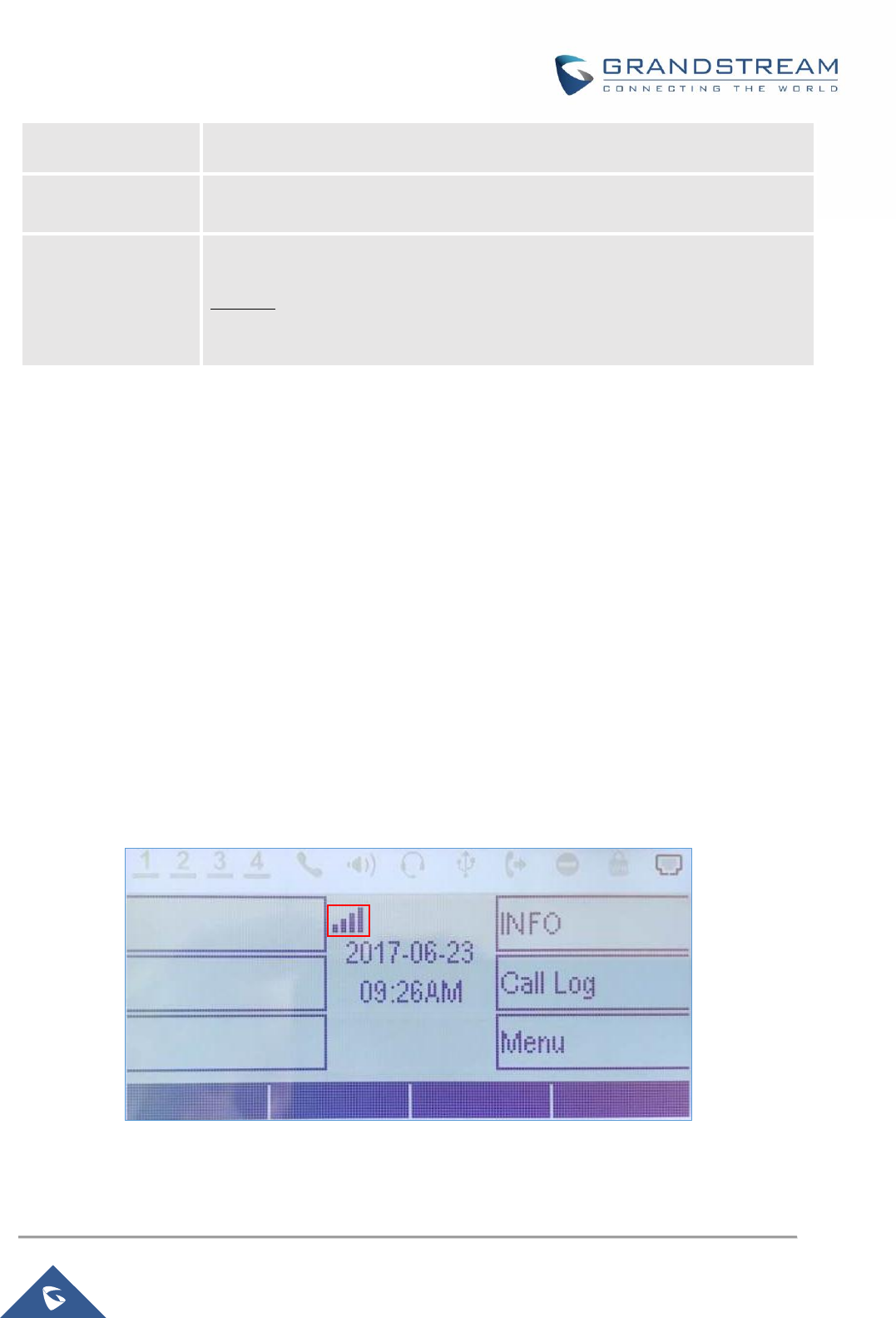
GXP1760W Administration Guide
P a g e | 51
Sort Results
Specifies whether the searching result is sorted or not. Default setting is "No".
LDAP Lookup
Configures to enable LDAP number searching when dialing and receiving calls.
Lookup Display
Name
Configures the display name when LDAP looks up the name for incoming call or
outgoing call. This field must be a subset of the LDAP Name Attributes.
Example:
gn
cn sn description
Connecting the GXP1760W to WiFi
There are two methods for connecting the GXP1760W to WiFi network, through the web GUI or using the
keypad menu. Please refer to the following detailed steps:
Using the WebGUI
To connect the GXP1760W to Wifi Network through the web GUI. Please refer to following steps:
1. Access the web GUI using the administrator username and password. (Default username and
password is: admin/admin).
2. Navigate to Network WiFi Settings and enable the WiFi.
3. Under Access Point(x) fields do the following:
- Specifies the SSID for the desired WiFi network under SSID.
- Configures the Password to access the WiFi network.
- Specifies the WiFi encryption type under Security Type.
4. Press Save and Apply button to save the WiFi settings.
If the WiFi settings are configured correctly, the GXP1760W will connect to the WiFi network automatically
and display WiFi logo on the main LCD menu as displayed on the following figure.
Figure 2: WiFi Signal Icon on the GXP1760W Main LCD Menu
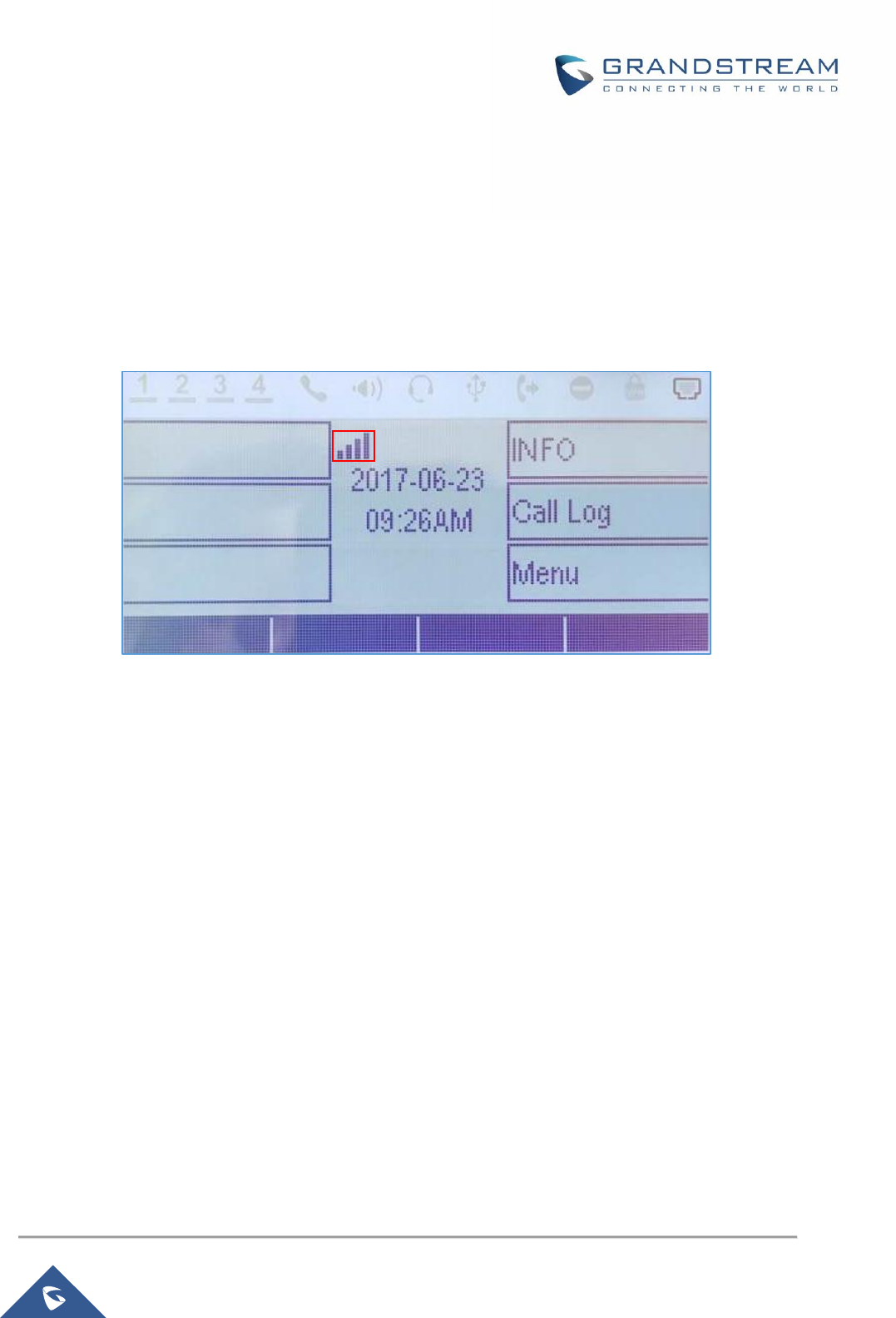
GXP1760W Administration Guide
P a g e | 52
Using the Keypad Menu
To connect the GXP1760W to WiFi Network through the keypad menu. Please refer to following steps:
1. On LCD menu, navigate to System Network WiFi settings and enable WiFi.
2. Select “Scan” and GXP1760W will automatically start scanning within the range.
3. A list of WiFi networks will be displayed. Select the desired network, and if required, enter the
correct password to connect.
If the WiFi settings are configured correctly, the GXP1760W will connect to the WiFi network
automatically and display WiFi logo on the main LCD menu as displayed on the following figure.
Figure 3: WiFi Signal Icon on the GXP1760W Main LCD Menu
NAT Settings
If the devices are kept within a private network behind a firewall, we recommend using STUN Server. The
following settings are useful in the STUN Server scenario:
• STUN Server
Under SettingsGeneral Settings, enter a STUN Server IP (or FQDN) that you may have, or look up
a free public STUN Server on the internet and enter it on this field. If using Public IP, keep this field
blank.
• Use Random Ports
It is under SettingsGeneral Settings. This setting depends on your network settings. When set to
"Yes", it will force random generation of both the local SIP and RTP ports. This is usually necessary
when multiple GXPs are behind the same NAT. If using a public IP address, set this parameter to "No".
• NAT Traversal
It is under Accounts XNetwork Settings. Default setting is "No". Enable the device to use NAT
traversal when it is behind firewall on a private network. Select Keep-Alive, Auto, STUN (with STUN
server path configured too) or other option according to the network setting.
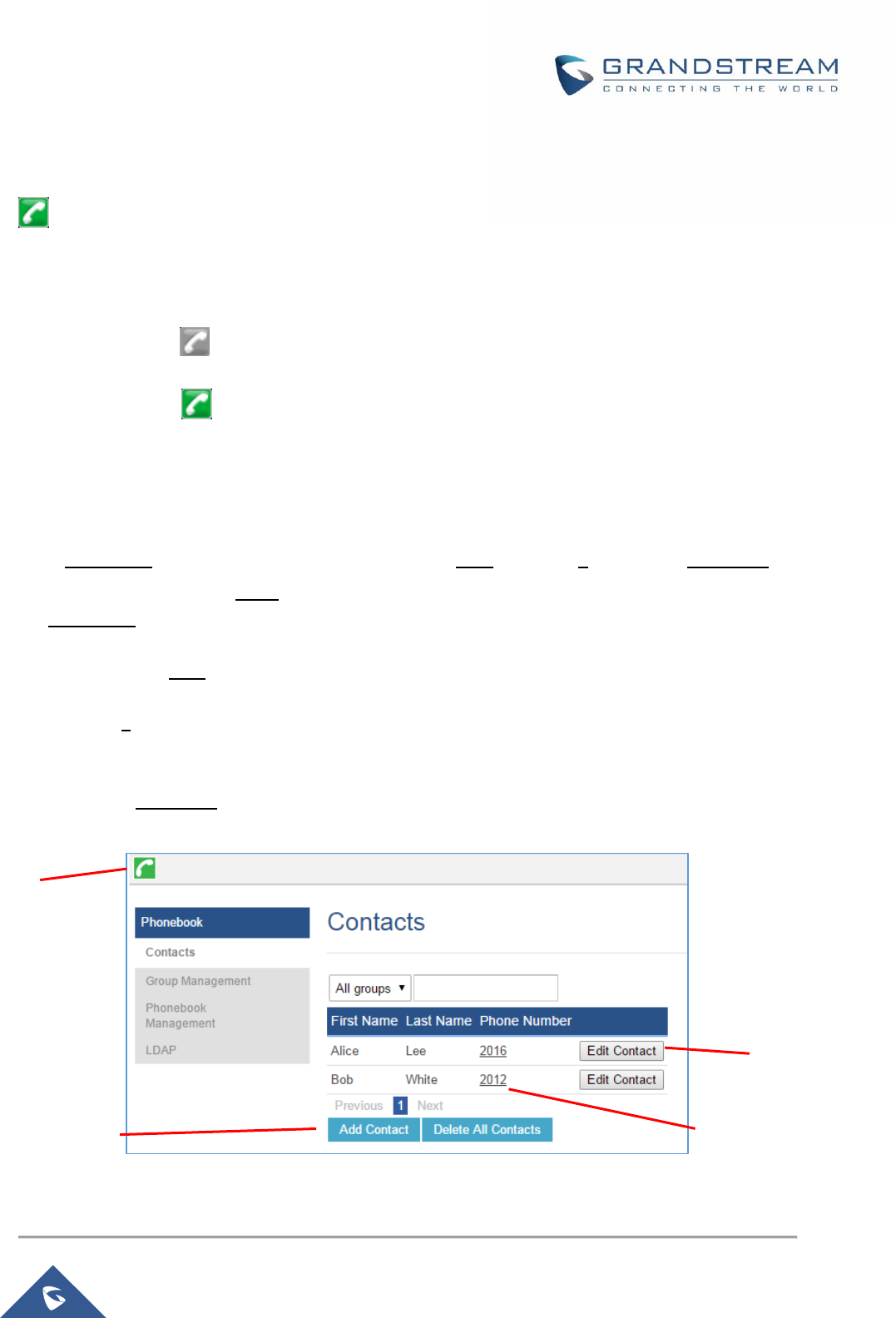
GXP1760W Administration Guide
P a g e | 53
Editing Contacts and Click-To-Dial
From GXP1760W Web GUI, users could view contacts, edit contacts, or dial out with Click-to-Dial feature
on the top of the Web GUI. In the following figure, the Contact page shows all the added contacts
(manually or downloaded via XML phonebook). Here users could add new contact, edit selected contact,
or dial the contact/number. Before using the Click-To-Dial feature, make sure the option "Click-To-Dial
Feature" under web GUISettingsCall Features is turned on. By default, it's disabled and the dialing icon
in web GUI is in grey .
When clicking on the icon on the top menu of the Web GUI, a new dialing window will show for you
to enter the number. Once Dial is clicked, the phone will go off hook and dial out the number from selected
account. Please see Figure 11 in the following pages for more details.
Additionally, users could directly send the command for the phone to dial out by specifying the following
URL in PC's web browser, or in the field as required in other call modules.
http://ip_address/cgi-bin/api-make_call?phonenumber=1234&account=0&password=admin/123
In the above link, replace the fields with:
• ip_address:
Phone's IP Address.
• phonenumber=1234:
The number for the phone to dial out.
• account=0:
The account index for the phone to make call. The index is 0 for account 1, 1 for account 2, 2 for account
3, and etc.
• password=admin/123:
The admin login password or user login password of phone's Web GUI.
Figure 4: Web GUI - PhonebookContacts
Add contacts
Edit contact
Click to call this contact
from the phone
Click to dial from
available lines
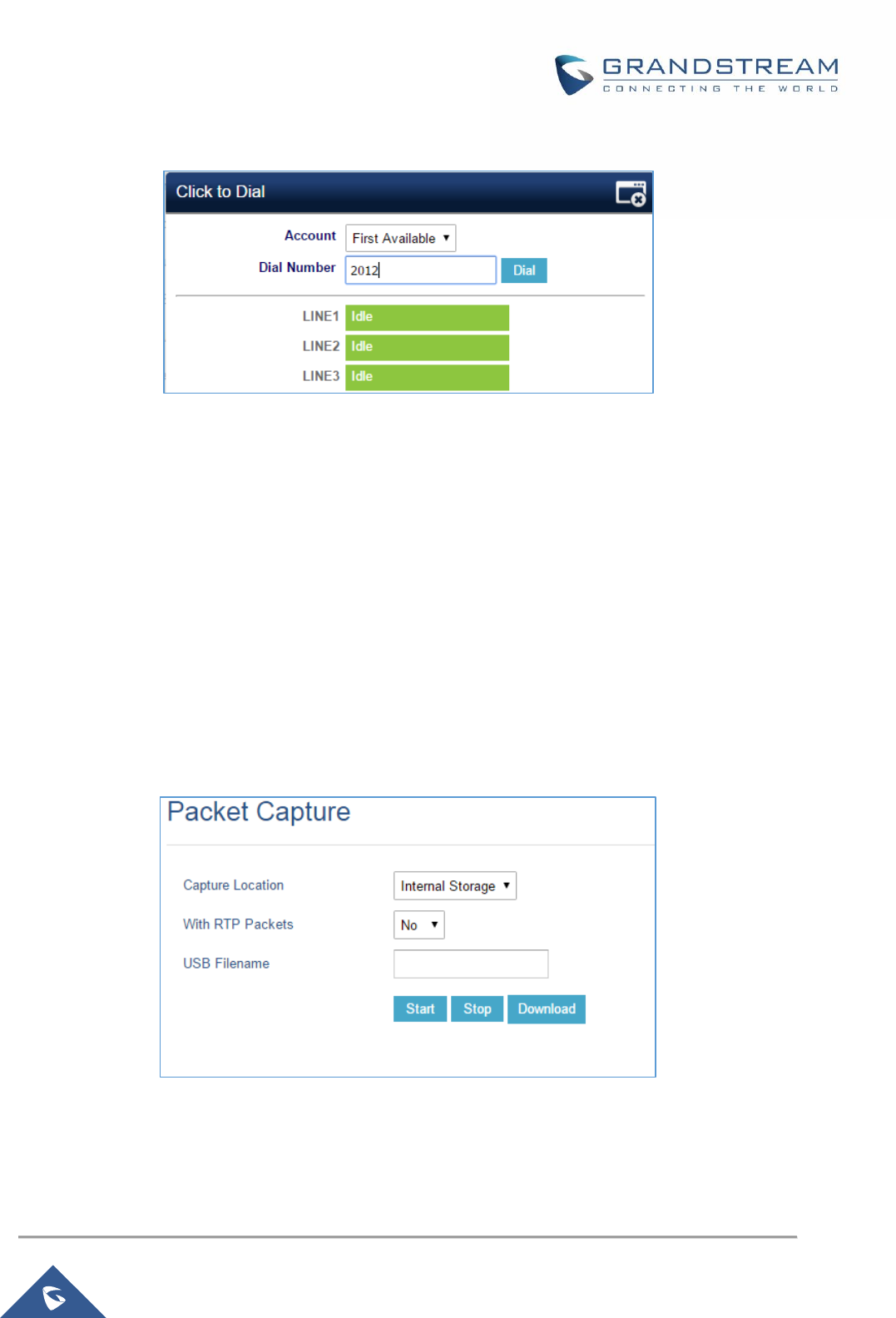
GXP1760W Administration Guide
P a g e | 54
Figure 5: Click-to-Dial
Saving Configuration Changes
After users makes changes to the configuration, press the "Save" button will save but not apply the changes
until the "Apply" button on the top of web GUI page is clicked. Or, users could directly press "Save and
Apply" button. We recommend rebooting or powering cycle the phone after applying all the changes.
Rebooting from Remote Locations
Press the "Reboot" button on the top right corner of the web GUI page to reboot the phone remotely. The
web browser will then display a reboot message. Wait for about 1 minute to log in again.
Packet Capture
GXP1760W is embedded with packet capture function on firmware 1.0.0.38 or greater. The related options
are under Maintenance Packet Capture.
Figure 6: Packet Capture in Idle
Users need to choose first the capture location either the internal storage or the connected USB and then
press Start button to start packet capture. Press Stop to end capture.
User can press Download button to download capture file to local PC.

GXP1760W Administration Guide
P a g e | 55
Note:
- User can also define whether RTP packets will be captured or not using With RTP Packets option.
- USB Filename is only required for USB and it defines the capture filename.
Multicast Paging
GXP1760W supports multicast paging, including sending and listening. On the phone, users could send
multicast page by setting the multicast address and port. Also, users can listen to at most 10-different
multicast IP address.
Multicast sender related settings are under Web UI, SettingsProgrammable keys. Select Multicast
paging as the key mode for dial page call. Multicast paging listening related settings are under Web UI
SettingsMulticast Paging.
For more details on Multicast paging features, please visit http://www.grandstream.com/support to
download the latest “ Multicast Paging User Guide”.
Configuring Eventlist BLF
Grandstream GXP1760W Enterprise IP Phones support both Grandstream UCM Busy Lamp Filed and
Eventlist BLF features and allows end users, such as attendant, to monitor the call status of users in the
list. GXP1760W supports this feature by sending out the subscription request to the UCM and changing the
indicator status of the Line keys, MPKs, or virtual MPKs that associated with the monitored users.
Additionally, the phone is also able to pick up the calls to the monitored extensions by using a pre-defined
feature code called BLF- Call-pickup Prefix.
For more details on Eventlist BLF configuration, please refer to following guide: Eventlist BLF Guide
Configuring VPK Keys
Grandstream GXP1760W Enterprise IP Phones support VPK (“Virtual Multi-Purpose Keys”) feature to add
more flexibility and provide better user experience using Multi-Purpose Keys modes. With the new VPK
feature design, line keys can be assigned with multiple functions. Users have also the ability to add more
VPKs which will be displayed on different screens.
For more details on VPK configuration, please refer to following guide: VPK Configuration Guide
Outbound Notification Support
Outbound notification option can be found under device web UISettingsOutbound Notifications. In the
web UI, under Outbound Notifications: “Action URL” can be found.
To use Outbound NotificationAction URL, users need to know the supported events and the dynamic
variables for the supported events. The dynamic variables for the supported events will be replaced by the
actual values on the phone in order to notify the event to SIP server.
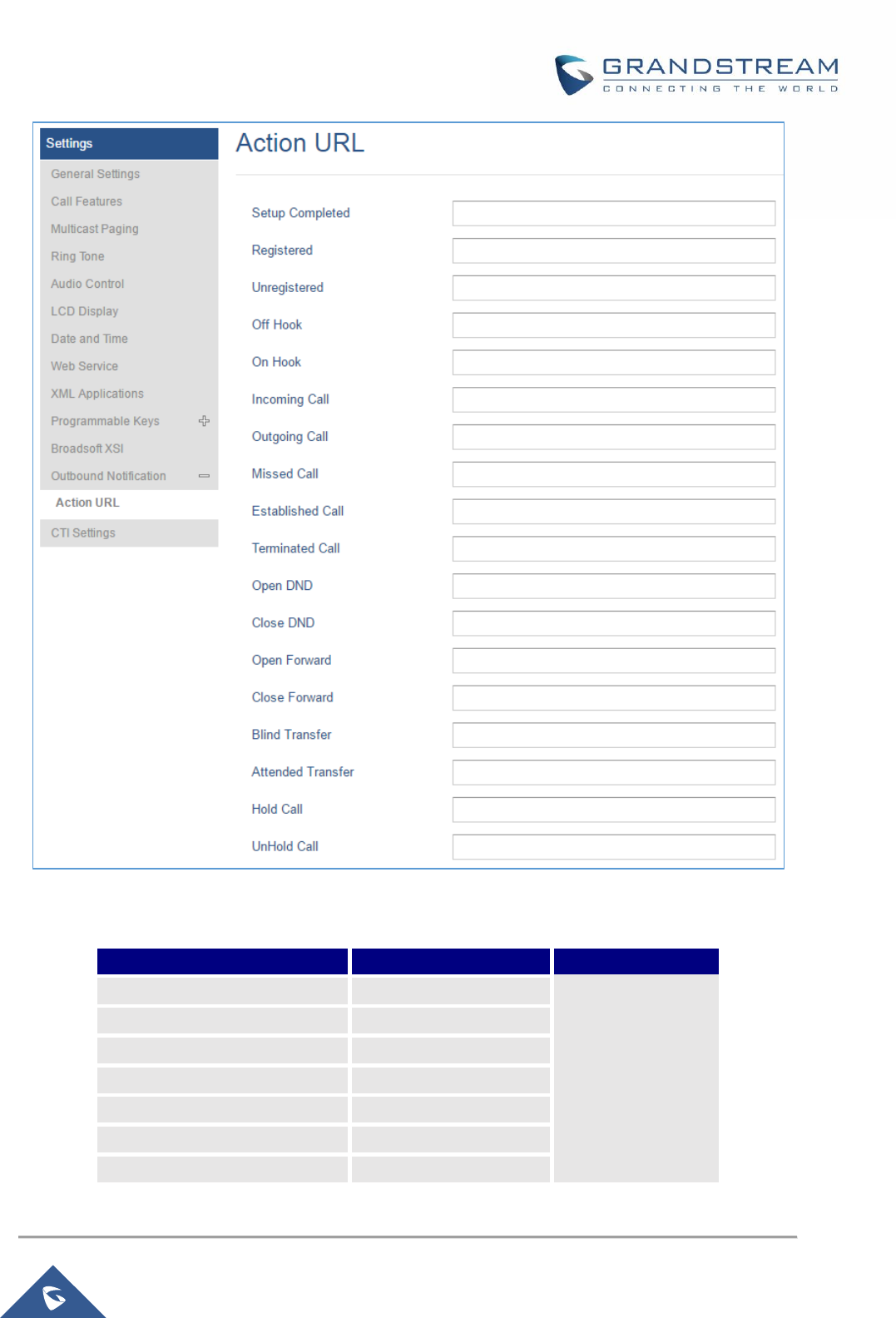
GXP1760W Administration Guide
P a g e | 56
Figure 7: Action URL Settings Page
Table 10: Action URL - Supported Events
Supported Events
P Values
Valid Format
Setup Completed
P8304
Registered
P8305
Unregistered
P8306
Off Hook
P8308
On Hook
P8309
String
Incoming Call
P8310
Outgoing Call
P8311
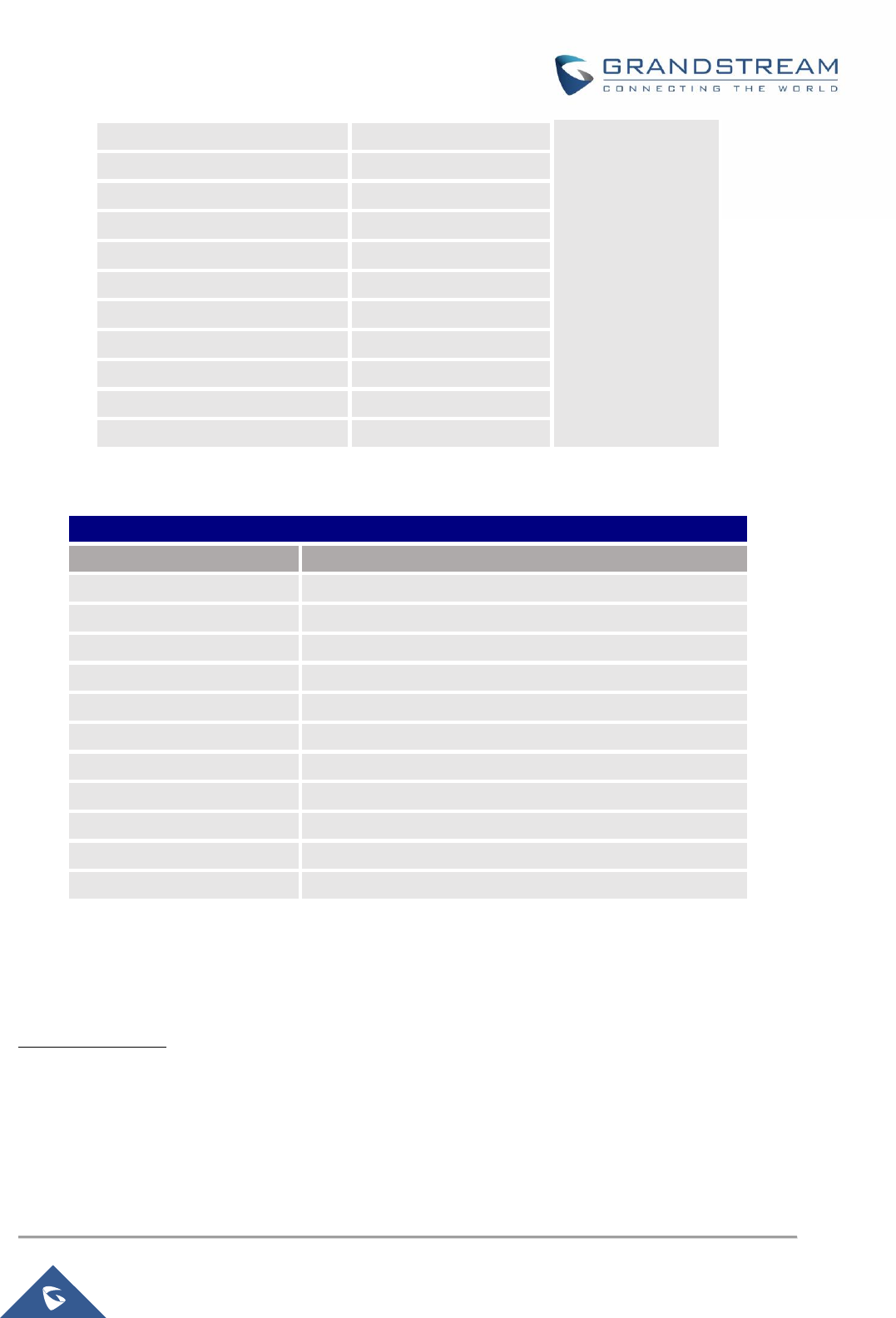
GXP1760W Administration Guide
P a g e | 57
Missed Call
P8312
Established Call
P8313
Terminated Call
P8314
Open DND
P8316
Close DND
P8317
Open Forward
P8318
Close Forward
P8319
Blind Transfer
P8320
Attended Transfer
P8321
Hold Call
P8324
UnHold Call
P8325
Table 11: Action URL – Supported Dynamic Variables
Supported Dynamic Variables
Dynamic Variable
Description
$phone_ip
The IP address of the phone.
$mac
The MAC address of the phone.
$product
The product name of the phone.
$program_version
The software version of the phone.
$hardware_version
The hardware version of the phone.
$language
The display language of the phone.
$local
The called number on the phone.
$display_local
The display name of the called number on the phone.
$remote
The call number on the remote phone.
$display_remote
The display name of the call number on the remote phone.
$active_user
The account number during a call on the phone.
After the user finishes setting Action URL on phone’s web UI, when the specific phone event occurs on the
phone, phone will send the Action URL to the specified SIP server. The dynamic variables in the Action URL
will be replaced by the actual values.
Here is an example:
Configure the following Action URL on the phone’s web UISettingsOutbound NotificationAction URL:
Incoming Call: 192.168.5.250/mac=$mac&display_remote =$display_remote
Outgoing Call: 192.168.5.250/remote=$remote&phone_ip=$phone_ip
On Hold: 192.168.5.250/program_version=$program_version
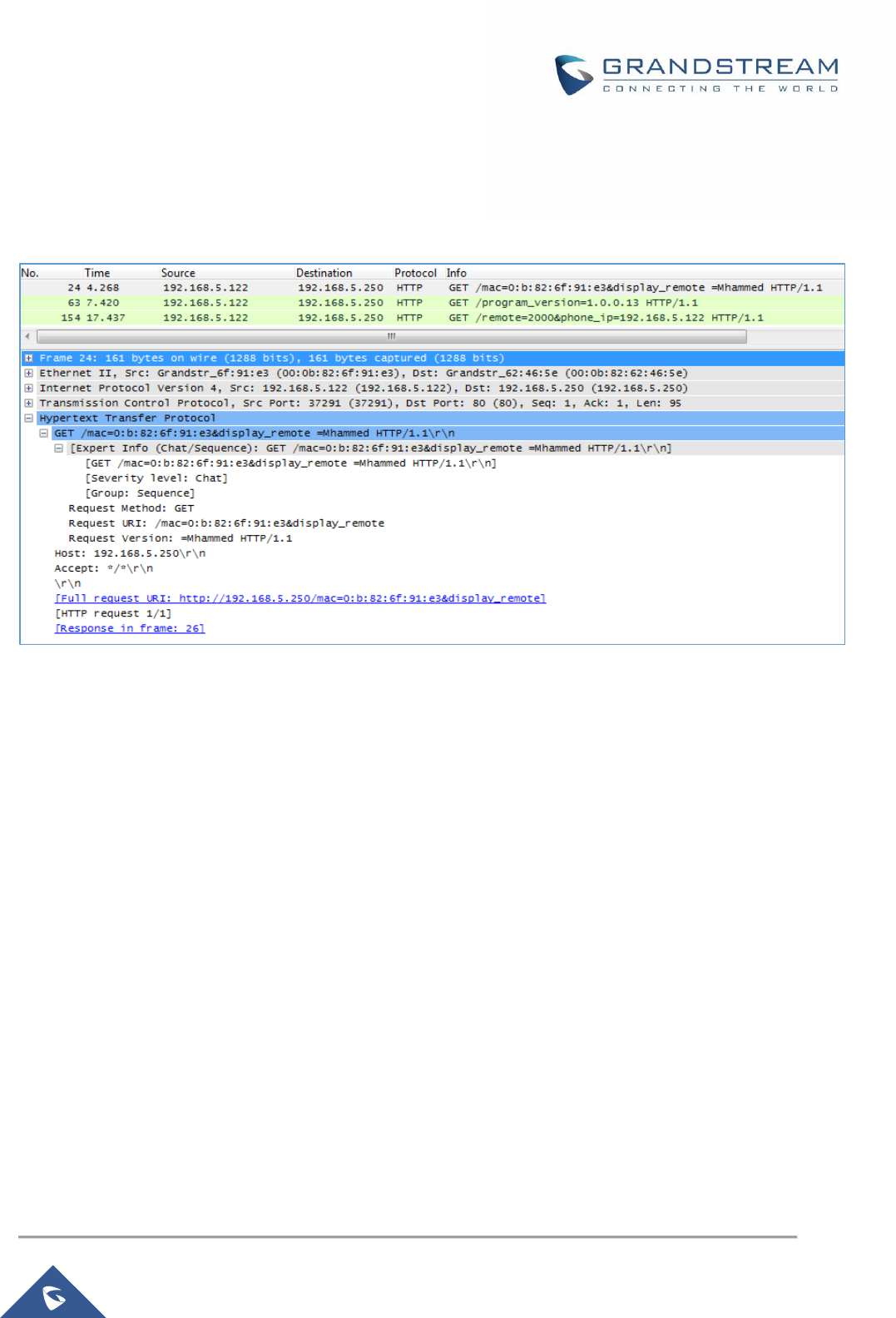
GXP1760W Administration Guide
P a g e | 58
During incoming call, outgoing call and call hold, capture the trace on the phone and check the packets.
We can see the phone send Action URL with actual values to SIP server to notify phone events. In the
following screenshot, from top to bottom, the phone events for each HTTP message are: Incoming Call,
hold call and Outgoing Call in the format of the defined action URL with the parameters replaced with actual
values.
Figure 8: Action URL Packets

GXP1760W Administration Guide
P a g e | 59
UPGRADING AND PROVISIONING
The GXP1760W can be upgraded via TFTP/HTTP/HTTPS by configuring the URL/IP Address for the
TFTP/HTTP/HTTPS server and selecting a download method. Configure a valid URL for TFTP or
HTTP/HTTPS, the server name can be FQDN or IP address.
Examples of valid URLs:
firmware.grandstream.com
fw.ipvideotalk.com/gs
There are two ways to setup a software upgrade server: The LCD Keypad Menu or the Web Configuration
Interface.
Upgrade via Keypad Menu
Follow the steps below to configure the upgrade server path via phone's keypad menu:
1. Press MENU button and navigate using Up/Down arrow to select System.
2. In the System options, select Upgrade.
3. In the Upgrade options, select Firmware Upgrade Via.
4. Select the upgrade method and press “OK”.
5. In the Upgrade options, select Firmware Server.
6. In the Firmware Server options, select Self-defined Firmware Server.
7. Enter the firmware server path and press the “OK” softkey.
8. The device may prompt for reboot to upgrade.
Note: If not using DHCP option 66/43, please set the setting to “No”.
When upgrading starts, the screen will show upgrading progress. When done, you will see the phone
restarts again. Please do not interrupt or power cycle the phone when the upgrading process is on.
Upgrade via Web GUI
Open a web browser on PC and enter the IP address of the phone. Then, login with the administrator
username and password. Go to MaintenanceUpgrade and Provisioning page, enter the IP address or the
FQDN for the upgrade server in "Firmware Server Path" field and choose to upgrade via TFTP or
HTTP/HTTPS. Update the change by clicking the "Save and Apply" button. Then "Reboot" or power cycle
the phone to update the new firmware.
When upgrading starts, the screen will show upgrading progress. When done, you will see the phone restart
again. Please do not interrupt or power cycle the phone when the upgrading process is on.

GXP1760W Administration Guide
P a g e | 60
Firmware upgrading takes around 60 seconds in a controlled LAN or 5-10 minutes over the Internet. We
recommend completing firmware upgrades in a controlled LAN environment whenever possible.
No Local TFTP/HTTP Servers
For users that would like to use remote upgrading without a local TFTP/HTTP server, Grandstream offers
a NAT-friendly HTTP server. This enables users to download the latest software upgrades for their phone
via this server. Please refer to the webpage:
http://www.grandstream.com/support/firmware
Alternatively, users can download a free TFTP or HTTP server and conduct a local firmware upgrade. A
free windows version TFTP server is available for download from :
http://www.solarwinds.com/products/freetools/free_tftp_server.aspx
http://tftpd32.jounin.net/.
Instructions for local firmware upgrade via TFTP:
1. Unzip the firmware files and put all of them in the root directory of the TFTP server.
2. Connect the PC running the TFTP server and the phone to the same LAN segment.
3. Launch the TFTP server and go to the File menuConfigureSecurity to change the TFTP server's
default setting from "Receive Only" to "Transmit Only" for the firmware upgrade.
4. Start the TFTP server and configure the TFTP server in the phone’s web configuration interface.
5. Configure the Firmware Server Path to the IP address of the PC.
6. Update the changes and reboot the phone.
Note: Please disable any firewall on your PC to ensure proper connection with external devices.
End users can also choose to download a free HTTP server from http://httpd.apache.org/ or use
Microsoft IIS web server.

GXP1760W Administration Guide
P a g e | 61
Configuration File Download
Grandstream SIP Devices can be configured via the Web Interface as well as via a Configuration File
(binary or XML) through TFTP or HTTP/HTTPS. The "Config Server Path" is the TFTP or HTTP/HTTPS
server path for the configuration file. It needs to be set to a valid URL, either in FQDN or IP address format.
The "Config Server Path" can be the same or different from the "Firmware Server Path".
A configuration parameter is associated with each particular field in the web configuration page. A
parameter consists of a Capital letter P and 2 to 3 (Could be extended to 4 in the future) digit numeric
numbers. i.e., P2 is associated with the "New Password" in the Web GUIMaintenanceWeb Access
pageAdmin Password. For a detailed parameter list, please refer to the corresponding firmware release
configuration template.
When the GXP1760W boots up or reboots, it will issue a request to download a configuration XML file
named "cfgxxxxxxxxxxxx.xml" followed by a file named "cfgxxxxxxxxxxxx", where "xxxxxxxxxxxx" is the
MAC address of the phone, i.e., "cfg000b820102ab.xml" and "cfg000b820102ab". If the download of
"cfgxxxxxxxxxxxx.xml" file is not successful, the provision program will download a generic cfg.xml file. The
configuration file name should be in lower case letters.
For more details on XML provisioning, please refer to:
http://www.grandstream.com/sites/default/files/Resources/gs_provisioning_guide.pdf

GXP1760W Administration Guide
P a g e | 62
RESTORE FACTORY DEFAULT SETTINGS
Warning:
Restoring the Factory Default Settings will delete all configuration information on the phone. Please backup
or print all the settings before you restore to the factory default settings. Grandstream is not responsible for
restoring lost parameters and cannot connect your device to your VoIP service provider.
Please follow the instructions below to reset the phone:
1. Press MENU button to bring up the keypad configuration menu.
2. Select "System" and enter.
3. Select "Factory Reset".
4. A warning window will pop out to make sure a reset is requested and confirmed.
5. Press "OK" softkey to confirm and the phone will reboot. To cancel the Reset, press “Back” softkey
instead.

GXP1760W Administration Guide
P a g e | 63
EXPERIENCING THE GXP1760W
Please visit our website: http://www.grandstream.com to receive the most up- to-date updates on firmware
releases, additional features, FAQs, documentation and news on new products.
We encourage you to browse our product related documentation, FAQs and User and Developer Forum
for answers to your general questions. If you have purchased our products through a Grandstream
Certified Partner or Reseller, please contact them directly for immediate support.
Our technical support staff is trained and ready to answer all of your questions. Contact a technical support
member or submit a trouble ticket online to receive in-depth support.
Thank you again for purchasing Grandstream IP phone, it will be sure to bring convenience and color to
both your business and personal life.
FCC Caution.
This device complies with part 15 of the FCC Rules. Operation is subject to the following two
conditions: (1) This device may not cause harmful interference, and (2) this device must accept
any interference received, including interference that may cause undesired operation.
Any Changes or modifications not expressly approved by the party responsible for compliance
could void the user's authority to operate the equipment.
Note: This equipment has been tested and found to comply with the limits for a Class B digital
device, pursuant to part 15 of the FCC Rules. These limits are designed to provide reasonable
protection against harmful interference in a residential installation. This equipment generates
uses and can radiate radio frequency energy and, if not installed and used in accordance with the
instructions, may cause harmful interference to radio communications. However, there is no
guarantee that interference will not occur in a particular installation. If this equipment does
cause harmful interference to radio or television reception, which can be determined by turning
the equipment off and on, the user is encouraged to try to correct the interference by one or
more of the following measures:
-Reorient or relocate the receiving antenna.
-Increase the separation between the equipment and receiver.
-Connect the equipment into an outlet on a circuit different from that to which the receiver is
connected.
-Consult the dealer or an experienced radio/TV technician for help.
This equipment complies with FCC radiation exposure limits set forth for an uncontrolled
environment. This equipment should be installed and operated with minimum distance 20cm
between the radiator & your body.